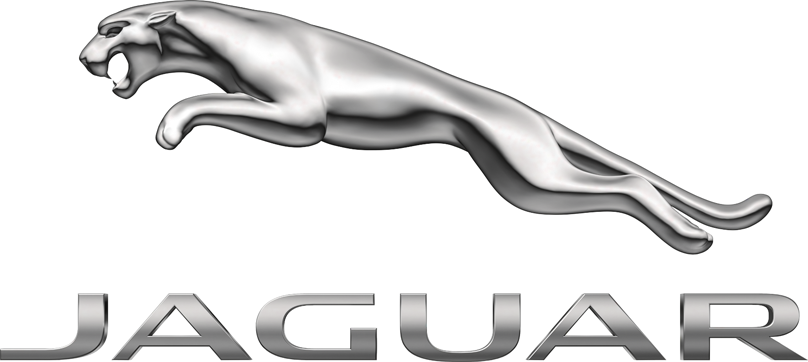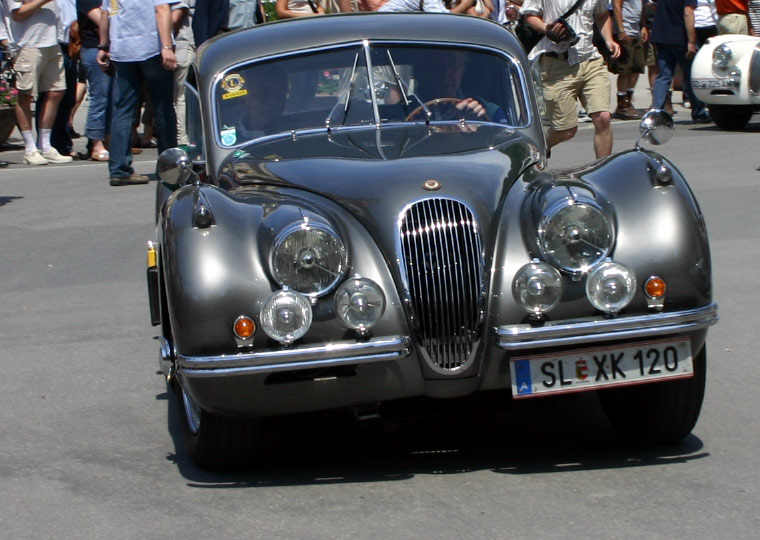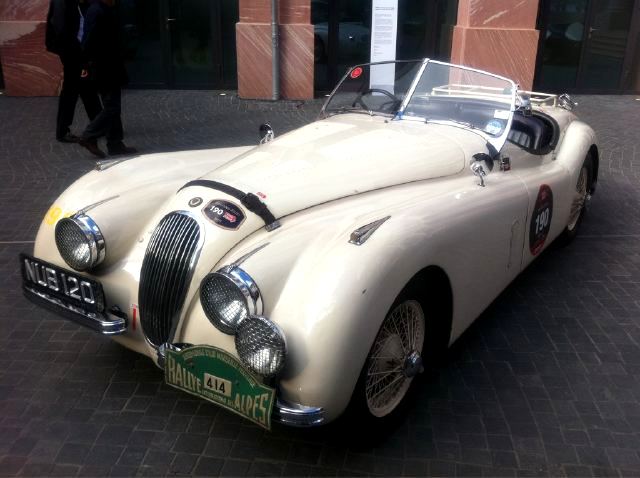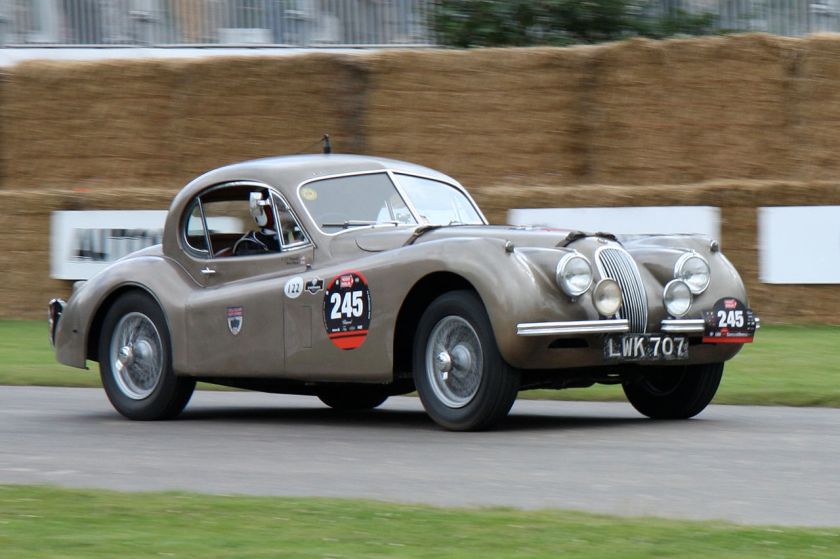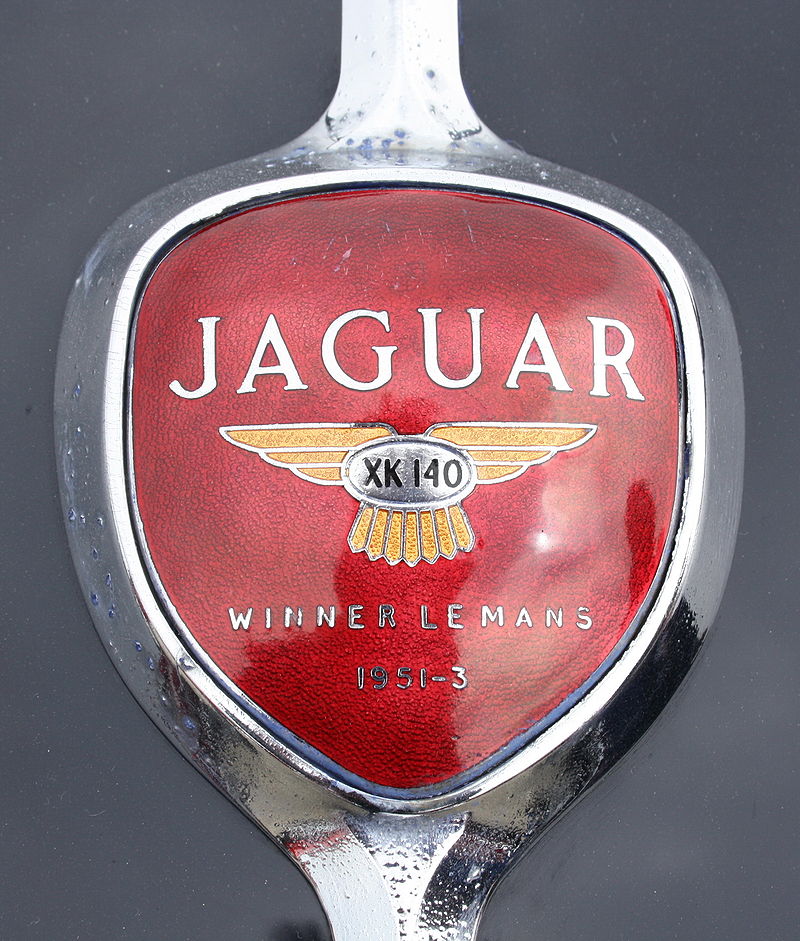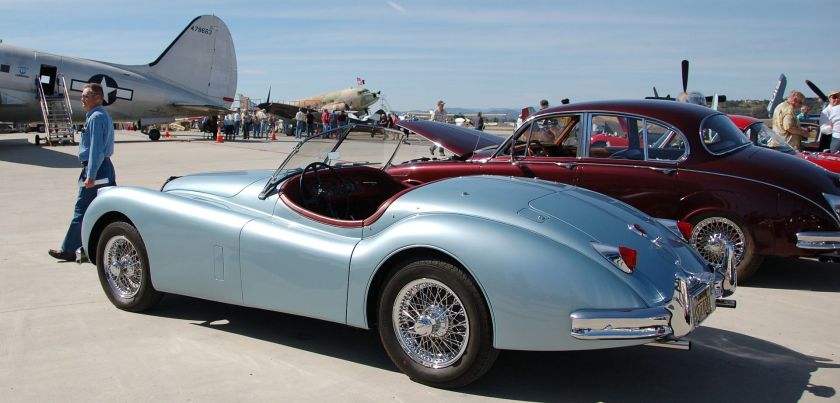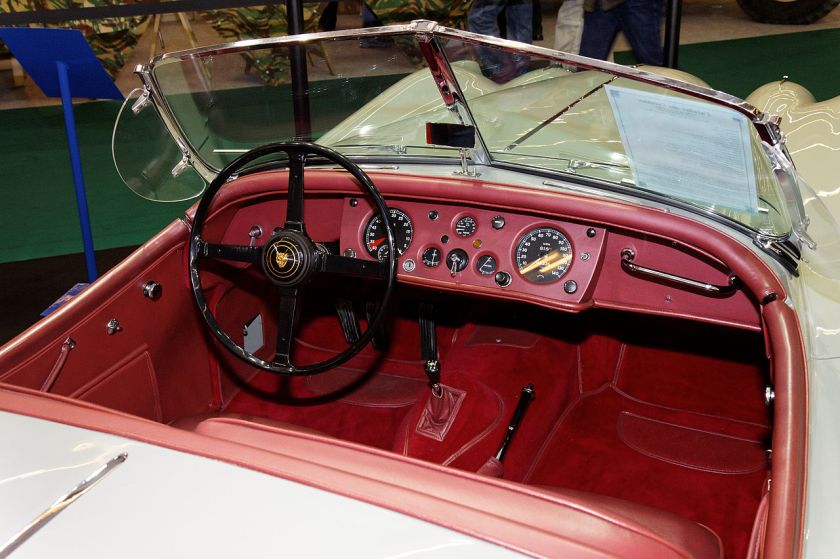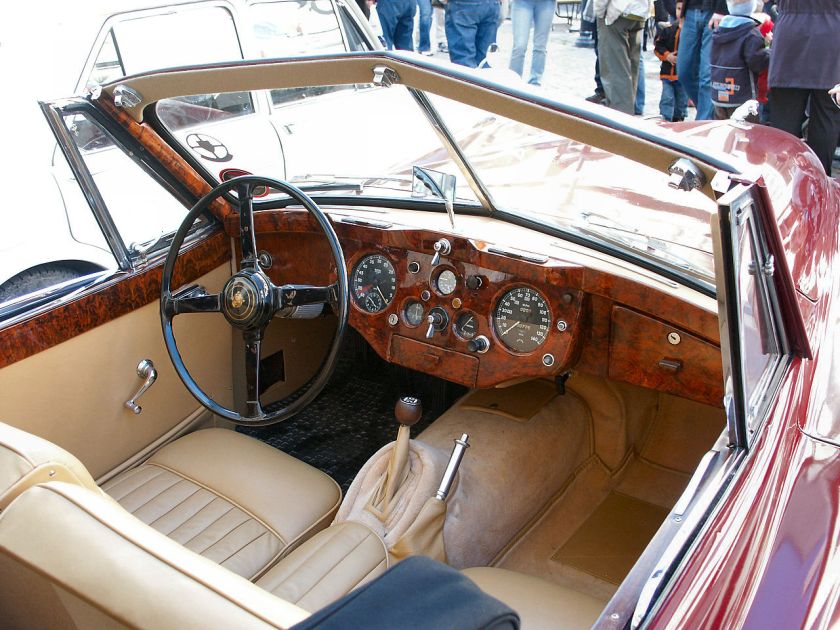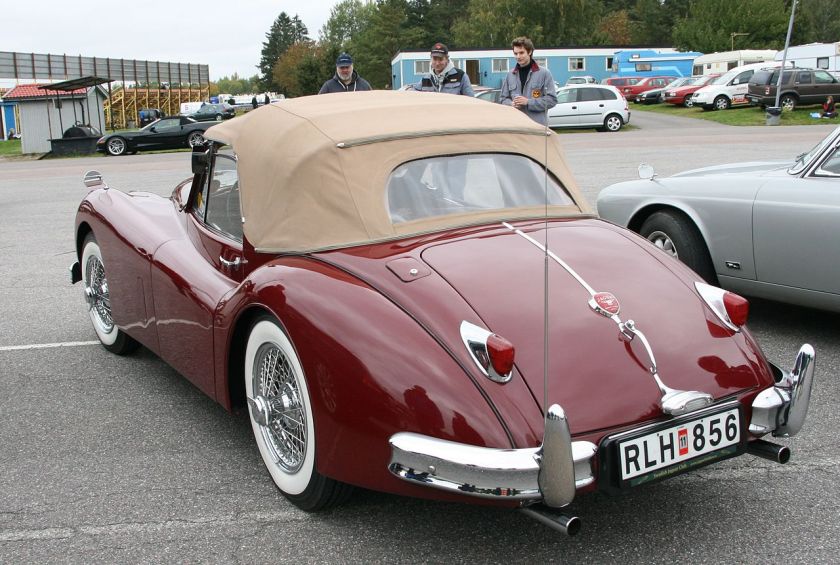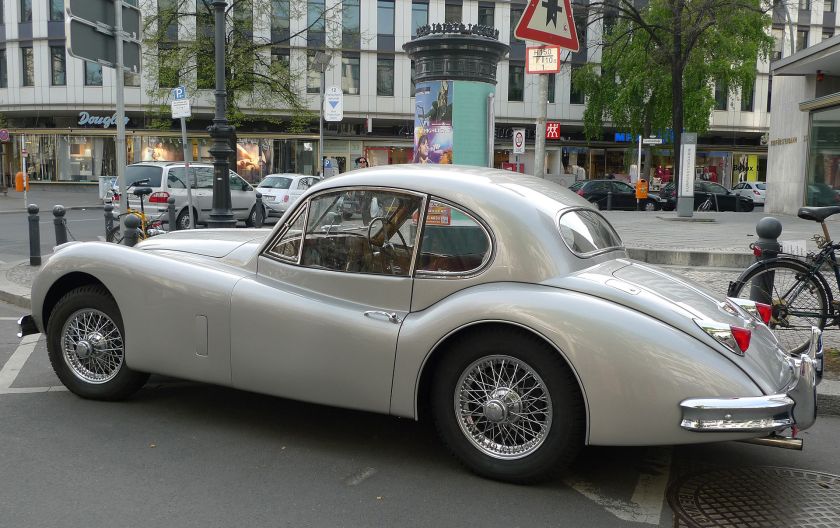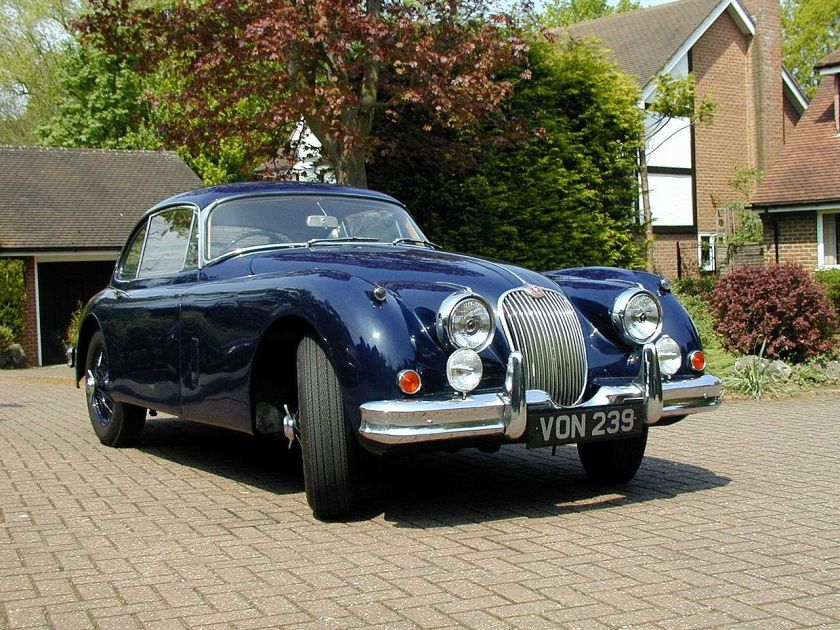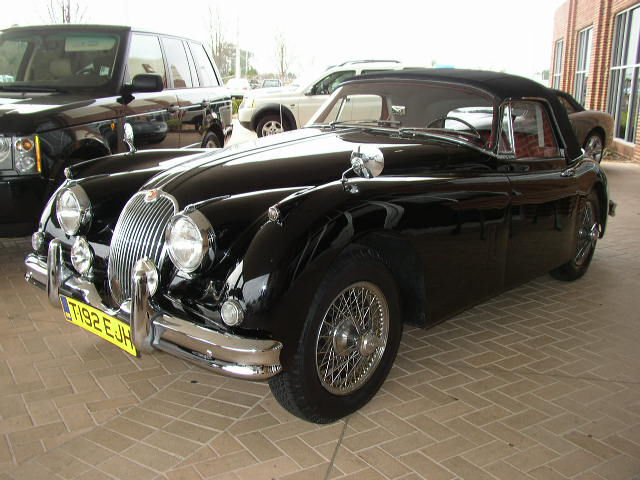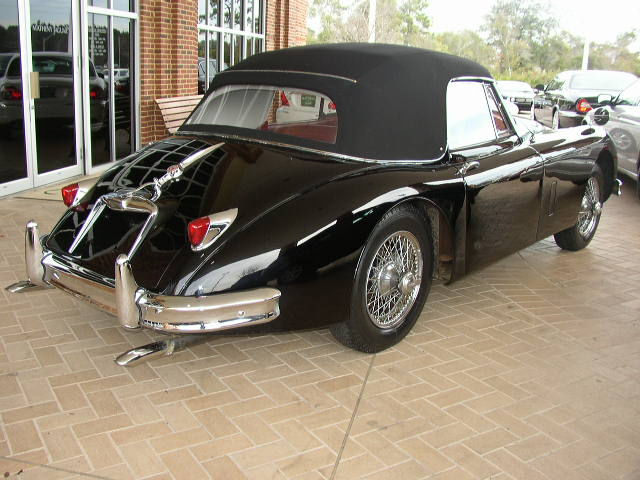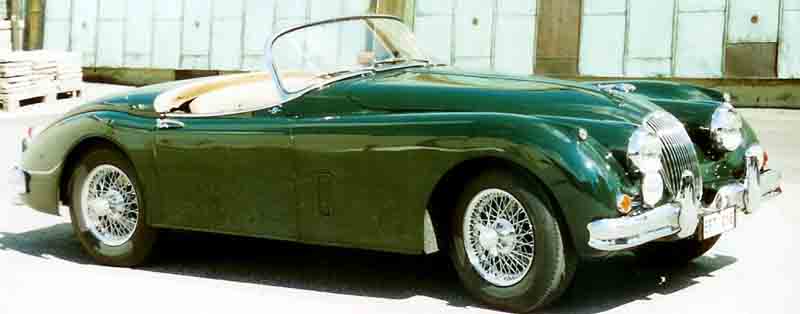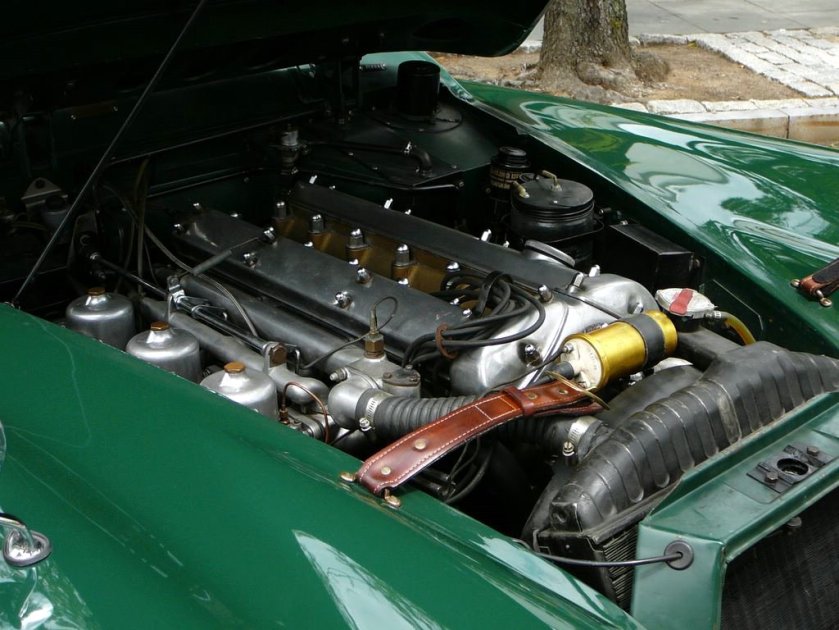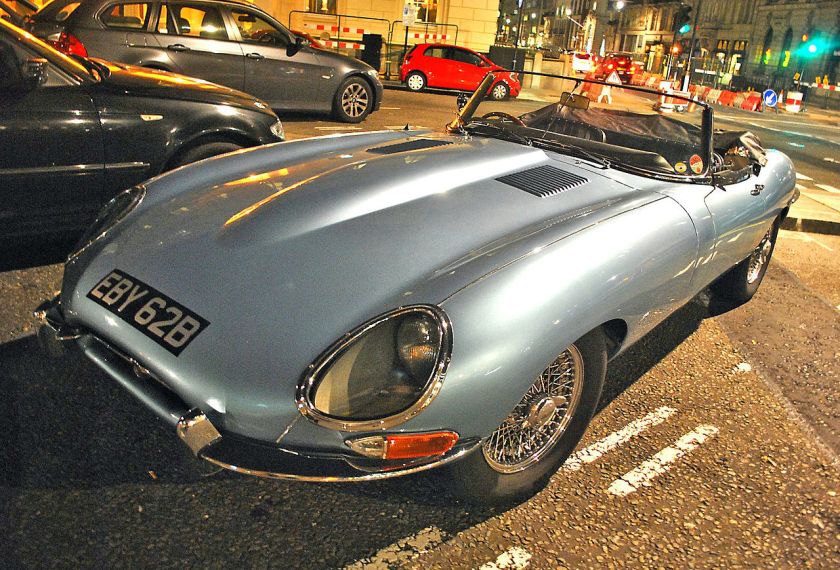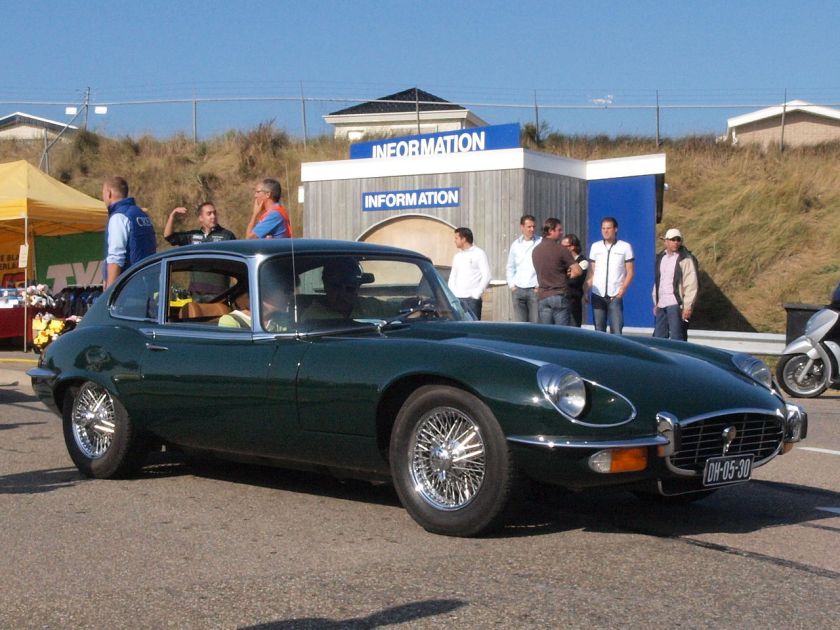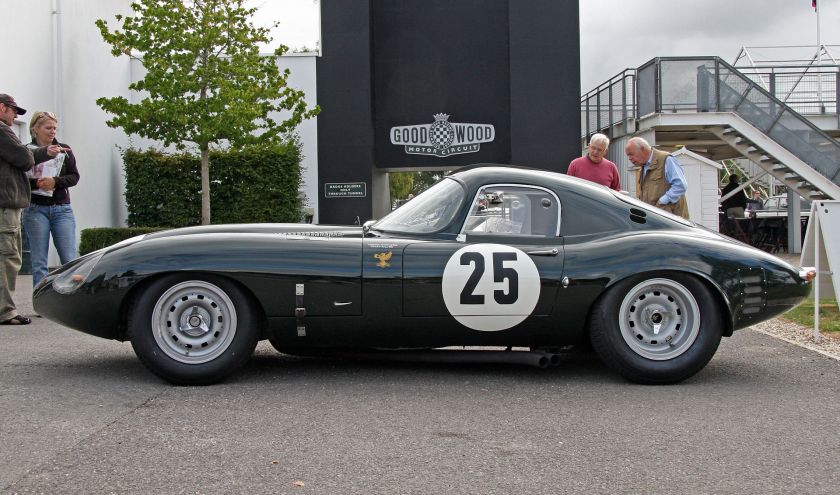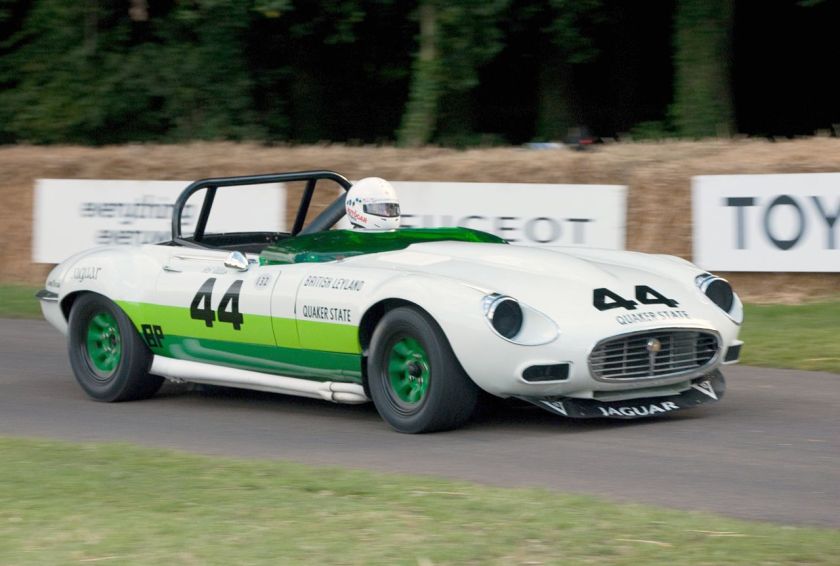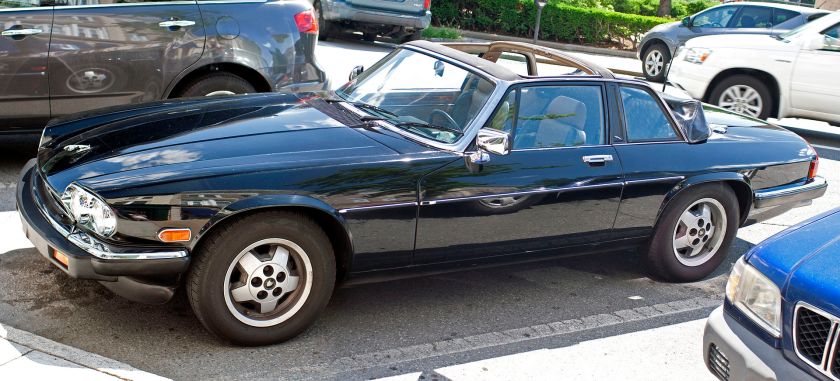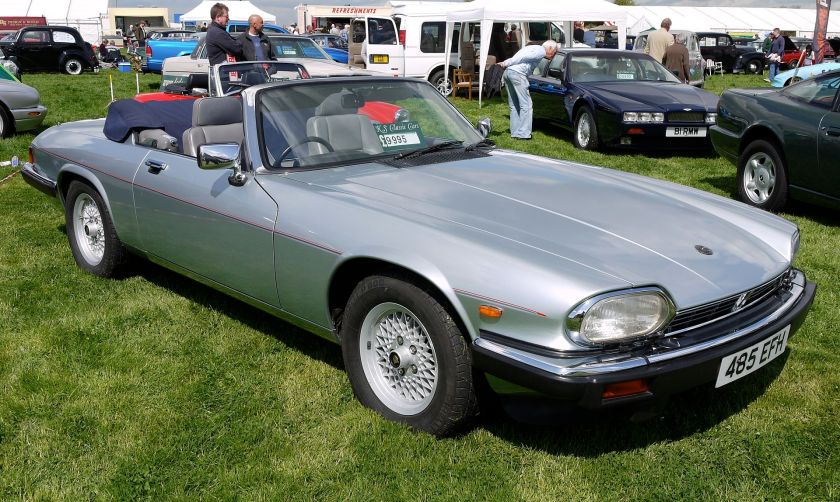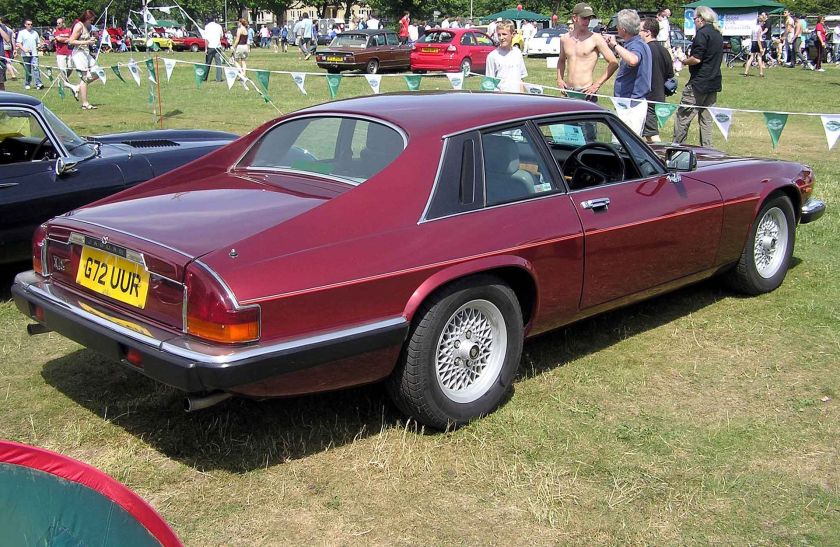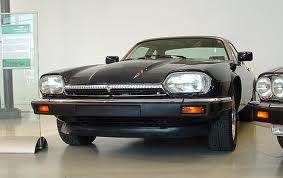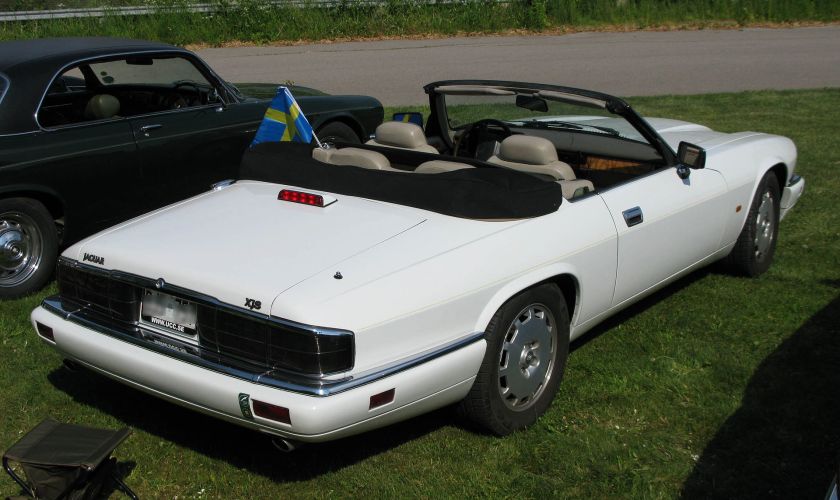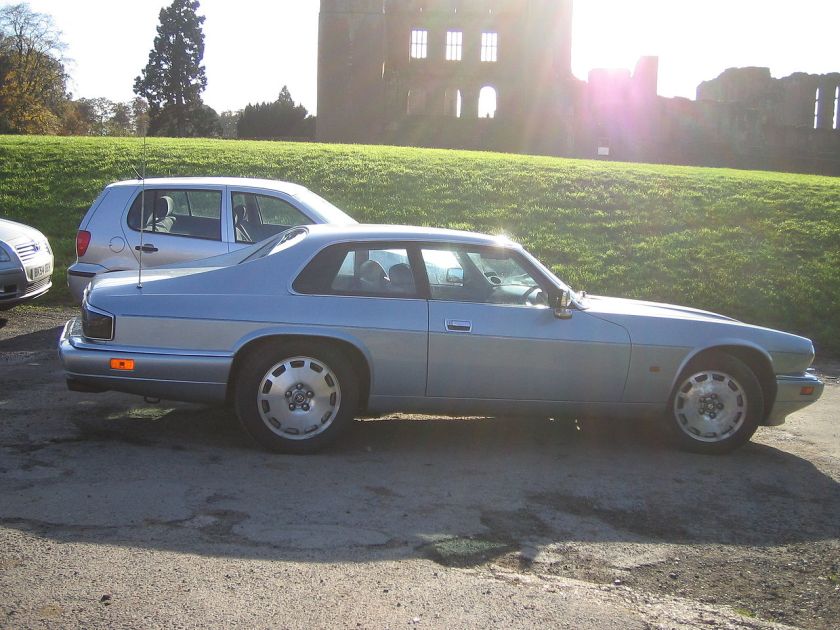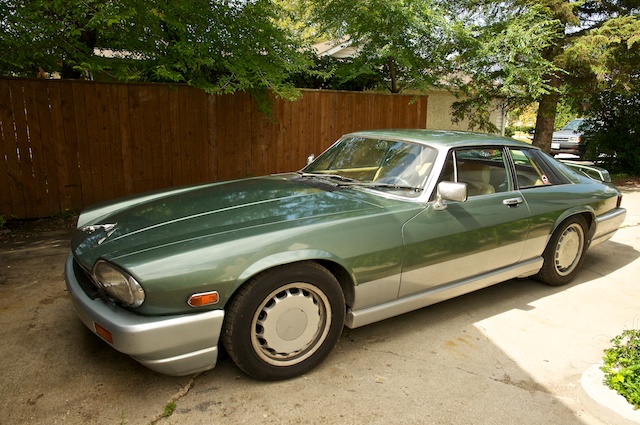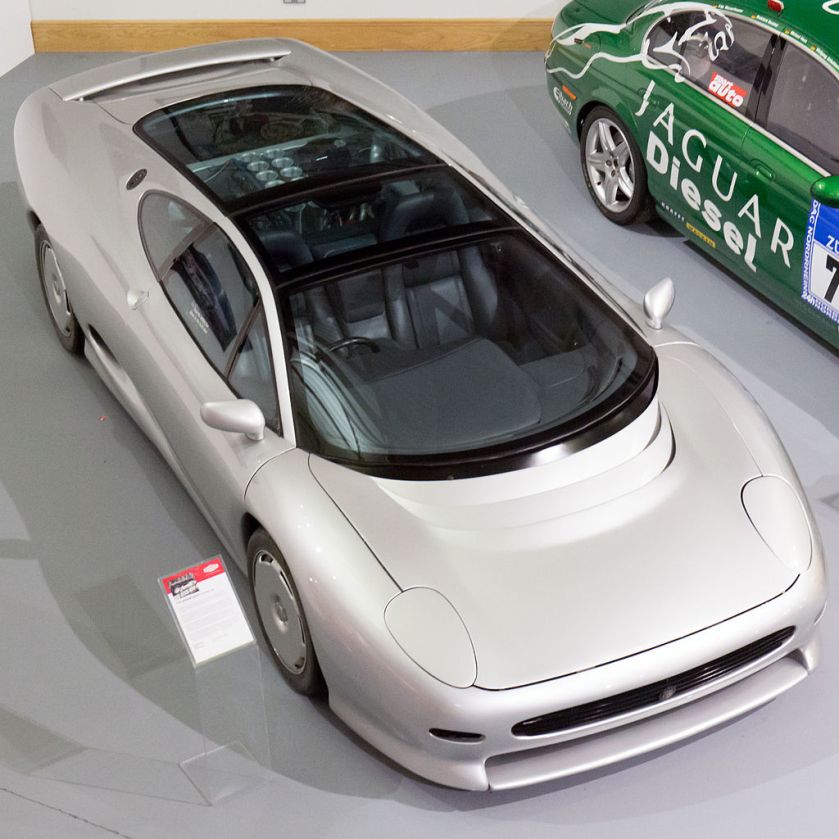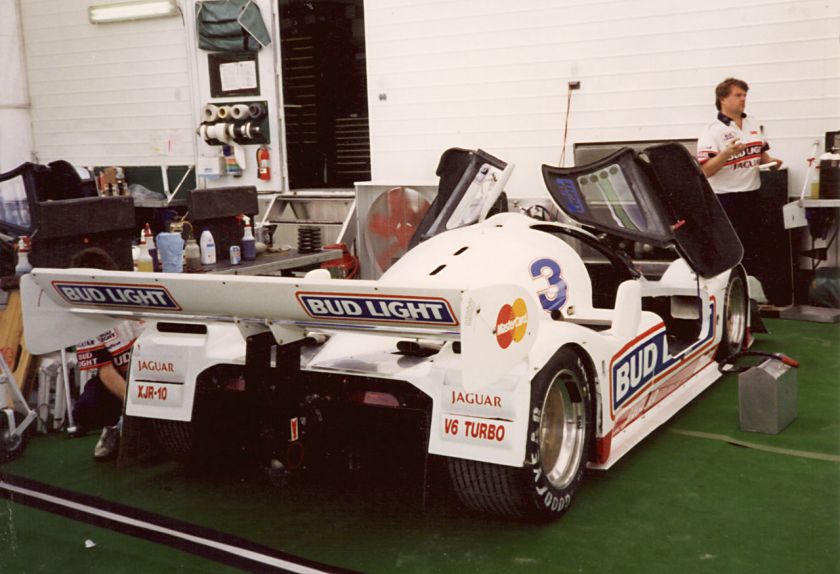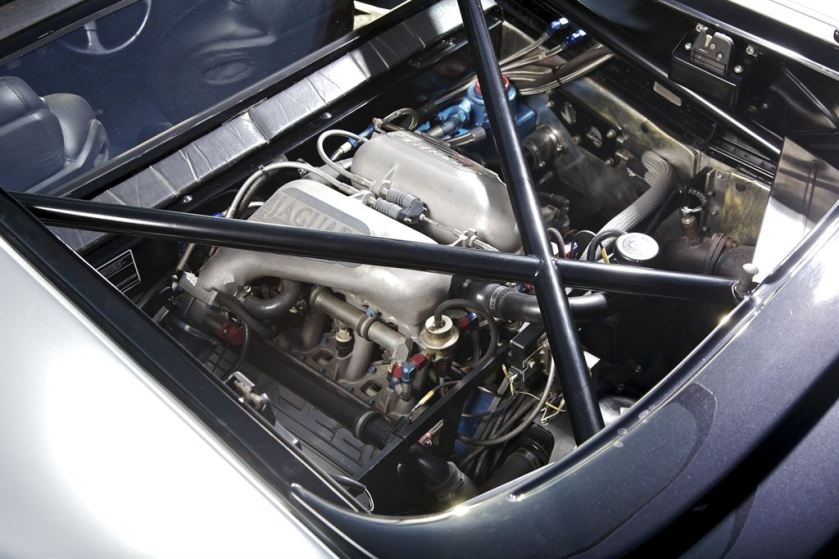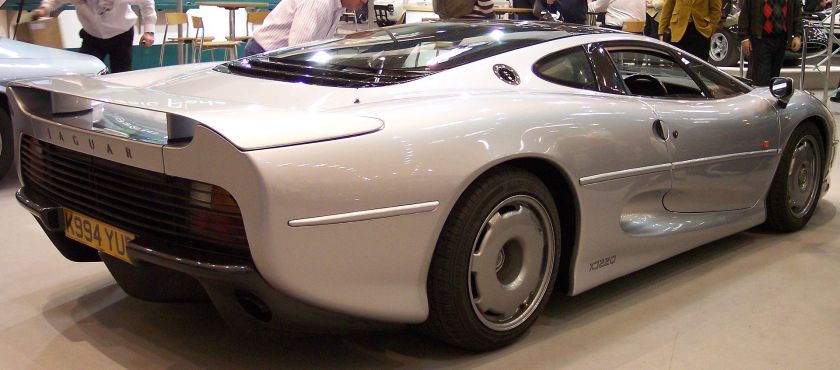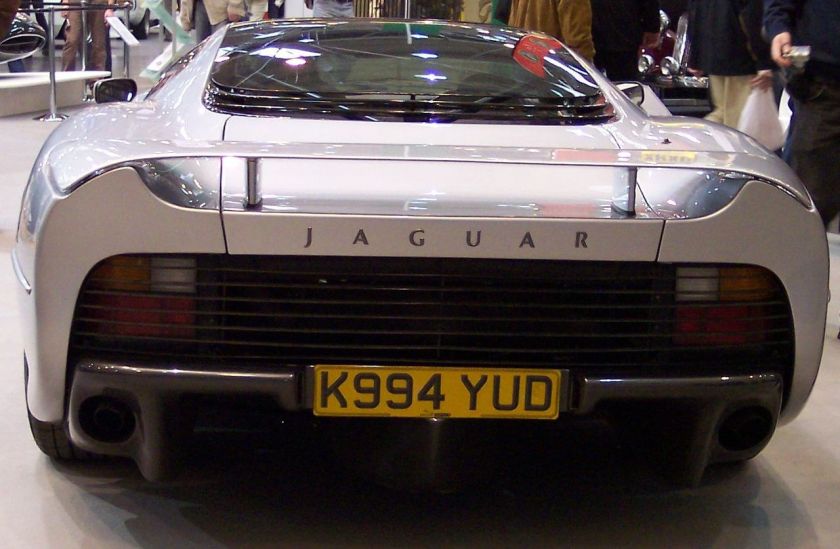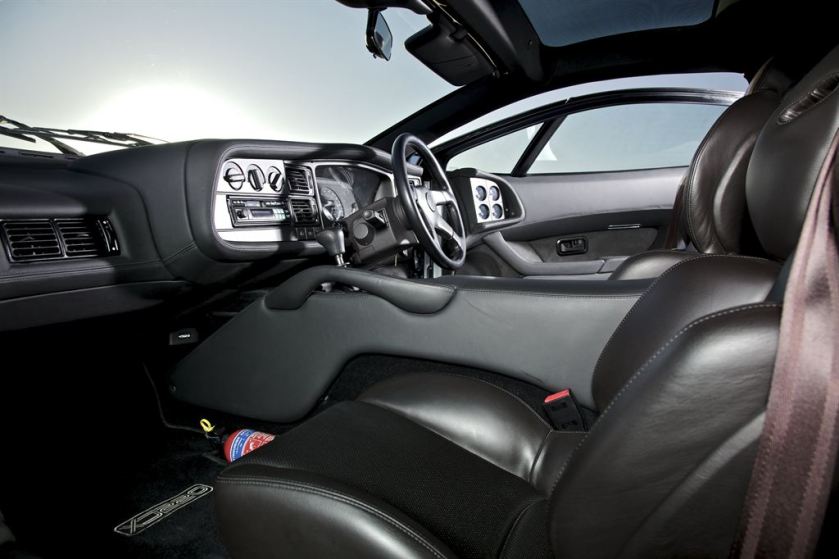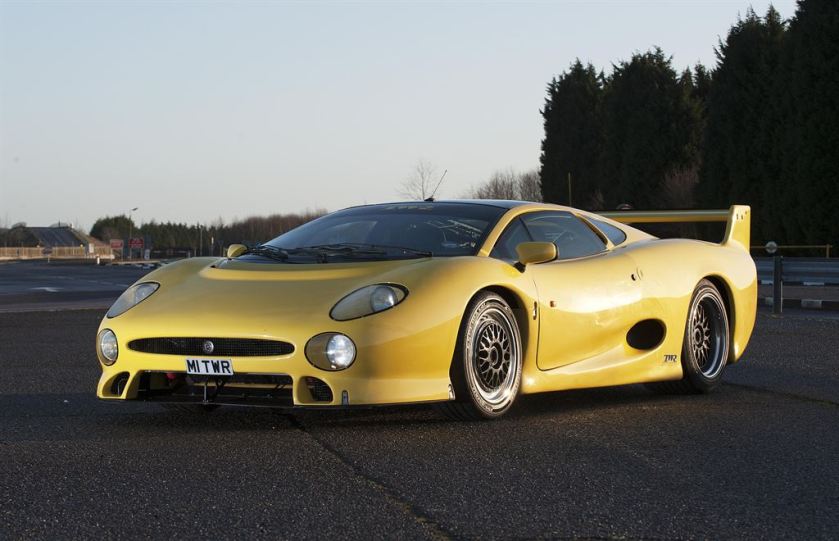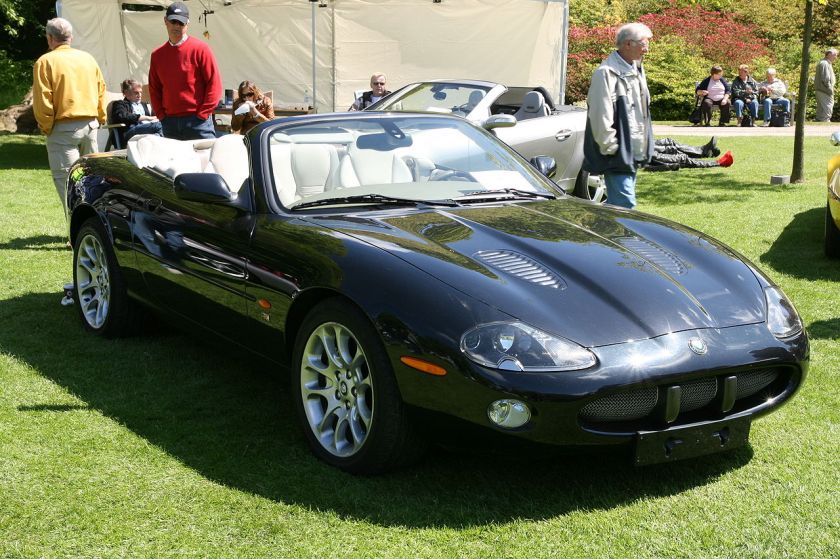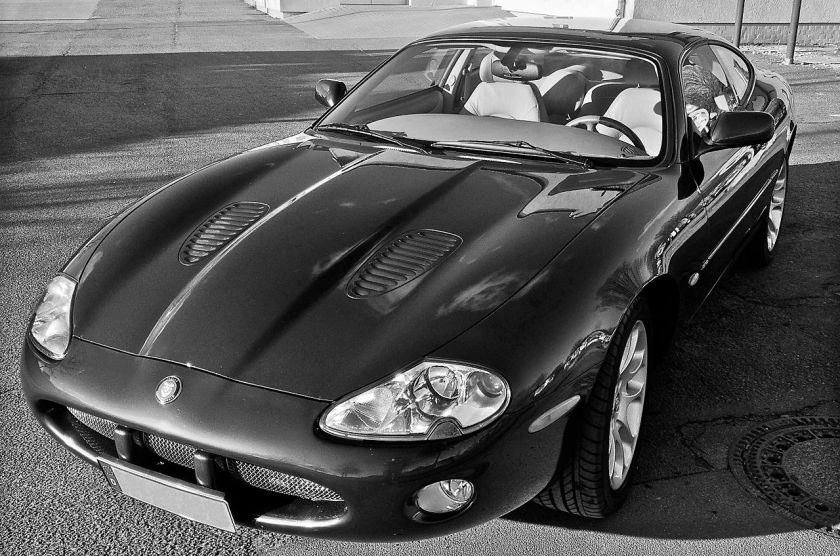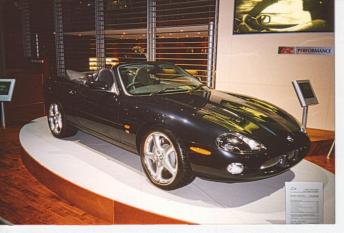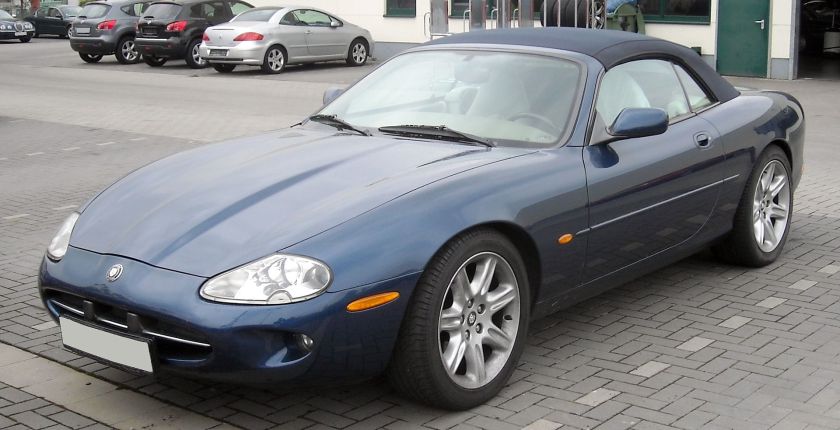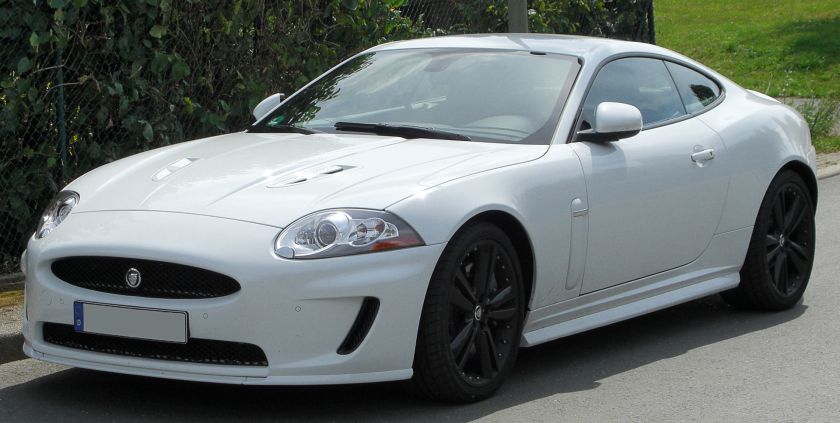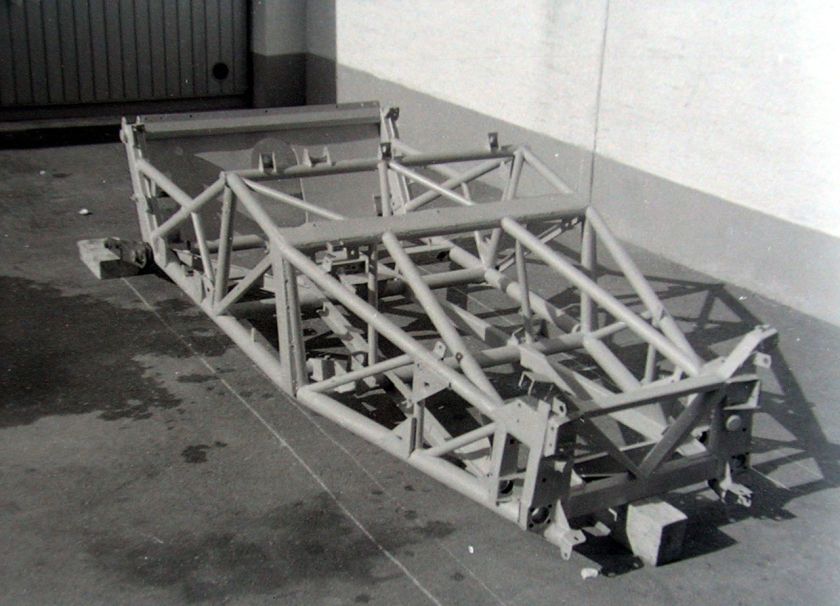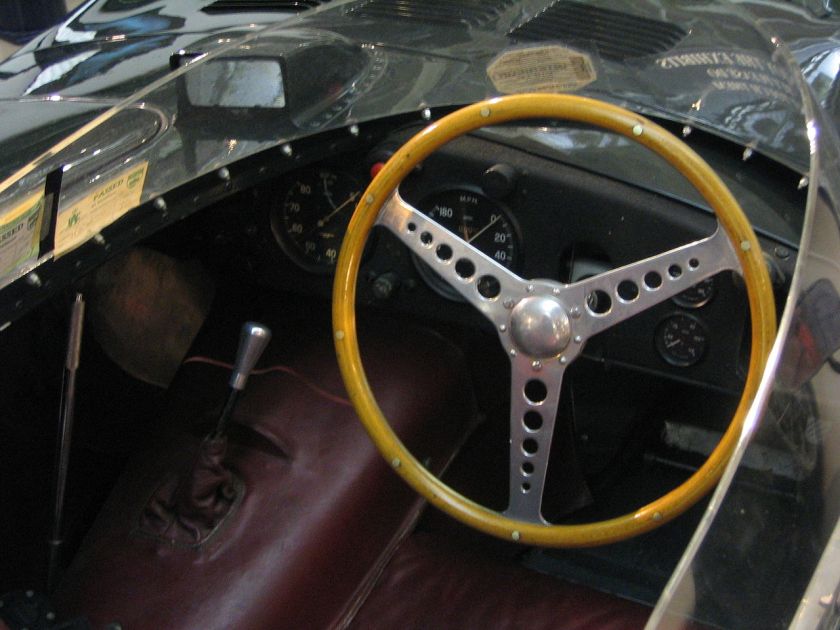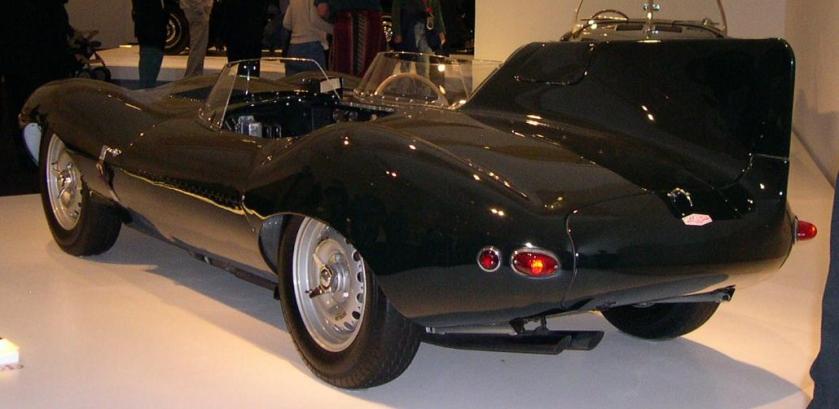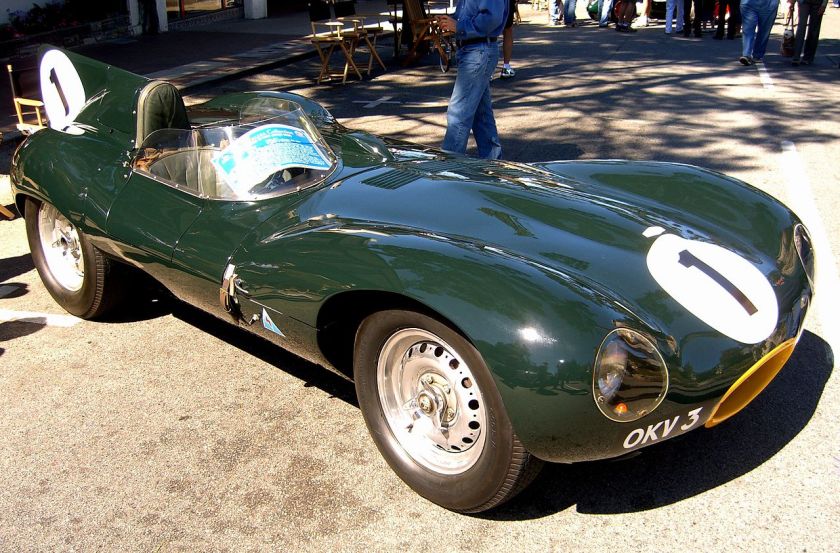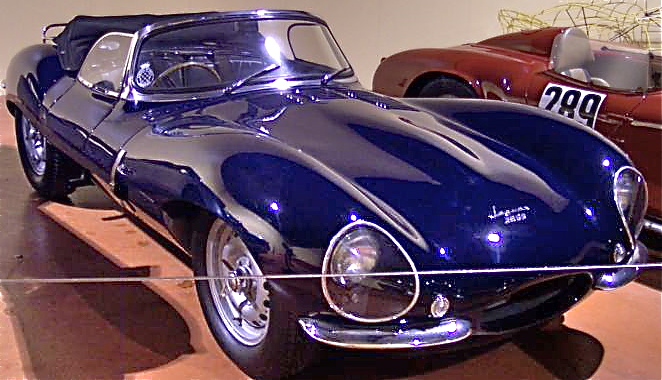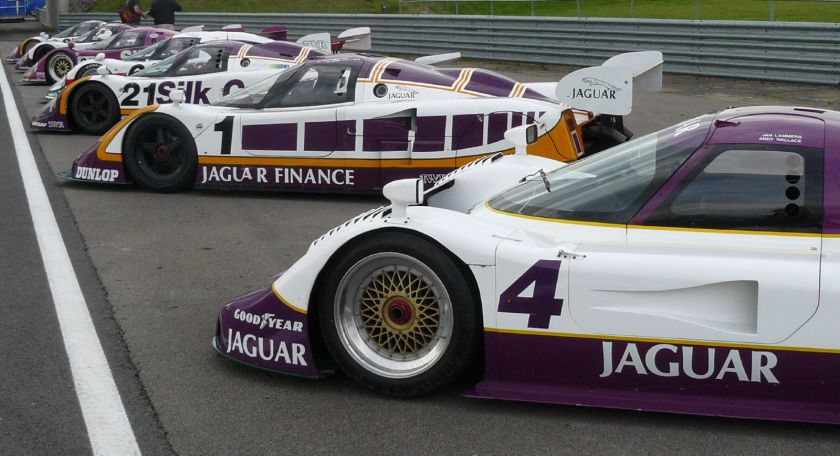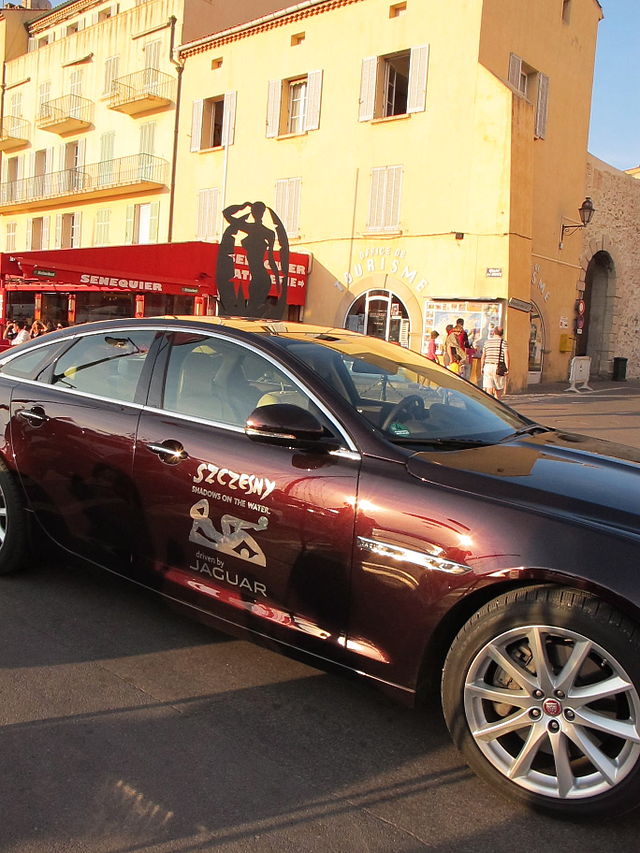JAGUAR Cars
Whitley, Coventry, England, UK at start now from Tata Motors India III
- Jaguar XK120
- fastest production car in the world in 1949
- 1948–1954 XK120
Jaguar XK120
| Jaguar XK120 | |
|---|---|
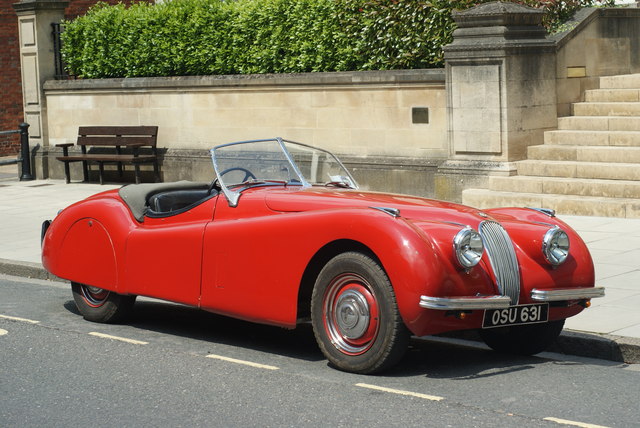
Jaguar XK120 Drop Head Coupe
|
|
| Overview | |
| Manufacturer | Jaguar Cars |
| Production | 1948–1954 12,055 made |
| Assembly | Holbrook Lane, Coventry, England,United Kingdom (1948-1951) Browns Lane, Coventry, England,United Kingdom (1951-54) |
| Body and chassis | |
| Class | Sports car |
| Body style | 2-seat roadster (OTS) 2-seat coupé 2-seat drophead coupé |
| Layout | FR layout |
| Related | Jaguar C-Type |
| Powertrain | |
| Engine | 3.4 L XK I6 |
| Dimensions | |
| Wheelbase | 102 in (2,591 mm) |
| Length | 173 in (4,394 mm) |
| Width | 61.5 in (1,562 mm) |
| Height | 52.5 in (1,334 mm) |
| Chronology | |
| Predecessor | Jaguar SS100 |
| Successor | Jaguar XK140 |
The Jaguar XK120 is a sports car which was manufactured by Jaguar between 1948 and 1954. It was Jaguar’s first sports car since the SS 100, which ceased production in 1940.
History
The XK120 was launched in open two-seater or (US) roadster form at the 1948 London Motor Show as a testbed and show car for the new Jaguar XK engine. The display car was the first prototype, chassis number 670001. It looked almost identical to the production cars except that the straight outer pillars of its windscreen would be curved on the production version. The roadster caused a sensation, which persuaded Jaguar founder and design boss William Lyons to put it into production.
Beginning in 1948, the first 242 cars wore wood-framed open 2-seater bodies with aluminium panels. Production switched to the 1cwt or 112 lb (51 kg) heavier all-steel in early 1950. The “120” in the name referred to the aluminium car’s 120 mph (193 km/h) top speed (faster with the windscreen removed), which made it the world’s fastest production car at the time of its launch. In 1949 the first production roadster, chassis number 670003, was delivered to Clark Gable.
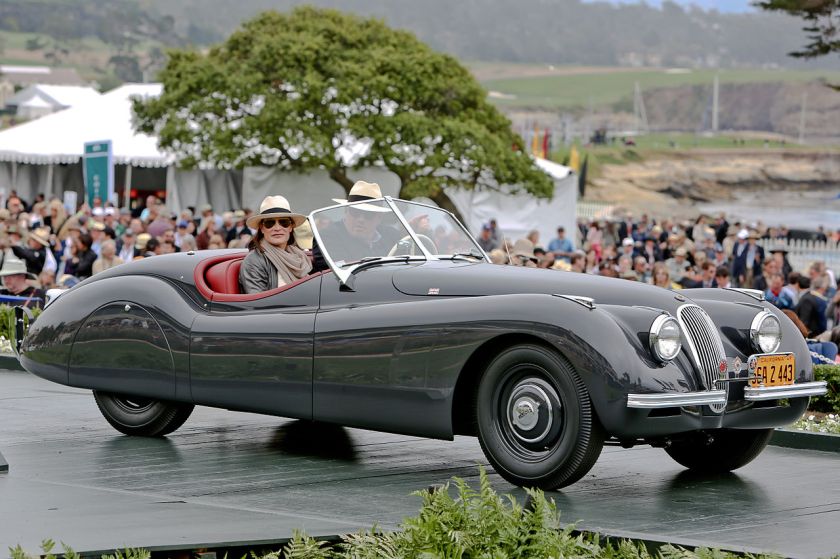
The ex-Clark Gable XK120 at the 2012 Pebble Beach Concours d’Elegance
The XK120 was ultimately available in two open versions, first as an open 2-seater described in the US market as the roadster (and designated OTS, for open two-seater, in America), then also as a drophead coupé (DHC) from 1953; and also as a closed, or fixed head coupé (FHC) from 1951.
A smaller-engined version 2-litres, 4 cylinders, intended for the UK market was cancelled prior to production.
On 30 May 1949, on the empty Ostend-Jabbeke motorway in Belgium, a prototype XK120 timed by the officials of the Royal Automobile Club of Belgium achieved an average of runs in opposing directions of 132.6 mph with the windscreen replaced by just one small aeroscreen and a catalogued alternative top gear ratio, and 135 mph with a passenger-side tonneau cover in place. In 1950 and 1951, at a banked oval track in France, XK120 roadsters averaged over 100 mph for 24 hours and over 130 mph for an hour, and in 1952 a fixed-head coupé took numerous world records for speed and distance when it averaged 100 mph for a week.
Roadsters were also successful in racing and rallying.
Construction
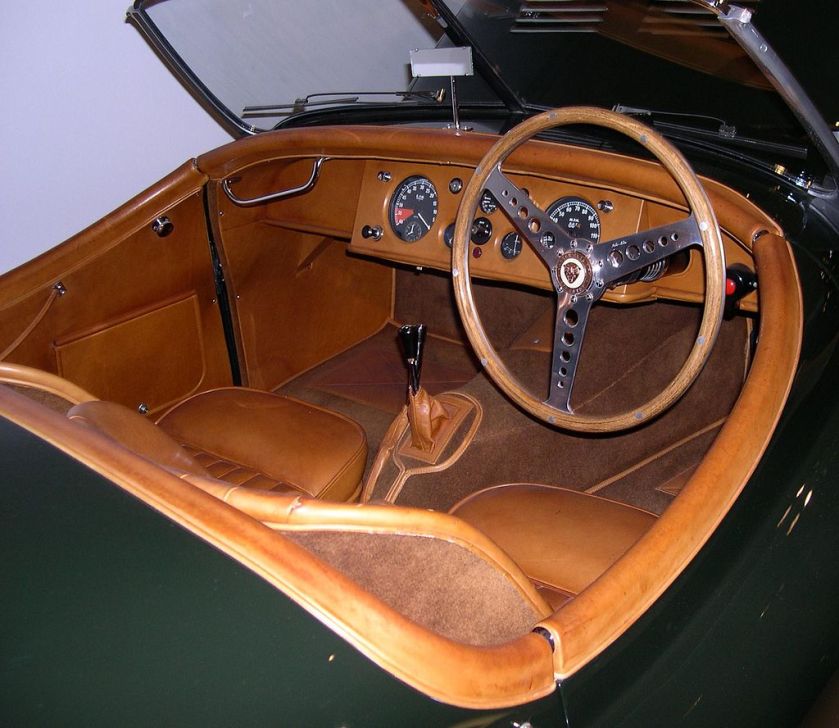
1950 aluminium-bodied roadster, ex-Clemente Biondetti, has competition seats and aftermarket steering wheel; positions of tachometer and speedometer have been reversed
The first roadsters, hand-built with aluminium bodies on ash frames mounted on modified Jaguar Mark V chassis, were constructed between late 1948 and early 1950. To meet demand, and beginning with the 1950 model year, all subsequent XK120s were mass-produced with pressed-steel bodies. They retained aluminium doors, bonnet, and boot lid. The DHC and FHC versions, more luxuriously appointed than the roadsters, had wind-up windows and also wood veneers on the dashboard and interior door caps.
With alloy cylinder head, hemi-spherical combustion chambers, inclined valves and twin side-draft SU carburetors, the dual overhead-cam 3.4 L straight-6 XK engine was comparatively advanced for a mass-produced unit of the time. With standard 8:1 compression ratio it developed 160 bhp (119 kW), using 80 octane fuel. Most of the early cars were exported; a 7:1 low-compression version, with consequently reduced performance, was reserved for the UK market, where the post-war austerity measures then in force restricted buyers to 70 octane “Pool petrol”. The Jaguar factory, with access to 80 octane fuel, provided roadsters with the higher compression ratio to the press. Journalists could then test the model’s optimum performance in Belgium, on a long, straight stretch of road between Jabbeke and Ostend. The XK engine’s basic design, later modified into 3.8 and 4.2 litre versions, survived into the late 1980s.
All XK120s had independent torsion bar front suspension, semi-elliptic leaf springs at the rear, recirculating ball steering, telescopically adjustable steering column, and all-round 12 inch drum brakes that were prone to fade. Some cars were fitted with Alfin (ALuminium FINned) brake drums to help overcome the fade.
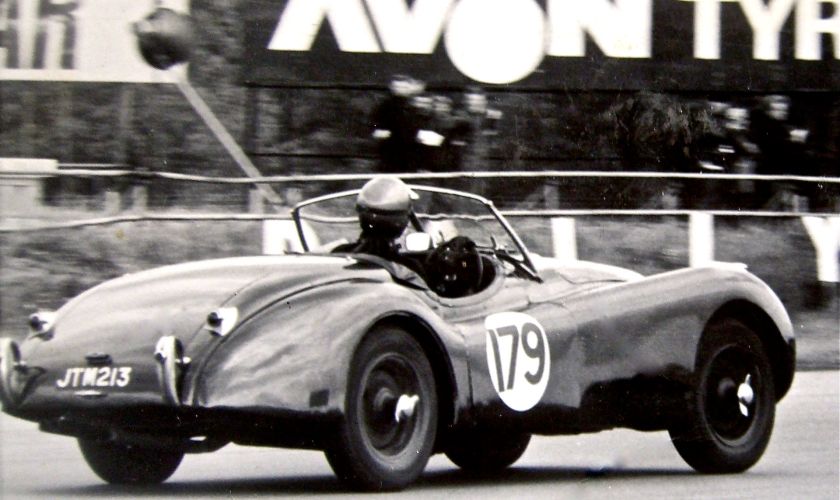
1951 XK120 roadster racing at Silverstone has a single aeroscreen mounted behind the removable full-width windscreen
The roadster’s lightweight canvas top and detachable sidescreens stowed out of sight behind the seats, and its barchetta-style doors had no external handles; instead there was an interior pull-cord which was accessible through a flap in the sidescreens when the weather equipment was in place. The windscreen could be removed for aeroscreens to be fitted.
The drophead coupé (DHC) had a padded, lined canvas top, which folded onto the rear deck behind the seats when retracted, and roll-up windows with opening quarter lights. The flat glass two-piece windscreen was set in a steel frame that was integrated with the body and painted the same colour.
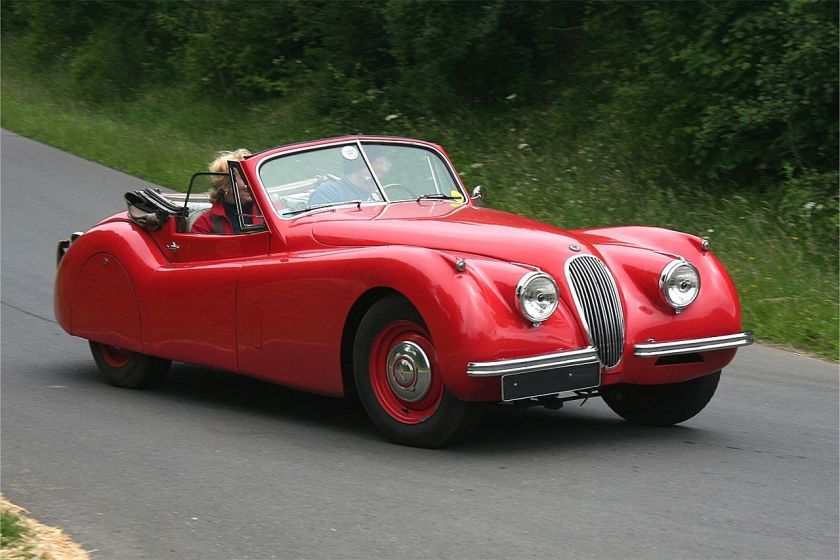
XK120 drophead coupé
Dashboards and door-caps in both the DHC and the closed coupé (FHC) were wood-veneered, whereas the more spartan roadsters were leather-trimmed. All models had removable spats (“fender skirts” in America) covering the rear wheel arches, which enhanced the streamlined look. On cars fitted with optional centre-lock wire wheels (available from 1951), the spats were omitted as they gave insufficient clearance for the chromed, two-eared Rudge-Whitworth knockoff hubs. Chromium plated wire wheels were optional from 1953. When leaving the factory it originally fitted 6.00 × 16 inch cross ply tyres on 16 × 5K solid wheels (Pre–1951). Later cars could also specify 185VR16 Pirelli Cinturato tyres as a radial option.
In addition to wire wheels, upgrades on the Special Equipment, or SE, version (called the M version in the United States) included increased power, stiffer suspension and dual exhaust system.
Performance
The Motor magazine road-tested an XK120 roadster in November 1949. This pre-production car, chassis number 670001, road-registered as HKV 455, was the first prototype built. It was also the 1948 London Motor Show display model, and had been driven by Prince Bira in the 1949 Silverstone Production Car Race. When tested, it had the 8:1 compression ratio, was fitted with an undertray, and ran with hood and sidescreens in place. The magazine reported a top speed of 124.6 mph (200.5 km/h), acceleration from 0–60 mph (97 km/h) in 10.0 seconds and fuel consumption of 19.8 miles per imperial gallon (14.3 L/100 km; 16.5 mpg-US). The car as tested cost £1263 including taxes.
Racing and rallying
XK120s were active in racing and rallying:
1949
- First race victory: In the Daily Express-sponsored One-Hour Production Car Race held on 30 August 1949 at Silverstone Circuit, England, Leslie Johnson drove the Jabbeke car to the XK120’s first-ever race victory (despite an early collision with a spinning Jowett Javelin which dropped the Jaguar to fifth). The car, road-registered HKV 500, was converted to right-hand drive for Silverstone. Two other XK120s took part. One, driven by Peter Walker, finished second and the other, driven by Prince Bira, spun out of contention when a tyre punctured.
1950
- First victory in America: In January 1950 Johnson also scored the model’s first competition success in America, winning the production class in a race at Palm Beach Shores, Florida with the car that had finished second at Silverstone. The Jaguar lost its brakes but finished fourth overall. John Lea, Jaguar’s Experimental Department mechanic who attended the race, reported: “The conditions at Palm Beach were wet, windy and sandy. Water and sand gained entry into the brake drums at the front, and the mixture had the effect of accelerating the wear very considerably. Our car finished with no linings and with the steel shoes bearing on the brake drums.”
- Pebble Beach Cup: In May, XK120s driven by Phil Hill and Don Parkinson finished first and second in this event at the inaugural Pebble Beach Road Races in 1950.
In 1950 Jaguar allocated six alloy-bodied XK120s to drivers Johnson, Walker, Nick Haines, Clemente Biondetti, Ian Appleyard and Tommy Wisdom.
- Le Mans: Three of the allocated cars, extensively modified, entered the 1950 Le Mans 24 Hours race. Johnson, who spearheaded this factory-supported assault on the race with co-driver Bert Hadley, never ran lower than seventh place, and held second for two hours, but in the 21st hour had to retire from third place with clutch failure caused by using the gears to slow the car in the absence of brakes. (As a result the clutch was revised to a more robust design for production models.) The Jaguar had been closing the gap to leader Louis Rosier, whose Talbot’s pace was significantly slower, at a rate that would have secured victory. Haines, with co-driver Peter Clark, finished 12th, and Walker’s car, driven by Peter Whitehead and John Marshall, was 15th. The results convinced William Lyons it was worth investing in future success at Le Mans.
- Targa Florio: Biondetti’s car, the first XK120 to contest the Targa Florio, lay second to Alberto Ascari’s Ferrari when a connecting rod broke, ending the Jaguar’s run.
- Mille Miglia: Johnson took fifth place in the Mille Miglia, with John Lea as his riding mechanic, while Biondetti and co-driver Gino Bronzoni finished eighth. Fifth was an outstanding achievement for a production car, with Johnson’s Jaguar beaten only by Fangio‘s works Alfa Romeo and the works Ferraris of Serafini, Bracco and winner Marzotto. It was Jaguar’s best-ever finish in the Mille Miglia; also the best by a British car and driver combination, a feat that only Reg Parnell ever equalled, driving an Aston Martin DB3 in 1953.
- Silverstone Production Car Race: Five XK120s entered the race, which Peter Walker won from Tony Rolt, with Johnson recovering to eighth after spinning on oil. Jaguar won the team prize.
- Tourist Trophy: XK120s also achieved a 1–2–3 victory in the TT, held at Dundrod in heavy rain. On the eve of his 21st birthday Stirling Moss drove Tom Wisdom’s car to a brilliant win ahead of Whitehead and Johnson, and Jaguar once again took the team prize.
- Alpine Rally: Ian Appleyard’s XK120, road-registered as NUB 120, won the Alpine Rally with his wife Pat, who was the daughter of Sir William Lyons, navigating. They also won a coveted Coupe des Alpes.
1951
- Alpine Rally: NUB 120 and the Appleyards repeated their previous year’s success.
- Tulip Rally: The Appleyards took first place in the Tulip Rally, with Swiss fighter pilot Rolf Habisreutinger’s XK120 finishing second.
1952
- Alpine Rally: Although the Appleyards’ XK120 did not win its third Alpine, it completed the rally without incurring a single penalty point, winning the first-ever Coupe d’Or (Gold Cup).
1954
- Mount Druitt 24 Hours Road Race: On 1 February 1954, an XK120 FHC driven by Geordie Anderson, Chas Swinburne and Bill Pitt won Australia‘s first 24-hour motor race, the 1954 Mount Druitt 24 Hours Road Racefrom a Bristol 400 and a Humber Super Snipe.
- NASCAR road race: In America, an XK120 FHC was the first imported car to achieve victory in NASCAR, when Al Keller won the first NASCAR road race, held at Linden Airport, New Jersey, on 13 June 1954.
High-speed runs and records
1949
- 132.596 mph (213.393 km/h) through the flying mile: in May, Jaguar demonstrated an XK120 roadster to the press on the high-speed autoroute between Jabbeke and Aeltre in Belgium. The road was closed for the occasion. The white left-hand drive car, chassis number 670002, was the second XK120 built. Jaguar’s development engineer Walter Hassan was to have driven but fell ill, so Jaguar test-driver Ron “Soapy” Sutton substituted. With hood and sidescreens erected, and the airflow under the car improved by the addition of a full-length aluminium undertray, the Jaguar was timed through the flying mile by the Royal Automobile Club of Belgium at 126.448 mph (203.498 km/h). With hood, sidescreens and windscreen removed, a metal airflow deflector fitted in front of the driver, and a tonneau cover fastened over the passenger side of the cockpit the speed improved to 132.596 mph (213.393 km/h). The Observer’s Book of Automobiles said it was the fastest production car in the world.
1950
- 107.46 mph (172.94 km/h) for 24 hours (including stops for fuel and tyres): Leslie Johnson sharing his XK120 roadster, road-registered JWK 651, with Stirling Moss at the Autodrome de Montlhéry, a steeply banked oval track near Paris. The first time a production car had averaged over 100 mph (160.93 km/h) for 24 hours. Changing drivers every three hours, the Jaguar covered 2579.16 miles, with a best lap of 126.2 mph (203.10 km/h).
1951
- 131.83 mi (212.16 km) for one hour: Johnson solo in JWK 651 at Montlhéry. “No mean feat…driving at almost twice today’s maximum (UK) speed limit into a steep turn, assaulted by the G-Force induced by 30 degree banking twice every minute, using Forties technology, leaf spring suspension and narrow crossply tyres…Johnson remarked that the car felt so good it could have gone on for another week, an off-the-cuff comment that sowed the seed for another idea. Flat out for a week…”
1952
- 100.31 mph (161.43 km/h) for 7 days and 7 nights, again at Montlhéry: XK120 fixed-head coupé driven by Johnson, Moss, Hadley and Jack Fairman. William Lyons, mindful of the considerable kudos and advertising mileage that had already accrued from Johnson’s exploits, commandeered a brand new XK120 FHC for him: bronze-colored, and fitted with wire wheels, it was Jaguar chief engineer Walter Hassan‘s car, the second right-hand drive coupé made. The car broke a spring on the track’s rough concrete surface when already well into the run. No spare was carried, and regulations stipulated that a replacement from outside would make the car ineligible for any further records beyond those already achieved before the repair. Johnson drove nine hours to save the other drivers from added risk while the speed had to be maintained on the broken spring. When he finally stopped to have it replaced, the car had taken the world and Class C 72-hour records at 105.55 mph (169.87 km/h), world and Class C four-day records at 101.17 mph (162.82 km/h), Class C 10,000-kilometer record at 107.031 mph (172.250 km/h), world and Class C 15,000-kilometer records at 101.95 mph (164.07 km/h), and world and Class C 10,000-mile (16,000 km) records at 100.65 mph (161.98 km/h). After the repair the car went on to complete the full seven days and nights, covering a total of 16,851.73 mi (27,120.23 km) at an average speed of 100.31 mph (161.43 km/h).
Jaguar XK100
A 2-litre four-cylinder version of the twin cam XK engine was to have powered an XK100 variant of the XK120 for the UK market. Details of the model were included in an “Advance Particulars” brochure for the XK but Jaguar’s managers were dissatisfied with the engine and the project was cancelled prior to production.
Note
- Jump up^ The Times, 31 May 1949
Ostend 30 May: British Car’s Speed Record
(extracts)
A Jaguar 3½-litre sports car . . . travelled at a timed speed of 132 mph on the Ostend-Jabbeke motorway today . . . The runs were timed by officials of the Royal Automobile Club of Belgium . . . moreover it was running on normal Belgian pump petrol and at the end of its high speed runs it demonstrated its ability to throttle down to 15 mph in top gear and to accelerate speedily without pinking. Running with the hood up, the car averaged 126.4 mph for a mile in two runs in opposite directions. The fastest mean speed of 132.5 mph was reached with a racing windscreen in place, the best run being made at 133.2 mph. The car also covered a kilometre from a standing start at a speed of 74.1 mph and a mile at 86.4 mph.
- 1954–1957 XK140
Jaguar XK140
| Jaguar XK140 | |
|---|---|
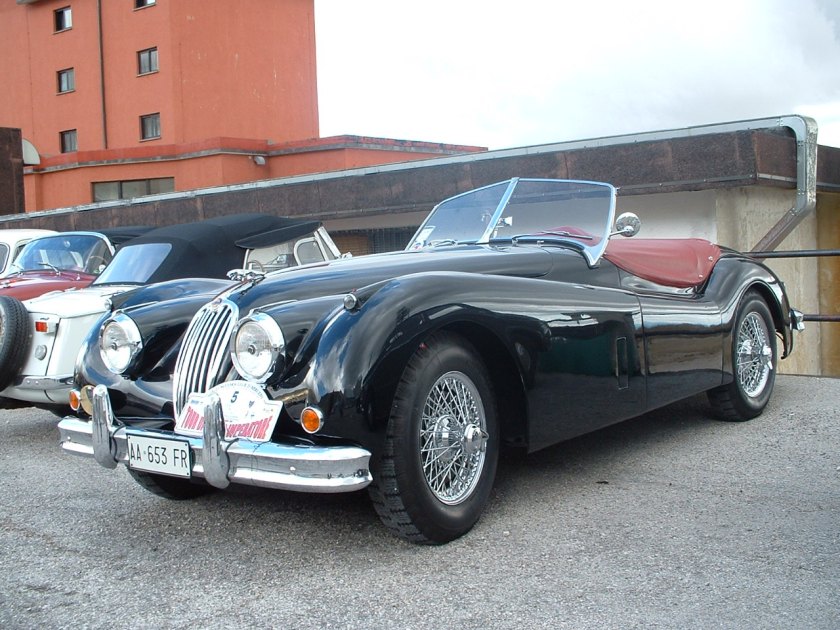
XK140 open two-seater or roadster 1954
|
|
| Overview | |
| Manufacturer | Jaguar Cars |
| Production | 1954–1957 |
| Body and chassis | |
| Class | Sports car |
| Body style | 2-seat roadster 2-seat convertible 2-seat coupé |
| Layout | FR layout |
| Dimensions | |
| Length | 176 in (4,470 mm) |
| Width | 64.5 in (1,638 mm) |
| Curb weight | 3,136–3,248 lb (1,422–1,473 kg) |
| Chronology | |
| Predecessor | Jaguar XK120 |
| Successor | Jaguar XK150 |
The Jaguar XK140 is a sports car manufactured by Jaguar between 1954 and 1957 as the successor to the XK120. Upgrades included more interior space, improved brakes, rack and pinion steering, increased suspension travel, and telescopic shock absorbers instead of the older lever arm design.
History
The XK140 was introduced in late 1954 and sold as a 1955 model. Exterior changes that distinguished it from the XK120 included more substantial front and rear bumpers with overriders, and flashing turn signals (operated by a switch on the dash) above the front bumper.
The grille remained the same size but became a one-piece cast unit with fewer, and broader, vertical bars. The Jaguar badge was incorporated into the grille surround. A chrome trim strip ran along the centre of the bonnet (hood) and boot (trunk) lid. An emblem on the boot lid contained the words “Winner Le Mans 1951–3″.
The interior was made more comfortable for taller drivers by moving the engine, firewall and dash forward to give 3 inches (76 mm) more legroom. Two 6-volt batteries, one in each front wing were fitted to the Fixed Head Coupe, but Drop Heads and the Open Two Seater had a single 12-volt battery. This was installed in the front wing on the passenger side (e.g. In the left wing on right hand drive cars and in the right wing on left hand drive).
The XK140 was powered by the Jaguar XK engine with the Special Equipment modifications from the XK120, which raised the specified power by 10 bhp to 190 bhp (142 kW) gross at 5500 rpm, as standard. The C-Type cylinder head, carried over from the XK120 catalogue, and producing 210 bhp (157 kW) gross at 5750 rpm, was optional equipment.
When fitted with the C-type head, 2-inch sand-cast H8 carburettors, heavier torsion bars and twin exhaust pipes, the car was designated XK140 SE in the UK and XK140 MC in North America.
In 1956 the XK140 became the first Jaguar sports car to be offered with automatic transmission. As with the XK120, wire wheels and dual exhausts were options, and most XK140s imported into the United States had wire wheels. Cars with the standard disc wheels had spats (fender skirts) over the rear wheel opening. When leaving the factory it originally fitted either 6.00 × 16 inch crossply tyres or you could specify 185VR16 Pirelli Cinturato CA67 as a radial option on either 16 × 5K½ solid wheels or 16 × 5K (special equipment) wire wheels.
Body styles
The Roadster (designated OTS – Open Two Seater – in America) had a light canvas top that folded out of sight behind the seats. The interior was trimmed in leather and leatherette, including the dash. Like the XK120 Roadster, the XK140 version had removable canvas and plastic side curtains on light alloy barchetta-type doors, and a tonneau cover. The door tops and scuttle panel were cut back by two inches(50mm) compared to the XK120, to allow a more modern positioning of the steering wheel. The angle of the front face of the doors (A-Post) was changed from 45 degrees to 90 degrees, to make access easier.
The Drophead Coupé (DHC) had a bulkier lined canvas top that lowered onto the body behind the seats, a fixed windscreen integral with the body (the Roadster’s screen was removable), wind-up side windows, and a small rear seat. It also had a walnut-veneered dashboard and door cappings.
The Fixed Head Coupé (FHC) shared the DHC’s interior trim and rear seat. The prototype Fixed Head Coupe retained the XK120 Fixed Head roof-profile, with the front wings and doors the same as the Drophead. In production, the roof was lengthened with the screen being placed further forward, shorter front wings, and longer doors. This resulted in more interior space, and more legroom.
Performance
Realistically, a stock XK-140 SE could achieve a top speed of 120–125 mph (193–201 km/h). Road & Track ’s XK-140 MC test in June 1955 recorded a best two-way average of 120.3 mph (193.6 km/h). Best one-way run was 121.1 mph (194.9 km/h). Sports Cars Illustrated ’s test of the same model in Aug 1957 had a fastest two-way average of 121 mph (195 km/h). Their best one-way run was 124 mph (200 km/h). Karl Ludvigsen’s test published in Sports Car World (July 1957) had the same results as the SCI test.
Acceleration times from 0–60 mph (97 km/h) were 8.4 seconds, 9.1 seconds and 9.1 seconds respectively. Only the R&T test tried 0–100 mph (160 km/h) which took 26.5 seconds. Standing 1/4 mile (~400 m) times were 16.6 seconds (82 mph (132 km/h) approx) and 16.9 seconds (86 mph (138 km/h)).
- 1957–1961 XK150
Jaguar XK150
| Jaguar XK150 | |
|---|---|
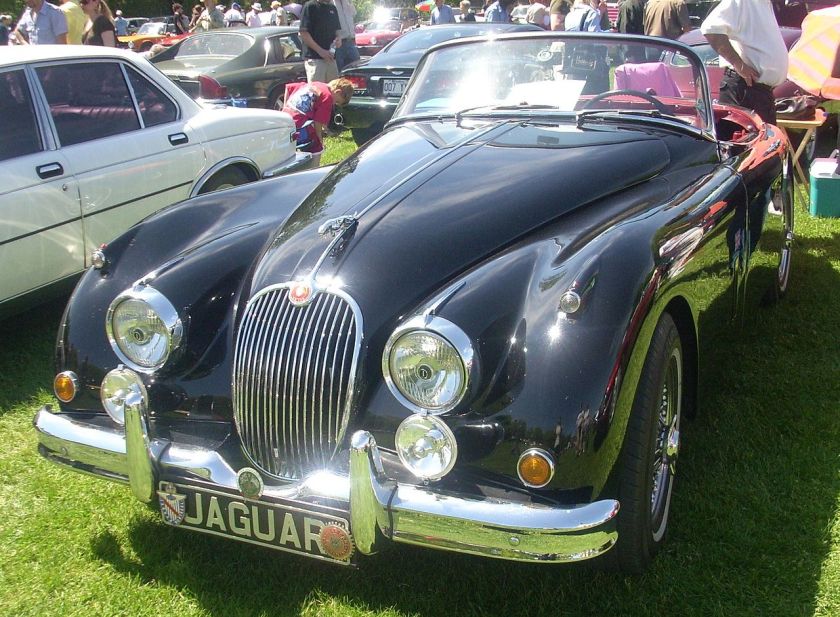
1958 Jaguar XK150 Roadster
|
|
| Overview | |
| Manufacturer | Jaguar Cars |
| Production | 1957–1961 |
| Assembly | Coventry, England |
| Body and chassis | |
| Class | Sports car |
| Body style | 2–3 seater coupé 2–3 seater convertible 2 seater roadster |
| Layout | FR layout |
| Powertrain | |
| Engine | 3442 cc(210CID) I6 3781 cc I6 |
| Dimensions | |
| Wheelbase | 2,591 mm (102.0 in) |
| Length | 4,496 mm (177.0 in) |
| Width | 1,580 mm (62.2 in) |
| Kerb weight | 2,968 lb (1,346 kg) |
| Chronology | |
| Predecessor | Jaguar XK140 |
| Successor | Jaguar E-type |
The Jaguar XK150 is a sports car produced by Jaguar between 1957 and 1961. It replaced the XK140.
Initially it was available in Fixed Head Coupé (FHC) and Drophead Coupé (DHC) versions. The Roadster (XK150 OTS – Open Two-Seat) was launched in 1958. Minimal rear seats were fitted in the coupés.
History
Although bearing a family resemblance to the XK120 and XK140, the XK150 was radically revised. A one-piece windscreen replaced the split screen, and the wing line no longer dropped so deeply at the doors. The widened bonnet opened down to the wings, and on the Roadster the windscreen frame was moved back 4 inches (102 mm) to make the bonnet longer. The car was available at various times in Red, Pearl Grey, White, Indigo Blue, Claret, Cotswold Blue, Black, Mist Grey, Sherwood Green, Carmen Red, British Racing Green, Cornish Grey, and Imperial Maroon.
The XK140’s walnut dashboard was replaced by one trimmed in leather. On the early Drophead Coupés, the aluminium centre dash panel, which was discontinued after June 1958, had an X pattern engraving similar to the early 3.8 E-type. Thinner doors gave more interior space. On the front parking lights, which were located atop the wings (fenders), a little red light reminded the driver the lights were on.
Suspension and chassis were very similar to the XK140, and steering was by rack and pinion; power steering was not offered. The standard engine, the similar to the XK140, but with an new “B” type cylinder head, was the 3.4 litre DOHC Jaguar straight-6 rated at 180 SAE bhp at 5750 rpm but most cars were fitted with the SE engine whose modified cylinder head (B type) and larger exhaust valves boosted the power to 210 SAE bhp at 5500 rpm. Twin 1.75-inch (44 mm) SU HD6 carburettors were fitted.
While the first XK150s were slower than their predecessors, the deficit was corrected in the spring of 1958 with a 3.4-litre “S” engine whose three 2-inch (51 mm) SU HD8 carburettors and straight-port cylinder head increased power to a claimed 250 SAE bhp.
For 1960, the 3.4 litre engine was bored to 3.8 litres, rating this option at 220 hp (164 kW; 223 PS) in standard tune or 265 hp (198 kW; 269 PS) in “S” form. A 3.8 litre 150S could top 135 mph (217 km/h) and go from 0–60 mph in around 7.0 seconds. Fuel economy was 18mpg.[3] Four-wheel Dunlop 12 in (305 mm) disc brakes appeared for the first time although it was theoretically possible to order a car with drums. When leaving the factory the car originally fitted either 6.00 × 16 inch Dunlop Road Speed tyres as standard, or you could specify 185VR16 Pirelli Cinturato CA67 as a radial option on either 16 × 5K½ solid wheels (basic models) or 16 × 5K wire wheels.
Production ended in October 1960, and totalled 2265 Roadsters, 4445 Fixed Head Coupés and 2672 Drophead Coupés.
Performance
A 250 bhp 3.4 litre XK150S Fixed-Head Coupé with limited slip differential was tested by The Motor in 1959. It had a top speed of 132 mph (212 km/h) and could accelerate from 0–60 mph (97 km/h) in 7.8 seconds. Fuel consumption of 22.0 miles per imperial gallon (12.8 L/100 km; 18.3 mpg-US) was recorded. The test car cost £2110 including taxes of £623. It was at the time the fastest closed car the magazine had ever subjected to a full road test.
Photographs
- 1961–1974 E-Type
Jaguar E-Type
| Jaguar E-Type | |
|---|---|
 |
|
| Overview | |
| Manufacturer | Jaguar Cars |
| Also called | Jaguar XK-E |
| Production | 1961–752014 |
| Assembly | Coventry, England |
| Designer | Malcolm Sayer |
| Body and chassis | |
| Class | Sports car |
| Layout | FR layout |
| Related | Jaguar D-Type Jaguar XJ13 |
| Chronology | |
| Predecessor | Jaguar XK150 |
| Successor | Jaguar XJ-S Jaguar F-Type |
The Jaguar E-Type (a.k.a. Jaguar XK-E) is a British sports car, which was manufactured by Jaguar Cars Ltd between 1961 and 1975. Its combination of good looks, high performance and competitive pricing established the marque as an icon of 1960s motoring. More than 70,000 E-Types were sold.
In March 2008, the Jaguar E-Type ranked first in a The Daily Telegraph online list of the world’s “100 most beautiful cars” of all time.
In 2004, Sports Car International magazine placed the E-Type at number one on their list of Top Sports Cars of the 1960s.
Overview
The E-Type was initially designed and shown to the public as a rear-wheel drive grand tourer in two-seater coupé form (FHC or Fixed Head Coupé) and as a two-seater convertible (OTS or Open Two Seater). A “2+2” four-seater version of the coupé, with a lengthened wheelbase, was released several years later.
On its release Enzo Ferrari called it “The most beautiful car ever made”.
Later model updates of the E-Type were officially designated “Series 2” and “Series 3”, and over time the earlier cars have come to be referred to as “Series 1” and “Series 1½”.
Of the “Series 1” cars, Jaguar manufactured some limited-edition variants, inspired by motor racing :
- The “‘Lightweight’ E-Type” which was apparently intended as a sort of follow-up to the D-Type. Jaguar planned to produce 18 units but ultimately only a dozen were reportedly built. Of those, two have been converted to Low-Drag form and two others are known to have been wrecked and deemed to be beyond repair, although one has now been rebuilt. These are exceedingly rare and sought after by collectors.
- The “Low Drag Coupé” was a one-off technical exercise which was ultimately sold to a Jaguar racing driver. It is presently believed to be part of the private collection of the current Viscount Cowdray.
The New York City Museum of Modern Art recognised the significance of the E-Type’s design in 1996 by adding a blue roadster to its permanent design collection, one of only six automobiles to receive the distinction.
Concept versions
E1A (1957)
After the company’s success at the Le Mans 24 hr through the 1950s, Jaguar’s defunct racing department was given the brief to use D-Type style construction to build a road-going sports car, replacing the XK150.
The first prototype (E1A) featured a monocoque design, Jaguar’s fully independent rear suspension and the well proved “XK” engine. The car was used solely for factory testing and was never formally released to the public. The car was eventually scrapped by the factory.
E2A (1960)
Jaguar’s second E-Type concept was E2A which, unlike the E1A, was constructed from a steel chassis with an aluminium body. This car was completed as a racing car as it was thought by Jaguar at the time it would provide a better testing ground. E2A used a 3-litre version of the XK engine with a Lucas fuel injection system.
After retiring from the Le Mans 24 hr the car was shipped to America to be used for racing by Jaguar privateer Briggs Cunningham. In 1961, the car returned to Jaguar in England to be used as a test vehicle. Ownership of E2A passed to Roger Woodley (Jaguar’s customer competition car manager) who took possession on the basis the car not be used for racing. E2A had been scheduled to be scrapped. Roger’s wife Penny Griffiths owned E2A until 2008 when it was offered for sale at Bonham’s Quail Auction. It eventually sold for US$4,957,000.
Production versions
Series 1 (1961–68)
| Series I | |
|---|---|
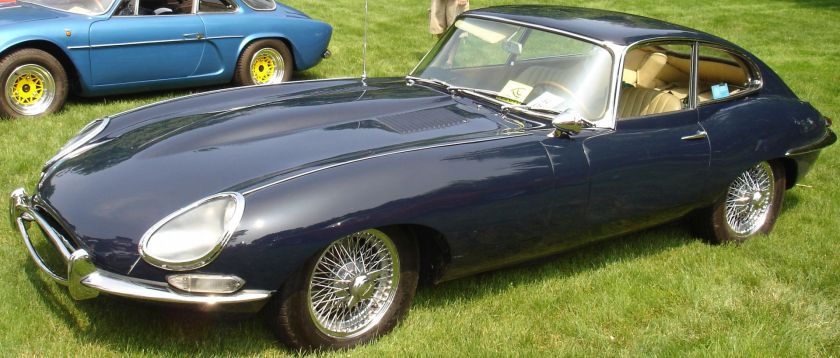 |
|
| Overview | |
| Production | March 1961–68 |
| Body and chassis | |
| Body style | 2-door coupe 2-door 2+2 coupe 2-door roadster |
| Powertrain | |
| Engine | 3.8 L XK I6 4.2 L XK I6 |
| Transmission | 4-speed manual; 3-speed automatic (automatic available 1966-onward, 2+2 model only) |
| Dimensions | |
| Wheelbase | 96.0 in (2,438 mm) (FHC / OTS) 105.0 in (2,667 mm) (2+2) |
| Length | 175.3125 in (4,453 mm) (FHC / OTS) 184.4375 in (4,685 mm) (2+2) |
| Width | 65.25 in (1,657 mm) (all) |
| Height | 48.125 in (1,222 mm) (FHC) 50.125 in (1,273 mm) (2+2) 46.5 in (1,181 mm) (OTS) |
| Kerb weight | 2,900 lb (1,315 kg) (FHC) 2,770 lb (1,256 kg) (OTS) 3,090 lb (1,402 kg) (2+2) |
The Series 1 was introduced, initially for export only, in March 1961. The domestic market launch came four months later in July 1961. The cars at this time used the triple SU carburetted 3.8 litre six-cylinder Jaguar XK6 engine from the XK150S. Earlier built cars utilised external bonnet latches which required a tool to open and had a flat floor design. These cars are rare and more valuable. After that, the floors were dished to provide more leg room and the twin bonnet latches moved to inside the car. The 3.8-litre engine was increased to 4.2 litres in October 1964.
The 4.2-litre engine produced the same power as the 3.8-litre (265 bhp;198 kW) and same top speed (150 mph;241 km/h), but increased torque from 240 to 283 lb·ft (325 to 384 N·m). Acceleration remained pretty much the same and 0 to 60 mph (0 to 97 km/h) times were around 7.0 seconds for both engines, but maximum power was now reached at 5,400rpm instead of 5,500rpm on the 3.8-litre. That all meant better throttle response for drivers that did not want to shift down gears.
Autocar road tested a UK spec E-Type 4.2 fixed head coupe in May 1965. The maximum speed was 153 mph (246 km/h), the 0–60 mph (0–97 km/h) time was 7.6 seconds and the 1⁄4 mile (402 m) from a standing start took 15.1 seconds. They summarised it as “In its 4.2 guise the E-type is a fast car ( the fastest we have ever tested) and offers just about the easiest way to travel quickly by road.”.
Motor magazine road tested a UK spec E-Type 4.2 fixed head coupe in Oct 1964. The maximum speed was 150 mph (241 km/h), the 0-60 mph time was 7 seconds and the 1⁄4 mile time was 14.9 seconds.They summarised it as “The new 4.2 supersedes the early 3.8 as the fastest car Motor has tested. The absurd ease which 100mph can be exceeded in a 1⁄4 mile never failed to astonish. 3,000 miles of testing confirms that this is still one of the worlds outstanding cars”.
All E-Types featured independent coil spring rear suspension with torsion bar front ends, and four wheel disc brakes, in-board at the rear, all were power-assisted. Jaguar was one of the first vehicle manufacturers to equip cars with disc brakes as standard from the XK150 in 1958. The Series 1 can be recognised by glass-covered headlights (up to 1967), small “mouth” opening at the front, signal lights and tail-lights above bumpers and exhaust tips under the number plate in the rear.
3.8-litre cars have leather-upholstered bucket seats, an aluminium-trimmed centre instrument panel and console (changed to vinyl and leather in 1963), and a Moss four-speed gearbox that lacks synchromesh for first gear (“Moss box”). 4.2-litre cars have more comfortable seats, improved brakes and electrical systems, and an all-synchromesh four-speed gearbox. 4.2-litre cars also have a badge on the boot proclaiming “Jaguar 4.2 Litre E-Type” (3.8 cars have a simple “Jaguar” badge). Optional extras included chrome spoked wheels and a detachable hard top for the OTS. When leaving the factory the car was originally fitted with Dunlop 6.40 × 15 inch RS5 tyres on 15 × 5K wire wheels (with the rear fitting 15 × 5K½ wheels supplied with 6.50 X15 Dunlop Racing R5 tyres in mind of competition). Later Series One cars were fitted with Dunlop 185 – 15 SP41 or 185 VR 15 Pirelli Cinturato as radial ply tyres.[
A 2+2 version of the coupé was added in 1966. The 2+2 offered the option of an automatic transmission. The body is 9 in (229 mm) longer and the roof angles are different. The roadster and the non 2+2 FHC (Fixed Head Coupe) remained as two-seaters.
Less widely known, right at the end of Series 1 production and prior to the transitional “Series 1½” referred to below, a very small number 10 to 20 Series 1 cars were produced, with open headlights in the uk, these series one cars that had their head lights modified by removing the covers and altering the scoops they sit in, the headlights differ in several respects from the “production” Series 1½, the main being they are shorter at 143mm from the production Series 1½ at 160mm . Production dates on these machines vary but in right hand drive form production has been verified as late as March 1968. The low number of these cars produced make them amongst the rarest of all production E Types.
Following the Series 1 there was a transitional series of cars built in 1967–68, unofficially called “Series 1½”, which are externally similar to Series 1 cars. Due to American pressure the new features were open headlights, different switches, and some de-tuning (using two Zenith-Stromberg carburetters instead of the original three SUs) for US models. Some Series 1½ cars also have twin cooling fans and adjustable seat backs. Series 2 features were gradually introduced into the Series 1, creating the unofficial Series 1½ cars, but always with the Series 1 body style. A United States federal safety law affecting 1968 model year cars sold in the US was the reason for the lack of headlight covers and change in switch design in the “Series 1.5” of 1968. An often overlooked change, one that is often “modified back” to the older style, is the wheel knock-off “nut.” US safety law for 1968 models also forbid the winged-spinner knockoff, and any 1968 model year sold in the US should have a hexagonal knockoff nut, to be hammered on and off with the assistance of a special “socket” included with the car from the factory. This hexagonal nut carried on into the later Series 2 and 3.
An open 3.8-litre car, actually the first such production car to be completed, was tested by the British magazine The Motor in 1961 and had a top speed of 149.1 mph (240.0 km/h) and could accelerate from 0 to 60 mph (0 to 97 km/h) in 7.1 seconds. A fuel consumption of 21.3 miles per imperial gallon (13.3 L/100 km; 17.7 mpg-US) was recorded. The test car cost £2,097 including taxes.
The cars submitted for road test by the popular motoring journals of the time (1961)such as The Motor, The Autocar and Autosport magazines were specially prepared by the Jaguar works to give better-than-standard performance figures. This work entailed engine balancing and subtle work such as gas-flowing the cylinder heads and may even have involved fitting larger diameter inlet valves.
Both of the well-known 1961 road test cars: the E-type Coupe Reg. No. 9600 HP and E-type Convertible Reg.No. 77 RW, were fitted with Dunlop Racing Tyres on test, which had a larger rolling diameter and lower drag co-efficient. This goes some way to explaining the 150 mph (240 km/h) maximum speeds that were obtained under ideal test conditions. The maximum safe rev limit for standard 6-cylinder 3.8-litre E-type engines is 5,500 rpm. The later 4.2-Litre units had a red marking on the rev counter from just 5,000 rpm. The maximum safe engine speed is therefore 127 mph (3.31:1 axle) and 137 mph (3.07:1 axle) at the 5,500 rpm limit. Both test cars must have reached or exceeded 6,000 rpm in top gear when on road test in 1961.
Production numbers from Robson:
- 15,490 3.8s
- 17,320 4.2s
- 10,930 2+2s
Production numbers:
| FHC | OTS | 2+2 | Total | |
|---|---|---|---|---|
| S1 3.8 | 7,670 | 7,828 | 0 | 15,498 |
| S1 4.2 | 5,830 | 6,749 | 3,616 | 16,195 |
| S1.5 | 1,942 | 2,801 | 1,983 | 6,726 |
| TOTAL | 38,419 |
Series 2 (1968–71)
| Series II | |
|---|---|
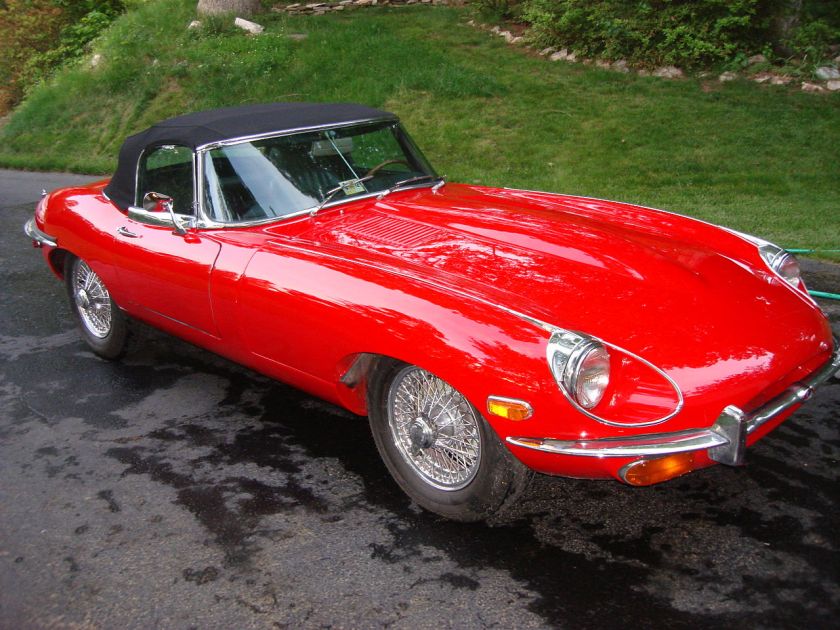 |
|
| Overview | |
| Production | 1968–71 |
| Body and chassis | |
| Body style | 2-door coupe 2-door 2+2 coupe 2-door roadster |
| Powertrain | |
| Engine | 4.2 L XK I6 |
| Dimensions | |
| Kerb weight | 3,018 lb (1,369 kg) (FHC) 2,750 lb (1,247 kg) (OTS) 3,090 lb (1,402 kg) (2+2) |
The Series 2 introduced a number of design changes, largely due to U.S. design legislation. The most distinctive feature is the absence of the aerodynamic glass headlight covers, which impacted several otherimported cars, like the Citroën DS, as well. Unlike other cars, this retrograde step was applied worldwide for the E-Type, not just to Americans living under the authority of the National Highway Traffic and Safety Administration.
Other hallmarks of Series 2 cars are a wrap-around rear bumper, re-positioned and larger front indicators and tail lights below the bumpers, better cooling aided by an enlarged “mouth” and twin electric fans, and uprated brakes.
A combination steering lock and ignition key was fitted to the steering column, which replaced the dash board mounted ignition switch and charismatic push button starter. A new steering column was fitted with a collapsible section in the event of an accident.
New seats were fitted, which purists claim lacked the style of the originals but were certainly more comfortable. These new seats allowed the fitment of head restraints, as required by U.S. law beginning in 1969. The interior and dashboard were also redesigned; rocker switches that met US health and safety regulations were substituted for toggle switches. The dashboard switches also lost their symmetrical layout.
The engine is easily identified visually by the change from smooth polished cam covers to a more industrial “ribbed” appearance. It was de-tuned in the US with twin Strombergs and larger valve clearances, but in the UK retained triple SUs and the much tighter valve clearances. (Late Series 1½ cars also had ribbed cam covers). This detuned engine produced 245 hp (183 kW), a drop of 20hp.
Air conditioning and power steering were available as factory options.
Production according to Robson is 13,490 of all types.
Series 2 production numbers:
| FHC | OTS | 2+2 | TOTAL | |
|---|---|---|---|---|
| S2 | 4,855 | 8,628 | 5,326 | 18,809 |
Official delivery numbers by market and year are listed in Porter but no summary totals are given.
Series 3 (1971–75)
| Series III | |
|---|---|
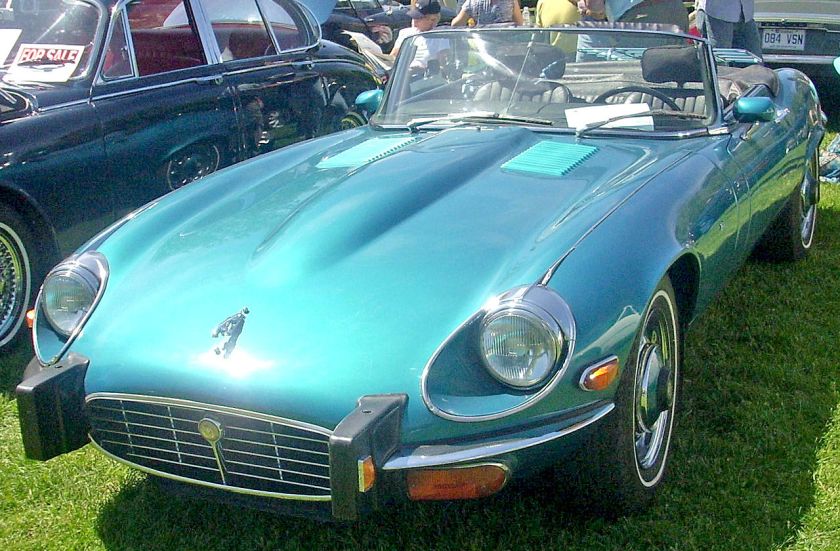 |
|
| Overview | |
| Production | 1971–75 |
| Body and chassis | |
| Body style | 2-door 2+2 coupe 2-door roadster |
| Powertrain | |
| Engine | 5.3 L Jaguar V12 engine |
| Dimensions | |
| Wheelbase | 105 in (2,667 mm) (both) |
| Length | 184.4 in (4,684 mm) (2+2) 184.5 in (4,686 mm) (OTS) |
| Width | 66.0 in (1,676 mm) (2+2) 66.1 in (1,679 mm) (OTS) |
| Height | 48.9 in (1,242 mm) (2+2) 48.1 in (1,222 mm) (OTS) |
| Kerb weight | 3,361 lb (1,525 kg) (2+2) 3,380 lb (1,533 kg) (OTS) |
A new 5.3 L twelve-cylinder Jaguar V12 engine was introduced, with uprated brakes and standard power steering. The short wheelbase FHC body style was discontinued and the V12 was available only as a convertible and 2+2 coupé. The convertible used the longer-wheelbase 2+2 floorplan. The Series 3 is easily identifiable by the large cross-slatted front grille and flared wheel arches, and a badge on the rear that proclaims it to be a V12. Cars for the US market were fitted with large projecting rubber bumper over-riders (in 1973 these were on front, in 1974 both front and rear) to meet local 5 mph (8 km/h) impact regulations, but those on European models were considerably smaller. US models also have side indicator repeats on the front wings. There were also a very limited number of six-cylinder Series 3 E-Types built. These were featured in the initial sales literature. When leaving the factory the V12 Open Two Seater and V12 2 ± 2 originally fitted Dunlop E70VR − 15 inch tyres on 15 × 6K wire or solid wheels.
Robson lists production at 15,290.
Series 3 production numbers:
| FHC | OTS | 2+2 | TOTAL | |
|---|---|---|---|---|
| S3 | 0 | 7,990 | 7,297 | 15,287 |
Limited editions
Two limited production E-Type variants were made as test beds, the Low Drag Coupe and Lightweight E-Type, both of which were raced:
Low Drag Coupé (1962)
Shortly after the introduction of the E-Type, Jaguar management wanted to investigate the possibility of building a car more in the spirit of the D-Type racer from which elements of the E-Type’s styling and design were derived. One car was built to test the concept designed as a coupé as its monocoque design could only be made rigid enough for racing by using the “stressed skin” principle. Previous Jaguar racers were built as open-top cars, because they were based on ladder frame designs with independent chassis and bodies. Unlike the steel production E-Types, the LDC used lightweight aluminium. Malcolm Sayer retained the original tub with lighter outer panels riveted and glued to it. The front steel sub frame remained intact, the windshield was given a more pronounced slope, and the rear hatch was welded shut. Rear brake cooling ducts appeared next to the rear windows, and the interior trim was discarded, with only insulation around the transmission tunnel. With the exception of the windscreen, all cockpit glass was perspex. A tuned version of Jaguar’s 3.8-litre engine with a wide-angle cylinder head design tested on the D-Type racers was used. Air management became a problem and, though a higher performing vehicle than its production counterpart, the car was never competitive.
The only test bed car was completed in summer of 1962 but was sold a year later to Jaguar racing driver Sledge hammer Protheroe. Since then it has passed through the hands of several collectors on both sides of the Atlantic and is now believed to reside in the private collection of the current Viscount Cowdray.
Lightweight E-Type (1963–64, 2014)
Twelve cars plus two spare bodies were made by Jaguar.
In some ways, this was an evolution of the Low Drag Coupé. It made extensive use of aluminium alloy in the body panels and other components. However, with at least one exception, it remained an open-top car in the spirit of the D-Type to which this car is a more direct successor than the production E-Type which is more of a GT than a sports car. The cars used an aluminium block tuned version of the production 3.8-litre Jaguar engine with 300 bhp (224 kW) output rather than the 265 bhp (198 kW) produced by the “ordinary” version. Factory-built lightweights were homologated by Jaguar with three 45DCO3 Weber carburettors in addition to a Lucas mechanical fuel injection system. Early cars were fitted with a close-ratio version of the four-speed E-type gearbox, with some later cars being fitted with a ZF 5-speed gearbox.
The cars were entered in various races but, unlike the C-Type and D-Type racing cars, they did not win at Le Mans or Sebring but were reasonably successful in private hands and in smaller races.
One Lightweight was modified into a Low-Drag Coupé (the Lindner/Nocker car), by Malcolm Sayer.
Another Lightweight was modified into a unique Low-Drag design (the Lumsden/Sargent car), by Dr Samir Klat of Imperial College. Along with the factory LDC, this lightweight is now believed to reside in the private collection of the current Viscount Cowdray.
Many were fitted with more powerful engines as developments occurred.
On 14 May 2014, Jaguar’s Heritage Business announced it will be building the six ‘remaining’ Lightweights. The original run of Lightweights was meant to be 18 vehicles; however only 12 were built. The new cars, using the un-used chassis codes, will be hand-built to exactly the same specification as the originals. Availability will be prioritised for established collectors of Jaguars, with a focus on those who have an interest in historic race cars.
Motorsport
Bob Jane won the 1963 Australian GT Championship at the wheel of a “lightweight” E-Type.
The Jaguar E-Type was very successful in SCCA Production sports car racing with Group44 and Bob Tullius taking the B-Production championship with a Series-3 V12 racer in 1975.[29] A few years later, Gran-Turismo Jaguar from Cleveland Ohio campaigned a 4.2-litre six-cylinder FHC racer in SCCA production series, and in 1980 won the National Championship in the SCCA C-Production Class, defeating a fully funded factory Nissan Z-car team with Paul Newman.
- 1975–1996 XJ-S
Jaguar XJS
| Jaguar XJ-S | |
|---|---|
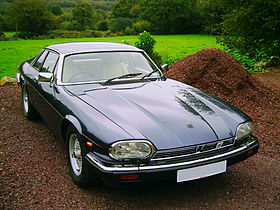 |
|
| Overview | |
| Manufacturer | Jaguar Cars |
| Production | 1975–1996 |
| Assembly | Coventry, England |
| Body and chassis | |
| Class | Grand tourer |
| Layout | FR layout |
| Chronology | |
| Predecessor | Jaguar E-Type |
| Successor | Jaguar XK8 |
| XJ-S (Pre H.E.) | |
|---|---|
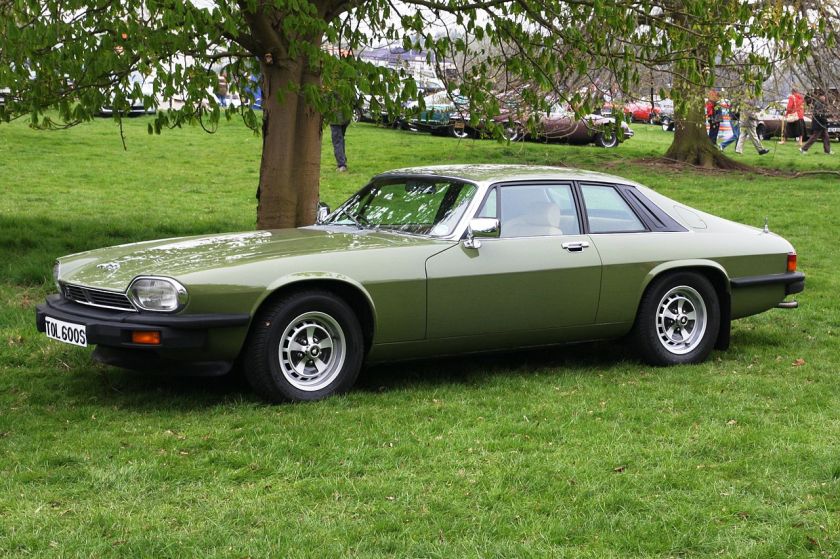 |
|
| Overview | |
| Production | 1975–1980 14,800 built |
| Body and chassis | |
| Body style | 2-door coupé |
| Powertrain | |
| Engine | 5.3 L Jaguar V12 |
| Dimensions | |
| Wheelbase | 102 in (2,591 mm) |
| Length | 191.72 in (4,870 mm) |
| Width | 70.6 in (1,793 mm) |
| Height | 50 in (1,300 mm) |
The Jaguar XJ-S (later the Jaguar XJS), a luxury grand tourer, was produced by the British manufacturer Jaguar from 1975 to 1996. The XJ-S replaced the E-Type (also known as the XK-E) in September 1975, and was based on the XJ saloon. It had been developed as the XK-F, though it was very different in character from its predecessor. Although it never had quite the same sporting image, the XJ-S was a competent grand tourer, and more aerodynamic than the E-Type. The last XJS was produced on 4 April 1996, by then 115,413 had been produced during a 21-year production life. The model was replaced by the XK8.
1975
The first XJ-S appeared in 1975 as a 1976 model. The development of the car had begun in the late 1960s as project XJ27, with an initial shape set by Malcolm Sayer, but after his death in 1970 it was completed by the in-house Jaguar design team, headed by Doug Thorpe. Power came from the Jaguar V12 petrol engine with a choice of a manual or automatic transmission, but the manual was soon dropped as they were left over from V12 E Type production. V12 automobiles were unusual at the time, with notable others coming from Italian luxury sports car makers Lamborghini and Ferrari. The specifications of the XJ-S compared well with both Italian cars; it was able to accelerate to 60 mph (97 km/h) in 7.6 seconds (automatic) and had a top speed of 143 mph (230 km/h).[4] The first series of XJ-S cars had a Borg-Warner Model 12 transmission with a cast-iron case and a bolt-on bell-housing. In 1977 GM Turbo-Hydramatic 400 transmissions were fitted.[5] The TH400 transmission was an all-aluminium alloy case with an integrated non-detachable bell-housing. When leaving the factory the XJ-S originally fitted Dunlop SP Super E205/70VR tyres on 15 × 6K alloy wheels, though British police forces would upgrade from this factory standard and fit a higher performing 205/70VR15 Michelin XWX to the Jaguars in their fleet.
Jaguar’s timing was not good; the car was launched in the wake of a fuel crisis, and the market for a 5.3-litre V12 grand tourer was very small. The styling was also the subject of criticism, including the buttresses behind the windows. German authorities feared these would restrict rearward vision, and refused to give the model (along with Lancia‘s similarly adorned Montecarlo model) type approval: it was for a time necessary instead for German XJS buyers to obtain type approval for each individual car when registering it. Such fears were ill founded, since in reality the rear visibility was very reasonable, with only the frontmost top edges of the buttresses being visible, when looking rearward.
Jaguar did seize promotional opportunities with the television series The New Avengers and Return of the Saint. The New Avengers featured Mike Gambit (Gareth Hunt) who drove an XJ-S. Return of the Saint saw Simon Templar (played by Ian Ogilvy) driving an early XJ-S with the number plate “ST 1”. Miniature versions were made by Corgi and proved popular. A decade and a half before, Jaguar had turned down the producers of the earlier Saint series when approached about the E-type; the producers had instead used a Volvo P1800.
Responding to criticisms that the XJ-S was not a worthy E-type successor, Pininfarina revealed a sporty show car in 1978 based on XJ-S mechanicals and called Jaguar XJSpider. The car never went into production.
1980s
| XJ-S H.E., 3.6, XJ-SC | |
|---|---|
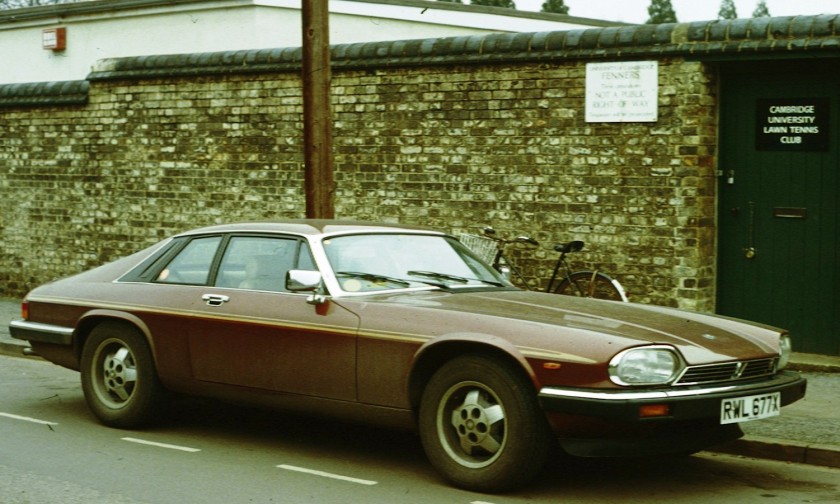 |
|
| Overview | |
| Production | (All engines, including H.E. and 3.6) 1980–1990 73,207 built Coupé: 55,822 Targa / convertible: 5,013 Full convertible: 12,372 |
| Body and chassis | |
| Body style | 2-door coupé 2-door targa convertible (1983-88, V12 from 1985) 2-door full convertible (from 1988) |
| Powertrain | |
| Engine | 3.6 L AJ6 I6 5.3 L HE V12 |
| Transmission | 5-speed manual (3.6 only) 3/4-speed automatic |
| Dimensions | |
| Wheelbase | 102.0 in (2,591 mm) |
| Length | 191.7 in (4,869 mm) |
| Width | 70.6 in (1,793 mm) |
| Height | 47.8 in (1,214 mm) |
From July 1980, the XJ-S became the XJS-HE received the new High-Efficiency engine for much better economy which included the Fire Ball combustion chamber designed by Swiss Engineer Michael May, as a by-product, power was increased to 220 kW (295 hp) or 196 kW (263 hp) in North America. At the same time, the XJS-HE received changes to its exterior and interior (Body coloured trunk plinth in place of the standard previous black, new five-spoke (Starfish) alloy wheels, chrome inserts on the upper part of the bumpers, Burled Elm wood inserts on dashboard and door cappings). In 1982, the new V12 XJS-HE won first and second at the RAC Tourist Trophy race at Silverstone.
Six-cylinder version and a convertible
In 1983, a new 3.6-litre engine débuted – the Jaguar AJ6 straight-six (I6) engine – as well as a new cabriolet version, the XJ-SC. In the XJ-SC, the coupé’s rather small rear seats were eliminated making it only a 2-seat car. The XJ-SC was not a full convertible but had a non-removable centre targa-type structure and fixed cant rails above the doors. The rear quarter windows remained as well. The six-cylinder cars can be identified by a slightly raised “power bulge” — the longitudinal centre section of the bonnet.
Between 1983 and 1987 the six-cylinder-engined cars were only available with a five-speed manual transmission (Getrag 265), with a four-speed automatic (ZF 4HP22) offered from 1987 onwards (along with improved fuel injection as used on the XJ40). The earlier, manual models were not imported by Jaguar into the United States, which had to wait until the facelift manual 4-litre XJS coupé and convertible were available.
A V12 XJ-SC emerged in 1985.
Full convertible
The two-seat XJ-SC targa-type model, never a great success in the market place, was replaced with a two-seat full convertible in 1988 which proved to be a great hit.
Coach Builders limited(1983–1988)
Coach Builders limited converted XJS from coupe. It has 4 seats compared to factory convertible. Number produced is unknown.
Hess & Eisenhardt convertible
From 1986 a full convertible version was available through some dealers, modified by Hess & Eisenhardt in the USA. The Hess & Eisenhardt coachbuilding firm was located in Ohio, USA, and built about 893 of these cars under contract from Jaguar before the official Jaguar-built XJS full convertible appeared in 1988.
The Hess & Eisenhardt convertible differed from the later Jaguar convertible XJS as its unpadded top folded down deeper into the body structure of the car resulting in a cleaner rear profile when the roof was lowered. To accommodate this design element, the Hess & Eisenhardt convertibles have two separate fuel tanks, positioned to allow for the roof to fully retract. The process of converting the stock Jaguar XJS coupé into the H&E Convertible included the post-production removal of the roof, cutting the body in several sections, the addition of steel reinforcements behind the driver’s seat, and 20 lb (9.1 kg) weights placed just behind the headlights to eliminate harmonic resonance caused by the significant modifications to the car. H&E XJS convertibles are easily identified by the lower folding top, as well as two small badges located just behind the front wheels. The later Jaguar full convertible had a heavier padded top that did not fold into as small a bundle when in the lowered position, but retained nearly all of the original components of the coupé.
The number of H&E Jaguar XJS produced is unknown, partly because a fire at the Hess & Eisenhardt factory destroyed most of the records pertaining to the Jaguar XJS conversions.
XJR-S
From 1988, a special XJR-S version of the V12 5.3-litre car was produced by JaguarSport, a separate company owned 50:50 by Jaguar and TWR. This car had a distinctive body kit, special alloy wheels and suspension and handling improvements. the first 100 of these cars were termed “Celebration Le Mans” to commemorate Jaguar’s 1988 win at Le Mans. Between 1988 and 1989 a total of 350 XJR-S cars were produced with the 5.3-litre engine. After September 1989 the change was made to a special 6.0-litre engine with a Zytec engine management system (234 kW (314 hp), later 245 kW (329 hp)). This was different from the standard 6.0-litre engine used in the late XJS models. The XJR-S stayed in the line until 1993; a total of 1,130 cars were built.
Daimler
Jaguar considered a luxury Daimler version tentatively called Daimler-S, without the buttresses. One prototype was made in 1986, but the vehicle was not put into production. Paul Banham did produce some custom notch back coupés without the buttresses, larger rear side windows, and a narrow C-pillar. In the mid-nineties, Banham also made a re-worked version called the XJSS based on the XJS.
1990–1996
| XJS (Facelift) | |
|---|---|
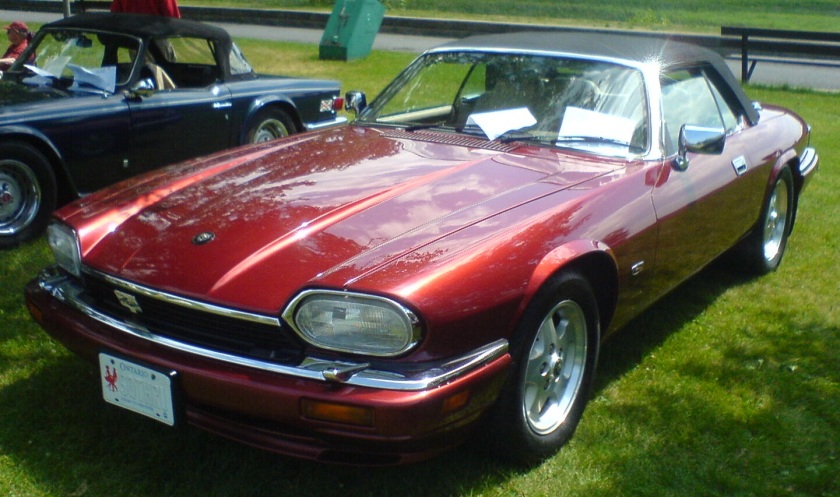 |
|
| Overview | |
| Also called | Jaguar XJS Classic |
| Production | 1990–1996 27,406 built Coupé: 8,832 Convertible: 18,574 |
| Body and chassis | |
| Body style | 2-door coupé 2-door 2-seat convertible 2-door 2+2 convertible |
| Powertrain | |
| Engine | 4.0 L AJ6 I6 4.0 L AJ16 I6 5.3 L HE V12 6.0 L HE V12 |
| Transmission | 5-speed manual 4-speed automatic |
| Dimensions | |
| Wheelbase | 102.0 in (2,591 mm) |
| Length | 191.2 in (4,856 mm) |
| Width | 1992—1993: 70.6 in (1,793 mm) 1994—1996: 74.1 in (1,882 mm) |
| Height | 48.7 in (1,237 mm) |
The car was re-engineered in June 1990 and renamed XJS. The rear side windows appeared enlarged (although the body glass aperture was actually the same size as the earlier car), and the buttresses stayed (although their appearance was minimised by the new side window treatment), as designer Geoff Lawson argued that they were part of the car’s character. The car received a new 4.0-litre version of the AJ6. In 1992, a 4.0-litre convertible was added to the range. The V12’s capacity was enlarged to 6.0 litres in May 1992 (227 kW (304 hp)). At the same time the car benefited from a revision to the rear brakes, they were now fitted with outboard rear disc brakes, instead of the more complicated inboard items on previous models. With the introduction of the 6.0-litre V12, the transmission was also updated to a GM 4L80E with a fourth-gear overdrive, whilst the automatic 4.0-litre models continued with the electronic ZF4HP24E transmission. A 2+2 convertible was also introduced, as was a customised insignia line. At the same time the car received more aerodynamic front and rear bumpers.
In April 1994, substantial revisions were made to the 4.0-litre AJ6 engine which became the 4.0-litre AJ16 with coil-on-plug ignition. In 1995, the final specification changes were made and the car was referred to as the Celebration model to celebrate the 60th year of the Jaguar company. Celebration cars feature diamond turned wheels, Jaguar embossed seats and a wooden steering wheel.
The XJS was discontinued in 1996, after 21 years in production. It was replaced by the XK8.
Motorsport
For 1977, the “Group44” racing team had a very successful season in Trans Am with a race car based on the actual production XJ-S chassis and running gear. The team won the series’ 1977 drivers’ championship cup for Bob Tullius but missed winning the manufacturer’s title by two points (only one Jaguar was competing in the Trans-Am series compared to many more Porsche entrants). In 1978, a purpose-built tube-frame “silhouette” style XJS race car was constructed which greatly reduced the weight compared to the full production chassis car campaigned in 1977. This silhouette car had only the production car’s roof panel as the sole piece of factory XJS sheetmetal on the car. Group 44 succeeded in again capturing the driver’s championship for Bob Tullius and also captured the manufacturer’s title as well, by entering Brian Fuerstenau driving the 1977 car at some venues to gain additional manufacturer’s points for Jaguar. The silhouette car survived and has surfaced recently in the SVRA historic sports race series. The 1977 factory chassis race car is believed to still be in the hands of Group 44’s Bob Tullius.
In April 1979 a Jaguar XJS driven by Dave Heinz and Dave Yarborough was entered into Cannonball Baker Sea-To-Shining-Sea Memorial Trophy Dash, widely known simply as the Cannonball Run. They completed the 2,863 miles (4,608 km) from New York to Los Angeles in a record time of 32 hours and 51 minutes, a record that stood for 4 years, until it was beaten by David Diem and Doug Turner in a Ferrari 308. Diem and Turner covered the same distance in 32 hours and 7 minutes on the US Express, an unofficial successor to the Cannonball Run.
In 1982 Tom Walkinshaw‘s TWR had entered a team of the V12 XJS’ into the European Touring Car Championship, the cars built to the FIA‘s Group A touring car rules. The XJS won its first race that season when Walkinshaw and Chuck Nicholson won the XIV Grand Prix Brno, the Jags simply proving too fast for their rival BMW and Alfa Romeo opposition with Walkinshaw qualifying 5.37 seconds faster than anyone else on the 10.925 km (6.789 mi) Brno Circuit. After more victories for the teams Jaguars in 1983, the TWR Jaguars were the cars to beat in the ETCC, with Walkinshaw claiming the 1984 ETCC Drivers’ Championship. During the championship season the TWR Jaguar team also won the prestigious Spa 24 Hours race with an XJS driven by Walkinshaw, Hans Heyer and Win Percy, proving not only the speed of the cars, but the reliability of the 5.3 litre V12 engine. By 1984 the TWR Jaguars had a new challenger in the ETCC. The turbocharged Volvo 240T arrived on the scene and had the speed to match the V12’s, though with turbocharging new to touring car racing it took a number of races for reliability to match the cars speed.
By 1985 the XJS’ had been retired and TWR was committed to running the 3.5L V8 Rover Vitesse in the ETCC. Walkinshaw had been to the 1984 James Hardie 1000 at the Mount Panorama Circuit in Bathurst, Australia, to co-drive a locally developed Australian Group C XJS with Aussie John Goss. Walkinshaw qualified the V12 Jag in provisional 7th place with a 2:16.09 lap of the 6.172 km (3.835 mi) circuit, recording 290 km/h (180 mph) on the 2 km long Conrod Straight, with the promise of more to come in the “Hardies Heroes” Top 10 runoff through the use of special tyres. However, the tyres failed to arrive at the circuit in time and Walkinshaw eventually qualified 10th having to use front wheels on the car as no suitable rubber was available. Clutch failure saw the car fail to get off the start line and a helpless Walkinshaw was hit from behind by a Chevrolet Camaro Z28, causing the cars instant retirement and the races first ever restart after the track was blocked at the start/finish line.
The Scot was determined to come back in 1985 and win the race in the first season of Group A in Australia and in 1985 the three TWR XJS Jaguars were brought out of retirement and shipped down under for the James-Hardie 1000. The cars were clearly the class of the field, finishing Hardies Heroes in 1st (Walkinshaw/Percy in #8), 2nd (Jeff Allam/Ron Dickson in #9) and 6th (Goss/Armin Hahne in #10). This time the big Cats got off the start line and Walkinshaw and Percy dominated most of the race, only losing the lead to the Goss/Hahne car during pit stops (the Allam/Dickson car went out on lap 3 with engine failure). The drivers of the #10 car, who had to battle a broken seat which was held loosely in place by straps and cable ties for well over 100 laps, sat in second most of the way until a split oil line late in the race cost the Walkinshaw/Percy car 3 laps and any chance of victory. 1974 Bathurst 1000 winner Goss won his second “Great Race” while Hahne, who had won the Group A category in the 1984 race driving a TWR Rover, maintained his 100% record with his only Bathurst 1000 win. After having the oil line replaced, Walkinshaw resumed in 4th place but easily caught and passed the JPS Team BMW 635 CSi of 1985 Australian Touring Car Champion Jim Richards in the last laps to make it a Jaguar 1-3, with Walkinshaw following Goss across the finish line in a formation finish.
The TWR XJS Jaguars were next seen late in 1986 at the Fuji 500 in Japan in what was meant to be its Group A swansong as it ran out of FIA homologation in at the end of the year. Against old foes in the BMW 635 CSi and Volvo 240T, as well as newer Group A cars such as the Australian Holden VK Commodore SS Group A V8 and the turbocharged Nissan Skyline RS DR30, Walkinshaw qualified the XJS on pole, proving how competitive the car could still be in Touring car racing (the cars had been entered in the 1986 Bathurst 1000 and had undergone testing and development which gave a reported extra 50 bhp, though ultimately did not race due to a lack of money). The race saw the Walkinshaw/Percy car lead the race until retiring on lap 6 with no oil pressure while the Hahne/Denny Hulme/Walkinshaw car only lasted until half distance before retiring with a broken differential.
Despite not being eligible for Group A racing in 1987, TWR ran their two Jaguars in the 1987 (January) Nissan Mobil 500 in Wellington, New Zealand under special invitation from the race promoters. Neither car finished with Walkinshaw/Percy suffering diff failure and the Hahne/Hulme car cutting a tyre resulting in a race ending crash after fighting their way into the lead. The cars then raced at Pukekohe, with Percy/Hahne giving the big cat a second place finish in its final race behind the VK Commodore of Australian drivers Larry Perkins and David Parsons.
Aussie privateer Garry Willmington ran an XJS in the 1985 and 1986 Australian Touring Car Championships, and also the late season endurance races. While he reportedly had obtained more power from the V12 than TWR, Willmington didn’t have TWR’s resources to develop either the car or engine reliability and results were not forthcoming, though on occasions where the track had a long enough straight (such as Sandown Raceway in Melbourne or the Adelaide International Raceway), the Willmington Jag was usually the fastest car in a straight line. John Goss also ran his own privately entered XJS in the 1986 James Hardie 1000 after Jaguar-Rover Australia pulled its backing of the proposed TWR return to Bathurst due to a severe downturn in the Australian car market forced him to defend his crown alone, though he did receive some technical assistance from TWR. Electrical problems in the race Goss finish 24th with veteran Australian driver Bob Muir.
Today the XJS continues to be extensively campaigned in club level motorsport both in the United Kingdom and overseas. Best known of the race series is probably the Jaguar Enthusiasts’ Club XJS championship, currently in association with Toyo Tires. Their championship has now been running for over a decade, offering an affordable entry into club motorsport in the UK, and continuing to attract large grids of this unlikely racing car. Cars compete in various states of modification, from barely modified road cars through to full race-specification cars built in homage to the great TWR specials.
- 1992–1994 XJ220
Jaguar XJ220
| Jaguar XJ220 | |
|---|---|
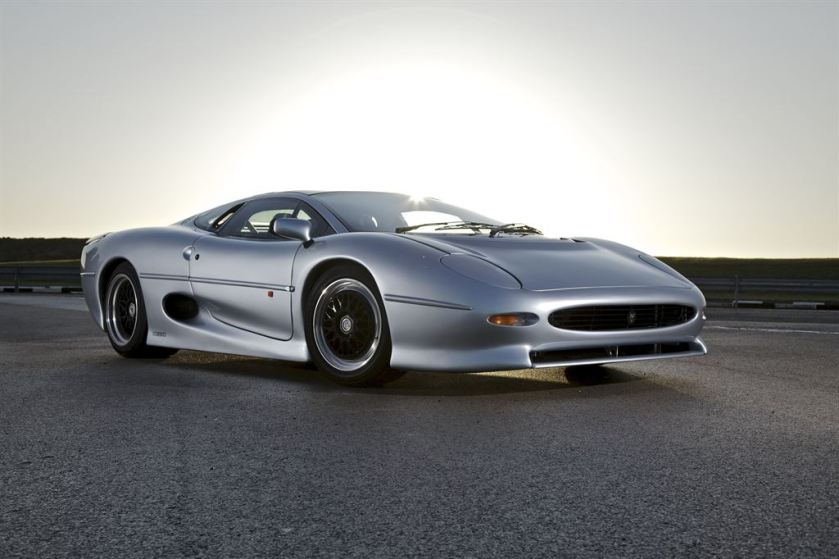 |
|
| Overview | |
| Manufacturer | Jaguar Cars |
| Production | 1992–94 (275 produced) |
| Assembly | JaguarSport Jaguar/TWR joint venture Bloxham, Oxfordshire |
| Designer | Jim Randle Keith Helfet |
| Body and chassis | |
| Class | Sports car |
| Body style | 2-door coupé |
| Layout | RMR layout |
| Powertrain | |
| Engine | 3.5 L twin-turbocharged V6 |
| Transmission | 5-speed manual |
| Dimensions | |
| Wheelbase | 2,640 mm (103.9 in) |
| Length | 4,930 mm (194.1 in) |
| Width | 2,220 mm (87.4 in) including wing mirrors |
| Height | 1,150 mm (45.3 in) |
| Kerb weight | 1,470 kg (3,240.8 lb) |
| Chronology | |
| Predecessor | Jaguar XJR-15 |
| Successor | Jaguar C-X75 |
The Jaguar XJ220 is a two-seater supercar produced by British luxury car manufacturer Jaguar from 1992 until 1994, in collaboration with the specialist automotive and race engineering company Tom Walkinshaw Racing. The XJ220 held the record for the fastest production car throughout 1992 after recording a top speed of 213.478 mph (343.560 km/h), before being superseded by the McLaren F1 in 1993 when it recorded a top speed of 231 mph (372 km/h). The Jaguar held the Nürburgring production car lap record between 1992 and 2000 with a time of 7:46.36.
The XJ220 was developed from a V12-engined 4-wheel drive concept car designed by an informal group of Jaguar employees working in their spare time. The group wished to create a modern version of the successful Jaguar 24 Hours of Le Mans racing cars of the 1950s and ’60s that could be entered into FIA Group B competitions. The XJ220 made use of engineering work undertaken for Jaguar’s then current racing car family.
The initial XJ220 concept car was unveiled to the public at the 1988 British International Motor Show, held in Birmingham, England. Its positive reception prompted Jaguar to put the car into production; some 1500 deposits of £50,000 each were taken, and deliveries were planned for 1992.
Engineering requirements resulted in significant changes to the specification of the XJ220, most notably replacement of the Jaguar V12 engine by a turbocharged V6 engine. The changes to the specification and a collapse in the price of collectible cars brought about by the early 1990s recession resulted in many buyers choosing not to exercise their purchase options. A total of just 275 cars were produced by the time production ended, each with a retail price of £470,000 in 1992.
Conception
Jaguar were approached by racing team owner Tom Walkinshaw and encouraged to enter the Jaguar XJS into the 1981 European Touring Car Championship; they succeeded in winning the competition in 1984. Jaguar had started to provide factory support to racing team Group 44 Racing, who were using the Jaguar-engined XJR-5 in the IMSA GT Championship, supplying V12 engines from 1983 onwards and supporting a Le Mans entry in 1984. Tom Walkinshaw and Jaguar agreed to entering the FIA Group C World Sportscar Championship and developed the XJR-6, which was powered by the Jaguar V12 engine; the car was launched during the 1985 season.
TWR took over the IMSA GT Championship operation in 1988 and one model – Jaguar XJR-9 – was launched to compete in both series. The XJR-9, which retained the Jaguar V12 engine, went on to win the 1988 24 Hours of Le Mans and World Sportscar Championship in the same year. The poor fuel consumption of the Jaguar V12 combined with new rules restricting refueling during races forced the replacement of the V12 engine in the XJR-9s successors, the XJR-10 and XJR-11. The normally-aspirated Austin Rover V64V engine, designed for the MG Metro 6R4 had recently been made redundant thanks to the Group B rally ban in 1987, and the design rights were for sale. The compact, lightweight and fuel efficient nature of the small-displacement, turbocharged engine was investigated by TWR, who considered it an ideal basis for a new engine to power the XJR-10 and purchased the design rights from Austin Rover Group.
Jaguar and their Director of Engineering, Jim Randle, felt these racing cars were too far removed from the product available to the general public, especially with the rule changes that mandated the replacement of the Jaguar V12 engine in the forthcoming XJR-10 and XJR-11 racing cars. Therefore a project was initiated to design and build a car capable of winning Le Mans “in house”, just as the Jaguar C-Type and D-Type had done. The groundwork for the project was undertaken by Randle over Christmas 1987, when he produced a 1:4 scale cardboard model of a potential Group B racing car.
The cardboard model was taken into the Jaguar styling studio and two mock-ups were produced. One was said to be reminiscent of the Porsche 956, the other took elements of the then current Jaguar XJ41 project and Malcolm Sayer‘s work on the stillborn Jaguar XJ13 racing car. The second design, by Keith Helfet, was chosen as it was “more obviously Jaguar in its look”.
The project still had no official support, leaving Randle no option but to put together a team of volunteers to work evenings and weekends in their own time. The team came to be known as “The Saturday Club”, and consisted of twelve volunteers. To justify the resources consumed by the project, the XJ220 needed to provide meaningful data to the engineers on handling, aerodynamics – particularly at high speeds – and aluminium structures. These requirements, together with FIA racing regulations and various government regulations governing car design and safety influenced the overall design and engineering direction of the car.
Concept car
The FIA Group B regulations steered the concept towards a mid-engine, four-wheel drive layout, with a Jaguar V12 engine as the power source. The concept car was designed and built at very little cost to Jaguar, as Randle called in favours from component suppliers and engineering companies he and Jaguar had worked with in the past. In return he offered public recognition for their assistance and dangled the possibility of future contracts from Jaguar.
The name XJ220 was chosen as a continuation of the naming of the Jaguar XK120, which referred to the top speed of the model in miles per hour. The concept car had a targeted top speed of 220 mph (350 km/h) so became the XJ220. The XK120, like the XJ220, was an aluminium-bodied sports car, and when launched was the fastest production car in the world.
Engine and transmission
Jaguar and engine designer Walter Hassan had previously created a 48-valve variant of their V12 engine specifically for motorsport use. It featured a double overhead camshaft layout with four valves per cylinder, compared with the single overhead camshaft and two valves per cylinder of the production engine, which was used in the Jaguar XJ and Jaguar XJS models at the time.
TWR and Cosworth had manufactured a number of these racing V12 engines during the 1980s and they had been raced competitively, with a 7-litre version of this engine featuring in the Le Mans winning Silk Cut Jaguar XJR-9. Five of these engines still existed, all of which were fitted with dry sump lubrication. These engines were chosen and considered to be especially useful as the dry sump would lower the vehicle’s centre of gravity. The displacement of the V12 was set at 6.2 litres (6222 cc) for the XJ220. The engine fitted to the XJ220 concept had titanium connecting rods.
Jaguar had little experience with four-wheel drive systems at the time, having previously only produced rear-wheel drive cars. Randle approached Tony Rolt‘s company, FF Developments to design the transmission and four-wheel drive system for the XJ220, with Rolt’s son Stuart running the project. Tony Rolt was the Technical Director of Ferguson Research, where he was heavily involved in the design of the four-wheel drive system used in the Jensen FF, the first sports car to be fitted with such a transmission. Tony Rolt also had a long involvement with Jaguar, winning the 1953 24 Hours of Le Mans with the factory works team driving the Jaguar C-Type.
The mid-engine complicated the design of the four-wheel drive system, and an innovative solution was needed to get drive from the rear of the engine to the front wheels. The chosen design took the front-wheel drive from the central differential on the rear transaxleand sent it through the V in the centre of the engine using a quill drive, before joining an inverted differential. The clutch was a twin-plate unit designed by AP Racing.
Bodywork and interior
The design brief for the exterior restricted the use of aerodynamic aids, and aimed for a stylish yet functional body similar to the Jaguar D-Type. Drag and lift were limited at the envisioned ground clearance for road use, but the design allowed for additional downforce when the car was set up for racing; the body produced around 3,000 lb (1,400 kg) of downforce at 200 mph (320 km/h). The design was also intended to have a variable rear wing that folded into the bodywork at lower speeds. Aerodynamic work was undertaken at the Motor Industry Research Association wind tunnel using a 1:4 scale model, as the project was unable to budget for a full-scale mock-up.
The bodywork for the concept car displayed in 1988 was hand built from aluminium by Park Sheet Metal, a specialist automotive engineering company that manufactures concept cars and low-volume, niche models for various manufacturers, including Bentley. QCR Coatings undertook final painting of the bodyshell in silver. The concept also featured electrically operated scissor doors and a transparent engine cover to show off the V12 engine.
The concept car had a Connolly Leather-trimmed interior produced by Callow & Maddox, and was fitted with front and rear heated windscreens, electric windows, air conditioning, heated electrically adjustable seats with an Alpine Electronics CD player. The dashboard was supplied by Veglia.
Chassis
The chassis was manufactured from aluminium using Alcan‘s bonded aluminium structure vehicle technology (ASVT), and had a wheelbase of 2845 mm. The design for the chassis featured rear wheel steering and packaged the fuel tank behind the centre bulkhead. Suspension design largely focused on road use, but a good compromise for racing use was achieved and the suspension height was adjustable. The concept car was fitted with a four-channel anti-lock braking system.
The concept car was larger than the production model at 5,140 mm (202 in) in length and 2,000 mm (79 in) wide. It weighed 1,560 kg (3,440 lb).
Launch
The concept car was completed in the early hours of 18 October 1988, the day it was due to be unveiled at the British International Motor Show, being held at the National Exhibition Centre, Birmingham. The vehicle was completed at 03:00 GMT, moved to Jaguar’s stand at 06:00 GMT and unveiled at 11:00 GMT.
Jaguar’s marketing department had allocated space on their stand at the motor show for the XJ220, but had not seen the vehicle until its arrival. Jaguar chairman John Egan and Roger Putnam, who was in charge of Jaguar’s racing activities, were shown the vehicle the week before the motor show and signed off on the concept, allowing its unveiling. The car received an overwhelmingly positive reception by public and press, and a number of wealthy Jaguar enthusiasts handed over blank cheques to secure a purchase option should the XJ220 concept go into production. Ferrari displayed their F40 model at the same event; an estimated 90,000 additional visitors came to see the Jaguar and Ferrari cars.
The XJ220 was not initially intended to be a production car, but, following the reception of the concept and financial interest from serious buyers, a feasibility study was carried out by teams from TWR and Jaguar. Its conclusion was that such a car would be technically feasible (subject to engineering changes), and that it would be financially viable. The announcement of a limited production run of 220 to 350 cars came on 20 December 1989. The list price on 1 January 1990 was £290,000 exclusive of value added tax, options and delivery charges, but by 1992 that had increased considerably owing to indexation of contracts. The offer was four times oversubscribed, and deposits of £50,000 exclusive of Value Added Tax (VAT) were taken from around 1400 customers; first deliveries were planned for mid-1992.
Production version
Jaguar were unable to develop the XJ220 in house as their engineering resources were committed to working on the Jaguar XJ and Jaguar XJS models; the re-engineered and facelifted XJS was launched in May 1991.
Jaguar and TWR had an existing joint venture, JaguarSport Ltd, formed in 1987 to produce racing cars. Jaguar’s board made the decision that subject to contractual agreement, TWR and JaguarSport would be responsible for the XJ220. JaguarSport formed a new company, Project XJ220 Ltd, specifically to develop and build the XJ220.
The team that should determine the necessary engineering work and assess the car’s financial viability was put in place during mid-1989, working from the TWR workshops. Mike Moreton headed the team, joining TWR to run the XJ220 project. Moreton came from Ford Motorsports where he led the team responsible for the Ford Sierra RS500 Cosworth, and was a project manager for the Ford RS200 Group B rally car program. Richard Owen was appointed chief designer, and the remainder of the team was made up of Jaguar and TWR staff, including Pete Dodd, the only member of the group of twelve responsible for the XJ220 concept. The exterior and interior designers who had worked on the XJ220 prototype, Keith Helfet and Nick Hull, rejoined the project when it became clear that more design work would be needed.
Development
The development team looked at the two principal competitors, the Ferrari F40 and the Porsche 959. These were powered by compact, lightweight engines; both the Ferrari and the Porsche used forced induction to obtain high power outputs from small-displacement engines. Ferrari used a 2.9-litre twin turbo V8 that produced 478 PS (352 kW; 471 hp) whilst Porsche used a 2.9-litre twin-turbo flat six producing 450 PS (330 kW; 440 hp), resulting in cars that were significantly lighter and smaller than the XJ220 concept: the Ferrari was lighter by 600 kg and 710 mm shorter, whilst the Porsche was 250 kg lighter and 870 mm shorter. The Porsche’s specifications were closer to the Jaguar’s, with four-wheel drive and a luxurious interior. By comparison the rear-wheel driven Ferrari had a very basic interior, with no carpets, door handles or a stereo.
Engine
The production XJ220 used a 3.5-litre (3498 cc) twin turbocharged engine, which was given the designation Jaguar/TWR JV6. This engine, which replaced the Jaguar V12 engine featured in the concept car, was a heavily redesigned and significantly altered version of the Austin Rover V64V V6 engine. The decision to change the engine was based on engine weight and dimensions, as well as to environmental emission considerations. Use of the shorter V6 engine design allowed the wheelbase of the XJ220 to be shortened and its weight to be reduced; the V12 engine was definitively ruled out when it was determined it would have difficulty in meeting emissions legislation whilst producing the required power and torque.
TWR purchased the rights to the V64V engine from Austin Rover in 1989 and developed it into their Jaguar/TWR JV6 engine. TWR redesigned all parts of the engine, increasing the displacement to 3.5 litres, and adding two Garrett TO3 turbochargers. The JV6 engine would first be used in the JaguarSport XJR-10 and XJR-11 racing cars; its compact dimensions and low weight made it an ideal candidate for the XJ220. The engine had a 90° bank angle, four valves per cylinder and belt-driven double overhead camshafts. It shares a number of design features with the Cosworth DFV Formula One engine.
The V64V engine chosen had a short but successful career as a purpose-designed racing car engine. It was designed by Cosworth engine designer David Wood for Austin Rover Group’s Metro derived Group B rally car, the MG Metro 6R4. The redesign work necessary to create the Jaguar/TWR JV6 engine was undertaken by Andrew Barnes, TWR’s Powertrain Manager, and also involved Swiss engine builder Max Heidegger who had designed and built the race engines used in the XJR-10 and XJR-11 racing cars.
The XJ220’s engine had a bore and stroke of 94 mm × 84 mm (3.70 by 3.31 inches), dry sump lubrication, Zytek multi point fuel injection with dual injectors and Zytek electronic engine management. The engine was manufactured with an aluminium cylinder block, aluminium cylinder heads with steel connecting rods and crankshaft, and in the standard state of tune, it produced a maximum power of 550 PS (400 kW; 540 hp) at 7200 rpm and torque of 475 lb·ft (644 N·m) at 4500 rpm. The XJ220 can accelerate from 0–60 miles per hour in 3.6 seconds and reach a top speed of 213 miles per hour.
The exhaust system had two catalytic converters, which reduced the power output of the engine. During testing at the Nardò Ring in Italy the XJ220, driven by 1990 Le Mans Winner Martin Brundle achieved a top speed of 217.1 miles per hour when the catalytic converters were disconnected and the rev limiter was increased to 7,900rpm; owing to the circular nature of the track, a speed of 217 mph (349 km/h) is equivalent to 223 mph (359 km/h) on a straight, level road. The V64V engine had the additional benefit of being very economical for such a powerful petrol engine, it was capable of achieving 32 mpg-imp (8.8 L/100 km; 27 mpg-US), in contrast, the smallest-engined Jaguar saloon of the time, the Jaguar XJ6 4.0 could only achieve around 24 mpg-imp (12 L/100 km; 20 mpg-US).
Transmission
Four-wheel drive was decided against early in the development process, for a number of reasons. It was thought rear-wheel drive would be adequate in the majority of situations, that the additional complexity of the four-wheel drive system would hinder the development process and potentially be problematic for the customer. FF Developments were contracted to provide the gearbox/transaxle assembly, modifying their four-wheel drive transaxle assembly from the XJ220 concept into a pure rear-wheel drive design for the production car. A five-speed gearbox is fitted; a six-speed gearbox was considered but deemed unnecessary, as the torque characteristics of the engine made a sixth gear redundant. The transaxle featured a viscous coupling limited slip differential to improve traction.
The transmission system featured triple-cone synchromeshing on first and second gears to handle rapid starts, whilst remaining relatively easy for the driver to engage and providing positive feel.
AP Racing provided an 8.5 in (22 cm) diameter clutch.
| Gear | 1 | 2 | 3 | 4 | 5 | Final Drive |
|---|---|---|---|---|---|---|
| Ratio | 3.00:1 | 1.95:1 | 1.42:1 | 1.09:1 | 0.85:1 | 3.364:1 |
Exterior
The exterior retained the aluminium body panels of the XJ220 concept, but for the production vehicles, Abbey Panels of Coventry were contracted to provide the exterior panels. The scissor doors were dropped for the production model, and significant redesign work was carried out on the design when the wheelbase and overall length of the car was altered. Geoff Lawson, Design Director at Jaguar took a greater interest in the car and insisted the design had to be seen to be a Jaguar if it was to be successful in promoting the company. Keith Helfet returned to undertake the necessary redesign work mandated by the change in the wheelbase, which was reduced by 200 mm. The turbocharged engine required larger air intakes to feed the two intercoolers. Situated between the doors and the rear wheels, the air intakes were larger on the production version of the XJ220 than on the concept car. A number of small design changes for the body were tested in the wind tunnel; the final version had a drag coefficient of 0.36 with downforce of 3,000 lb (1,400 kg) at 200 mph (320 km/h). The XJ220 was one of the first production cars to intentionally use underbody airflow and the venturi effect to generate downforce.
The rear lights used on the production XJ220 were taken from the Rover 400.
Chassis
The production model utilised the same Alcan bonded honeycomb aluminium structure vehicle technology (ASVT) as the concept car for the chassis. The chassis design featured two box section rails which acted as the suspension mounting points and would provide an energy absorbing structure in the event of a frontal impact, these were successfully tested at speeds up to 30 mph (48 km/h), an integral roll cage formed part of the chassis and monocoque, providing additional structural rigidity for the car and allowing the XJ220 to easily pass stringent crash testing.
The rear-wheel steering was dropped from the production car to save weight and reduce complexity, as was the height adjustable suspension and active aerodynamic technology. The suspension fitted to the production model consisted of front and rear independent suspension, double unequal length wishbones, inboard coil springs and anti-roll bars, with Bilstein gas-filled dampers. The suspension was designed in accordance with the FIA Group C specifications.
The braking system was designed by AP Racing and featured ventilated and cross-drilled discs of 13 in (33 cm) diameter at the front and 11.8 in (30 cm) diameter at the rear. The calipers are four pot aluminium units. JaguarSport designed the handbrake, which are separate calipers acting on the rear brake discs. Feedback from enthusiasts and racing drivers resulted in the decision to drop the anti-lock braking system from the production car. The braking system was installed without a servo, but a number of owners found the brakes to be difficult to judge when cold and subsequently requested a servo to be fitted.
Rack and pinion steering was fitted, with 2.5 turns lock to lock; no power assistance was fitted. The Bridgestone Expedia S.01 asymmetric uni-directional tyres were specially developed for the XJ220 and had to be rateable to a top speed in excess of 220 miles per hour (350 km/h), carry a doubling of load with the exceptionally high downforce at speed and maintain a compliant and comfortable ride. Rally alloy wheel specialists Speedline Corse designed the alloy wheels, these are both wider and have a larger diameter on the rear wheels; 17 inches (43 cm) wheels are fitted to the front and 18 inches (46 cm) are fitted at the rear, with 255/55 ZR17 tyres at the front and 345/35 ZR18 tyres at the rear.
Interior
The interior was designed for two passengers and trimmed in leather. Leather trimmed sports seats are fitted together with electric windows and electrically adjustable heated mirrors. The dashboard unusually curves round and carries onto the drivers door, with a secondary instrument binnacle containing four analogue gauges, including a clock and voltmeter fitted on the front of the drivers door. Air conditioning and green tinted glazing was also fitted.
The luggage space consists of a small boot directly behind and above the rear portion of the engine, also trimmed in leather.
Production
The car was assembled in a purpose-built factory at Wykham Mill, Bloxham near Banbury in Oxfordshire. HRH The Princess of Wales officially opened the factory and unveiled the first production XJ220 in October 1991.
The JV6 engines used in the Jaguar racing cars were produced by Swiss engineer Max Heidegger, but delivering the number of engines required for the XJ220 program was considered beyond his capacity. TWR formed a division, TWR Road Engines, to manage the design, development, construction and testing of the engines for the production cars. The JV6 engine used in the XJ220 featured little commonality with the engines Heidegger built for use in the XJR racing cars, being specifically engineered to meet performance and in particular, the European emissions requirements, which the race engines didn’t have to meet.
FF Developments, in addition to their design work on the gearbox and rear axle assembly were given responsibility for their manufacture. The aluminium chassis components and body panels were manufactured and assembled at Abbey Panels factory in Coventry, before the body in white was delivered to the assembly plant at Bloxham. The car, including chassis and body components, consists of approximately 3000 unique parts.
The first customer delivery occurred in June 1992, and production rates averaged one car per day. The last XJ220 rolled off the production line in April 1994; the factory was then transferred to Aston Martin and used for the assembly of the Aston Martin DB7 until 2004.
Reception
Press coverage of the concept XJ220 in 1988 was overwhelmingly positive and contributed to the decision in 1989 to put the XJ220 into limited production. The production version of the car was first shown to the public in October 1991, at the Tokyo Motor Show. The first car was released for press review in autumn 1991.
Autocar reviewer Andrew Frankel was the first journalist to road-test the car and reported: “Savage acceleration really is a given here. What’s really incredible about the XJ220 is its ability to provide such performance in a way that never, ever intimidates.” He was particularly impressed with the throttle response, the driver’s ability to control the performance of the car very precisely, and the way in which the engine delivers its power progressively rather than in one short burst.
Performance Car reviewer John Barker was also impressed with the performance as well as the ride and stability of the car, writing “The V6 has a rumbly, loping note which, in league with a remarkably supple ride, belies the speed we are travelling at. I glance to the speedo and have trouble believing that it is indicating 170 mph.” Barker was also impressed with the engineering, saying “this car is catalysed, fully homologated and has passed the same tests that a Volvo needs before going on sale,” going on to discuss how the vehicle looked at home on the racetrack thanks to the design. Autocar ’s verdict was “Right now, the XJ220 gives us a standard by which all other fast cars can be compared. For the few who will actually own and, hopefully, use their XJ220s, the fact that they are in command of the most accomplished supercar ever made should suffice.”
Critics of the car consider it underwhelming for such an expensive, powerful and high performance machine. Motoring journalists have been critical of the interior and the car itself for being too comfortable and lacking the sense of occasion present with other supercars. Commentators who approve of the interior have criticised the luggage space as being “largely useless”. Journalists and other commentators often bemoaned the lack of the Jaguar V12 engine and other technical components fitted to the concept car. Contemporary reviews pondered on whether the sales performance and residual values would have been improved by sticking more closely to the specification of the concept car.
Sales performance was disappointing. Jaguar had intended to produce up to 350 cars, but production ceased in 1994 with 275 production cars produced, not all of which had been sold; some left-hand drive examples were still available in 1997. The recession left many of those who placed a deposit unable to complete the purchase. The index linking of contracts exacerbated the issue, and added almost £200,000 to the purchase price between early 1990 and mid-1992. The McLaren F1 suffered from similarly poor sales performance, with just 71 cars sold against McLaren’s target of 300. McLaren’s F1 program eventually turned a small profit thanks to the sale and servicing of the 28 GTR racing variants produced.
The price of collectible cars collapsed as a result of the recession over the six-year period from 1989–94; for example, a highly collectible Ferrari 250 GTO sold for just $3.5 million in 1994, an $11.1 million loss from its sale price in 1989. The Jaguar XJ220 had attracted a significant number of speculators who hoped the scarcity of the XJ220 and enthusiasm for the Jaguar marque would push up prices overnight, allowing large profits to be made over a short period of time.
The market for supercars was growing when the production XJ220 was announced, with comparable cars immediately reselling after delivery for three and four times the list price. The Ferrari F40 had been selling for more than £800,000 in 1990, but like the XJ220 it was adversely affected by the recession, and by 1992 prices had dropped to between £100,000 to £150,000.
Further complicating the sales situation was the announcement by JaguarSport of a road-going version of the Jaguar XJR-9, the last of the racing cars to feature the Jaguar V12 engine. The Jaguar XJR-15 was developed by TWR and styled by Peter Stevens whilst the XJ220 was being developed at Jaguar, and featured the V12 engine and a host of other technologies not adopted for the XJ220, including carbon fibre construction and the option of a six-speed racing gearbox. It was considerably rarer and more expensive than the XJ220 when it went on sale; only 50 were built, each with a list price of £600,000 ($1 million) in 1990. It was designed primarily for racing but could be specified as a road-legal vehicle. About half were built as road-going variants, which added £55,000 to the list price.
Jaguar customers attempting to withdraw from their contracted purchases were given the option to buy themselves out of their contracts, but by 1995, the issue had resulted in legal action as buyers claimed the specification changes rendered any contracts void. Jaguar produced evidence clearly demonstrating that the vehicle specification shown in the contract matched the vehicle that was delivered, and the presiding judge, John Donaldson, quickly ruled in Jaguar’s favour. The last of the unsold XJ220s were sold for £127,550 plus VAT in 1997. While never officially approved for sale in the United States, the XJ220 was approved under the Show and Display exemption by 2001.
The XJ220 remains popular with the contemporary motoring press; Evo journalist David Vivian, writing a head-to-head test between the XJ220 and the Lamborghini Murcielago in 2009, commented that “going ludicrously fast seems trivially easy”, and acknowledged that the decision to change the V12 engine for a turbocharged V6 engine has more recently become acceptable. Vivian was impressed by the car’s ride, handling and grip.
Racing
A racing version was introduced at the 1993 Autosport International motor show; given the model name XJ220-C, it was built to compete in FISA GT racing. The XJ220-C driven by Win Percy won its first race, a round of the BRDC National Sports GT Challenge at Silverstone.
Three works XJ220-Cs were entered in the 1993 24 Hours of Le Mans race, in the newly created Grand Touring Class. John Nielsen, David Brabham and David Coulthard won the GT class, beating Porsche by two laps; the other two cars retired, both through engine failure. However, the class win was revoked when the Jaguar XJ220-C was controversially disqualified for failing to run with catalytic converters. The Jaguars had passed scrutiny and completed the first day of qualifying when senior steward Alain Bertaut complained that Jaguar were not running catalytic converters. The cars had been entered under the IMSA GT category and Bertaut claimed that they needed to run with catalysts. The cars ran in the race under appeal. International Motor Sports Association (IMSA) officials wrote to the Automobile Club de l’Ouest (ACO) (English: Automobile Club of the West), organisers of the 24 Hours of Le Mans, confirming that the XJ220s had complied with IMSA rules. Jaguar won their appeal (supported by the FIA) but were nevertheless disqualified, as the ACO confirmed that the appeal had not been lodged in time.
Four cars were entered in the GT1 class for the 1995 24 Hours of Le Mans, two by PC Automotive Jaguar and two by Chamberlain Engineering, though the latter did not run their cars. Neither team had Jaguar or TWR backing; both of PC Automotive’s cars were outpaced by the new McLaren F1 GTR. Richard Piper, Tiff Needell and James Weaver were holding fourth position until an engine failure during the night, ending their race, whilst the second XJ220 retired after leaving the road.
An XJ220 was also used in the Italian GT Championship, although without factory support; it raced in Martini livery. The XJ220C was promoted in the United States in the-made-for-TV “Fast Masters” racing series at Indianapolis Raceway Park, airing on ESPN in the summer of 1993 and featuring invited drivers over 50 years old in an elimination format.
TWR developed a further six XJ220-S road cars, featuring one-piece carbon-fiber-reinforced polymer front and rear bodywork; the engine was tuned to 700 PS (510 kW; 690 hp). The XJ220-S models did away with the hidden headlamps of the original and instead opted for perspex covered lights. The S models were essentially road-going versions of the XJ220-C racer, and as a result featured a much simpler race-orientated interior with kevlar seats and the removal of the leather trim. Colin Goodwin, a writer for Autocar, tested an XJ220-S in June 1995 at Millbrook Proving Ground and set the lap record at an average speed of 180.4 mph (290.3 km/h).
Jaguar XJ220 Pininfarina
The Jaguar XJ220 Pininfarina is a special XJ220 built in 1995 for the Sultan of Brunei and his brother Prince Jefri, who commissioned a number of rare and one-off heavily modified cars based on expensive luxury cars. This car was modified by Pininfarina, with modifications including fixed headlights, new rear lights with a redesigned double-vane rear wing, and a new interior package. The car also comes with dark green exterior paint.
Jaguar XK (X100)
| Jaguar XK8 Jaguar XKR |
|
|---|---|

Jaguar XK8 coupé
|
|
| Overview | |
| Manufacturer | Jaguar Cars |
| Production | 1996–2006 |
| Assembly | Coventry, England |
| Designer | Geoff Lawson (1992) |
| Body and chassis | |
| Class | Grand tourer |
| Body style | 2-door coupé 2-door convertible |
| Layout | FR |
| Platform | X100 |
| Related | Aston Martin DB7 |
| Powertrain | |
| Engine | 4.0 L AJ26/27 V8 4.0 L AJ26S SC V8 4.2 L AJ34 V8 4.2 L AJ34S SC V8 |
| Transmission | 5-speed automatic 6-speed automatic ZF 5HP24 (NA models) 1997-2002 Mercedes-Benz W5A580 5G-Tronic (Supercharged models only) 1998-2002 ZF 6HP26 2002-2005 |
| Dimensions | |
| Wheelbase | 101.9 inches (2,590 mm) |
| Length | 1997–2004: 187.4 inches (4,760 mm) 2005-06: 4,775 mm (188.0 in) |
| Width | 1997–2004: 1,830 mm (72.0 in) 2005–2006: 1,800 mm (70.9 in) |
| Height | 1997–1998 Coupe & 1999–2006 XK8 Convertible: 1,295 mm (51.0 in) 1997–98 Convertible: 1,305 mm (51.4 in) XKR Convertible: 1,288 mm (50.7 in) 1999–2006 XK8 Coupe: 1,283 mm (50.5 in) XKR Coupe: 1,278 mm (50.3 in) |
| Chronology | |
| Predecessor | Jaguar XJS |
| Successor | Jaguar XK (X150) |
The Jaguar XK8 (project code X100) is a grand tourer car that was launched by Jaguar Cars in 1996, and was the first generation of a new XK series. The XK8 was available in coupé or convertible body styles and with the new 4.0-litre Jaguar AJ-V8 engine. In 1998 the XKR was introduced with a supercharged version of the engine. 2003 the engines were replaced by the 4.2-litre AJ34 engines in both the normally aspirated and supercharged versions. The first-generation XK series shares its platform with the Aston Martin DB7. Both cars are derived from the Jaguar XJS, though the platform has been extensively changed. One of the revisions is the use of the second generation of Jaguar’s independent rear suspension unit, taken from the XJ40. Development began in 1992, with design work starting earlier in late 1991. By October 1992 a design was chosen and later frozen for production in 1993. Prototypes were built from December 1993 after the X100 was given formal approval and design patents were filed in June 1994. Development concluded in 1996.
Power and performance
Both the XK8 and XKR are electronically limited to a maximum of 155.4 mph (250.1 km/h). The XK8 came standard with 17-inch alloy wheels, while 18-inch (Standard on the XKR), 19-inch, and 20-inch wheels are available for additional cost. Jaguar’s Adaptive Cruise Control is an optional feature available on both models. Both come with all-leather interior, burl walnut trim, and side airbags. Jeremy Clarkson, during a Top Geartest-drive, likened the interior of the original XK8 to sitting inside Blenheim Palace. In 2004, the grille design of the XKR was refreshed.
Initially the ZF ZF 5HP24 five-speed automatic transmission was coupled to the conventionally aspirated 4.0-litre model and a Mercedes W5A580 five-speed transmission to the Supercharged version, but in 2002 the new ZF 6HP26 six-speed automatic transmission was fitted in both versions of the 4.2-litre model.
Limited editions
XKR Silverstone
Only 100 Silverstone models were made in Phase I and II (model year 2000 – 01, 50 Coupé, 50 Convertible original and 75 Coupé and 175 Convertible models in more), in celebration of Jaguar’s return to F1 racing in 2001. It featured high gloss paint finish, specific badges and tread plates,a high-performance package (with the same engine as the standard XKR, but improved transmission, steering, suspension and brakes), 20-inch Silver BBS wheels and a custom interior (red-stitched black leather and birds-eye maple wood) . All possible factory options were included, to the exception of the telephone and the navigation system, which had to be ordered separately.
XKR 100
Built to celebrate the centenary of Jaguar’s founder, 500 ‘XKR 100’ coupes and convertibles combined total were made in 2002. The XKR 100 featured an Anthracite paint finish, Recaro seats, 20-inch BBS alloy wheels, Brembo brakes, and custom interior.
XKR Portfolio
The convertible-only Portfolio models featured either red paint with matching Recaro sports seats and interior, or blue paintwork and interiors.
XKR 4.2-S
In Europe the 4.2-S was unveiled at Geneva on 1 March 2005. This was the last XK to be rolled out that was based upon the original 1996 design. Features for the 4.2-S included new exterior and interior colours and two distinct veneer options for the instrument panel, polished door treadplates with chequered-flag emblems and embossed, leather-edged floor mats. The revised white Jaguar badge on the bonnet also feature chequered accents. New 20-inch Atlas wheels plus cross-drilled Brembo brake discs, red wheel badges and red brake callipers were also fitted.
XKR-R concept
Jaguar also produced a concept car called the XKR-R which was very similar to the production XKR, but boasting a more powerful 450 bhp (340 kW) engine, a manual or auto gearbox, a limited-slip differential and improved handling. 2004 models on are the ones to look out for
Victory Edition
Introduced at the 2005 Los Angeles International Auto Show, the Victory Edition was offered in model year 2006, to “celebrate Jaguar’s four championship wins in the North American Trans-Am road racing series and add to a successful lineage of special and limited edition XKs introduced since its launch,” according to Jaguar’s press statement. The statement went on to explain that “All four XK models – XK8 Coupe and Convertible and supercharged XKR Coupe and Convertible – will be offered as ‘Victory’ editions when the line-up goes on sale next summer. The new exterior styling changes introduced for the 2005 models continue to give the car a bolder, more aggressive and more muscular look.” The Victory Edition was offered in all standard XK colours, plus four unique Victory Edition colours: Black Copper Metallic, Frost Blue Metallic, Bay Blue Metallic and Satin Silver Metallic. Victory Editions offered carbon fibre interior trim on XKR models, and a new Elm wood veneer on the XK8 models. Victory Editions also received special badging and accents. The “growler” badge on the hood (bonnet) had a unique checkered-flag background, and door sill plates featured checkered-flag emblems. Production of Victory Edition models was 1,050 cars.
Production
Between 1995 and 2005, Jaguar built 90,064 XK:
- 19,748 XK8 coupe
- 46,760 XK8 convertible
- 9,661 XKR coupe
- 13,895 XKR convertible
- 2013–present F-Type
Jaguar XK
For the Jaguar XK120, XK140 & XK150 models, see Jaguar XK120, Jaguar XK140 & Jaguar XK150.
| Jaguar XK | |
|---|---|
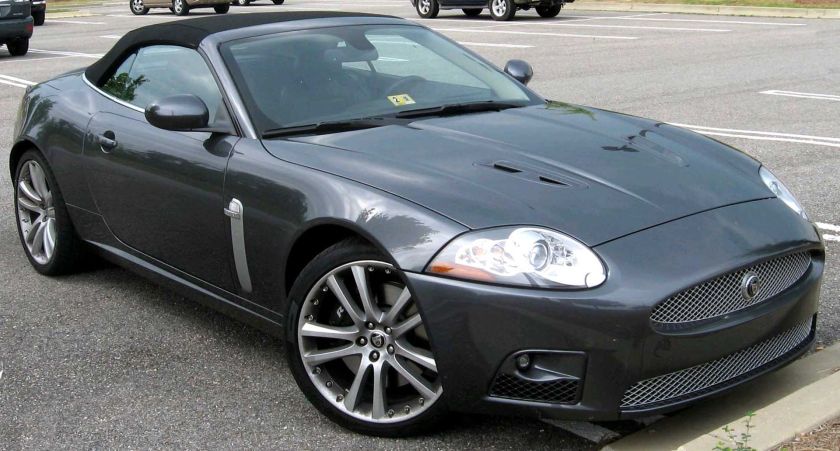 |
|
| Overview | |
| Manufacturer | Jaguar Cars |
| Also called | XK8, XK, XKR |
| Production | 1996–2014 |
| Model years | 1997-2015 |
| Assembly | Castle Bromwich Assembly,Birmingham, United Kingdom |
| Body and chassis | |
| Class | Grand tourer |
| Body style | 2-door coupé 2-door convertible |
| Layout | FR layout |
| Chronology | |
| Predecessor | Jaguar XJS |
The Jaguar XK series (XK, XK8 and XKR) is a series of grand tourer cars produced by British car maker Jaguar Cars since 1996. The series was introduced at the Geneva Motor Show on 5 March 1996, and the last car came off the production line on 23 July 2014. The first generation of the series, the XK8, replaced the XJS, and was available as a coupé and convertible. The XK8 was the first 8-cylinder vehicle produced by Jaguar since the Daimler 250, introducing the Jaguar AJ-V8 engine.
The second generation XK was launched in 2006 (as a model year 2007). The new XK introduced an aluminium monocoque bodyshell, and is available both as a two-door coupé and two-door cabriolet/convertible, with just the engine and associated mechanicals being carried forward.
XK8/XKR (1996–2006)
The XK8 was launched in 1996 to replace the XJ-S. Two body styles were produced – a coupé and a convertible. The car was the first in the Jaguar line-up to use Jaguar’s newly developed V8 engine – the AJ-V8. In 1998 the supercharged XKR was added to the range. However, both the XK8 and XKR are limited to a maximum top speed of 155.4 mph (250.1 km/h).
The XK8 came standard with 17-inch alloy wheels, while 18-inch (Standard on the XKR), 19-inch, and 20-inch wheels were available for the XK8 at an additional cost. Jaguar’s Adaptive Cruise Control is an optional feature available on both models. Both models came with all-leather interior, burl walnut trim, and side airbags.
XK/XKR (2007–2014)
The newly designed XK was unveiled in 2005 at the Frankfurt Motor Show in Germany. Jaguar’s chief designer Ian Callum (who was also responsible for working on the Aston Martin DB7 and Vanquish coupés) claimed that the inspiration for the shape of the new XK came from his admiration for British actress Kate Winslet‘s curves. The X150’s grille was also inspired from the famous 1961 Jaguar E-Type.
The standard XK model has an unlimited top speed of 158 mph whilst the XKR an unlimited top speed of 174 mph. An even faster variant, the XKR-S model was introduced at the Geneva Motor Show in 2012. The XKR-S gained an additional 40 horsepower over the XKR bringing the 0-60 mph time down to only 4.4 seconds and the top speed up to 300 km/h (186 mph) – making it the fastest Jaguar yet after the Jaguar XJ220. A convertible version of the XKR-S was released in 2012.
Production of the XK ceased in July 2014 without a replacement model.
- 2016(announced) F-Pace
Racing and competition
- 1950s C-Type
Jaguar C-Type
| Jaguar C-Type | |
|---|---|
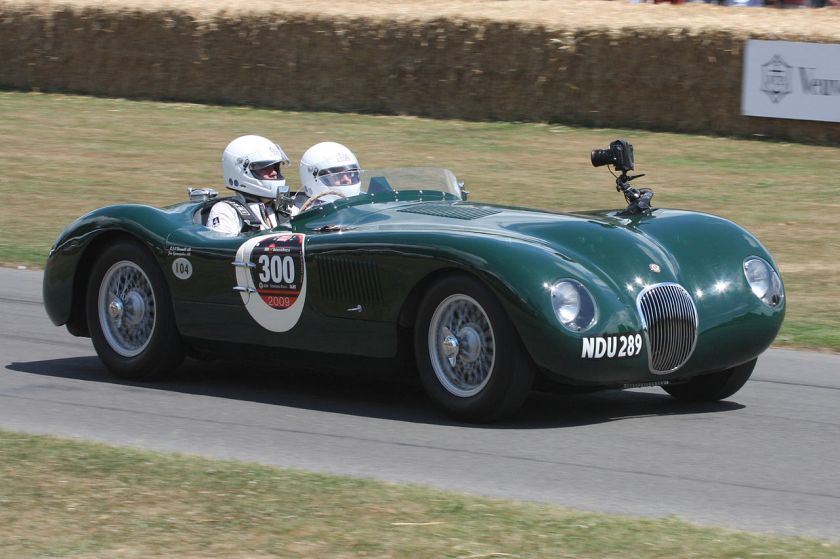 |
|
| Overview | |
| Manufacturer | Jaguar Cars |
| Production | 1951–1953 |
| Body and chassis | |
| Class | Competition–Sports car |
| Body style | Roadster |
| Chronology | |
| Successor | Jaguar D-type |
The Jaguar C-Type (also called the Jaguar XK120-C) is a racing sports car built by Jaguar and sold from 1951 to 1953. The “C” designation stood for “competition”.
The car used the running gear of the contemporary XK120 in a lightweight tubular frame and aerodynamic aluminium body. A total of 53 C-Types were built.
Specification
The road-going XK120’s 3.4-litre twin-cam, straight-6 engine produced between 160 and 180 bhp (134 kW). The version in the C-Type was originally tuned to around 205 bhp (153 kW). Later C-Types were more powerful, using triple twin-choke Weber carburettors and high-lift camshafts. They were also lighter, and from 1952 braking performance was improved by disc brakes on all four wheels. The lightweight, multi-tubular, triangulated frame was designed by Bob Knight. The aerodynamic body was designed by Malcolm Sayer. Made of aluminium in the barchetta style, it was devoid of road-going items such as carpets, weather equipment and exterior door handles.
Racing
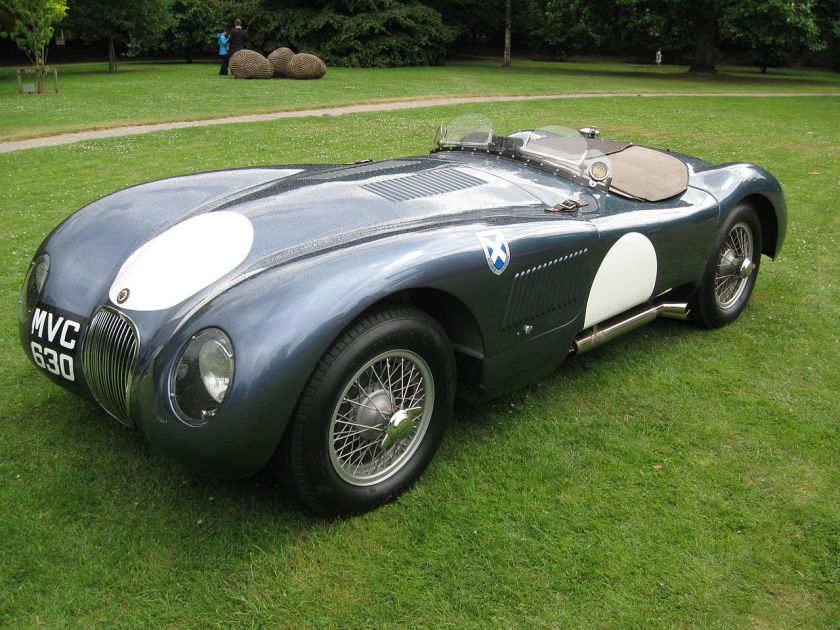
Jaguar C-Type in Ecurie Ecosse colours
The C-Type was successful in racing, most notably at the Le Mans 24 hours race, which it won twice.
In 1951 the car won at its first attempt. The factory entered three, whose driver pairings were Stirling Moss and Jack Fairman, Leslie Johnson and 3-times Mille Miglia winner Clemente Biondetti, and the eventual winners, Peter Walker and Peter Whitehead. The Walker/Whitehead car was the only factory entry to finish, the other two retiring with lack of oil pressure. A privately entered XK120, owned by Robert Lawrie, co-driven by Ivan Waller, also completed the race, finishing 11th.
In 1952 Jaguar, worried by a report about the speed of the Mercedes-Benz 300SLs that would run at Le Mans, modified the C-Type’s aerodynamics to increase the top speed. However, the consequent rearrangement of the cooling system made the car vulnerable to overheating. All three retired from the race. The Peter Whitehead/Ian Stewart and Tony Rolt/Duncan Hamilton cars blew head gaskets, and the Stirling Moss/Peter Walker car, the only one not overheating having had a full-sized radiator hurriedly fitted, lost oil pressure after a mechanical breakage. Later testing by Norman Dewis at MIRA after the race proved that it was not the body shape that caused the overheating but mainly the water pump pulley that was undersize, spun too fast, caused cavitation and thus the overheating. In addition the header tank was in front of the passenger-side bulkhead, far from the radiator, and the tubing used was 7/8 inch. When the tubing diameter was increased to 1 1/4 inch and the water pump pulley increased in diameter, the car ran without problem. What the body shape did do though was to create enormous tail lift, which caused the cars to squirrel their way down the Mulsanne (properly called the Hunaudières) straight at speeds over 120 mph (193 km/h). The chassis numbers of the cars were XKC 001, 002 and 011, the last existing today as a normal C-type, the others being dismantled at the factory.
In 1953 a C-Type won again. This time the body was in thinner, lighter aluminium and the original twin H8 sand cast SU carburettors were replaced by three DCO3 40mm Webers, which helped boost power to 220 bhp (164 kW). Philip Porter mentions additional changes:
Further weight was saved by using a rubber bag fuel tank … lighter electrical equipment and thinner gauge steel for some of the chassis tubes … [T]he most significant change to the cars was the [switch to] disc brakes.
Duncan Hamilton and Tony Rolt won the race at 105.85 mph (170.35 km/h) – the first time Le Mans had been won at an average of over 100 miles per hour (161 km/h). 1954, the C-Type’s final year at Le Mans, saw a fourth place by the Ecurie Francorchamps entry driven by Roger Laurent and Jacques Swaters.
Values
When new, the car sold for about $6,000, approximately twice the price of an XK120. In an article in the June 11, 2003 issue of Autocar magazine (“Slick Cat Jaguar”, p. 70) the value of a “genuine, healthy” C-Type is estimated as £400,000, and the value of the 1953 Le Mans winner is about £2 million; replicas are available from a variety of sources from £40,000. A C-Type once owned and raced by Phil Hill sold at an American auction in August 2009 for $2,530,000.
- 1950s D-Type
Jaguar D-Type
| Jaguar D-Type | |
|---|---|
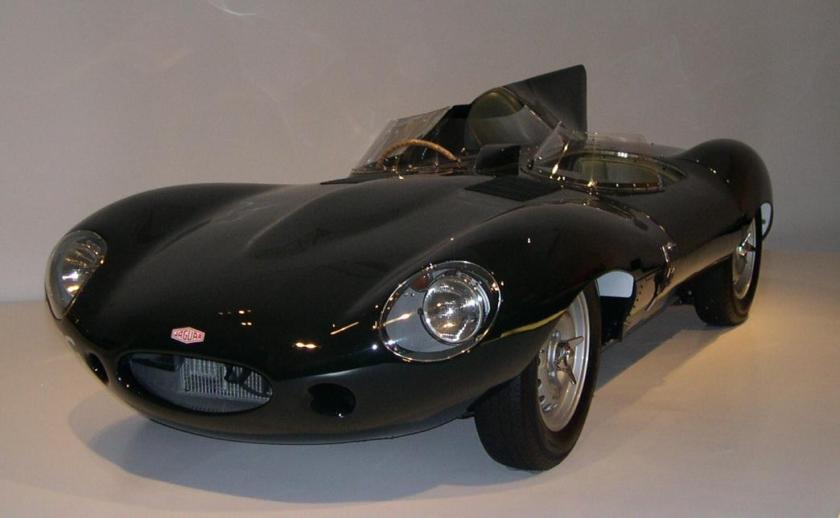
1955 Jaguar D-Type
|
|
| Overview | |
| Manufacturer | Jaguar Cars |
| Production | 1954–1957 |
| Body and chassis | |
| Class | Sports racing car |
| Body style | Roadster |
| Related | Jaguar XKSS |
| Chronology | |
| Predecessor | Jaguar C-Type |
| Successor | Jaguar E-Type |
The Jaguar D-Type is a sports racing car that was produced by Jaguar Cars Ltd. between 1954 and 1957. Although it shares many of its mechanical components with the C-Type, including the basic Straight-6 XKengine design (initially 3.4 litres and uprated to 3.8 litres in the late fifties), the structure of the car was radically different. The innovative monocoque construction brought aviation industry technology to competition car design, together with an aeronautical understanding of aerodynamic efficiency.
D-Types won the Le Mans 24-hour race in 1955, 1956 and 1957. After Jaguar temporarily retired from racing as a factory team, the company offered the remaining unfinished D-Types as XKSS versions whose extra road-going equipment made them eligible for production sports car races in America. In 1957 25 of these cars were in various stages of completion when a factory fire destroyed nine of them.
Total D-Type production is thought to have included 18 factory team cars, 53 customer cars, and 16 XKSS versions.
Design
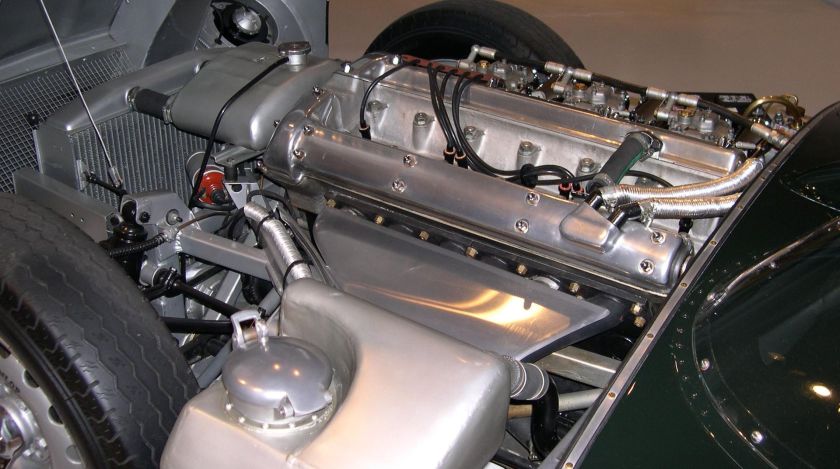
Double overhead cam 3.4 litre straight six cylinder XK6 engine
The structural design, revolutionary at the time, applied aeronautical technology. The “tub”, or cockpit section, was of monocoque construction, mostly comprising sheets of aluminium alloy. Its elliptical shape and comparatively small cross-section provided torsional rigidity and reduced drag. To the front bulkhead was attached an aluminium tubing subframe for the engine, steering assembly, and front suspension. Rear suspension and final drive were mounted to the rear bulkhead. Fuel was carried in the tail and the designers followed aviation practice by specifying a deformable Marston Aviation Division bag in place of a conventional tank.
The aerodynamic bodywork was largely the work of Malcolm Sayer, who had joined Jaguar following a stint with the Bristol Aeroplane Company during the Second World War and later worked on the C-Type. For the D-Type, he insisted on a minimal frontal area. To reduce the XK engine’s height, Jaguar’s Chief Engineer William Haynes and former Bentley engineer Walter Hassan developed dry sump lubrication, and it has been said that the car’s frontal area was also a consideration in canting the engine at 8½° from the vertical (which necessitated the offset bonnet bulge). Philip Porter, in his book Jaguar Sports Racing Cars, says that “[a] more likely reason was to provide extra space for the ram pipes feeding the three twin-choke Weber carburettors.” Reducing underbody drag contributed to the car’s high top speed; for the long Mulsanne Straight at Le Mans, a fin was mounted behind the driver for aerodynamic stability. For the 1955 season, factory cars were fitted with a longer nose, which lengthened the car by 7½ inches and further increased maximum speed; and the headrest fairing and aerodynamic fin were combined as a single unit that smoothed the aerodynamics and saved weight.
Mechanically, many features were shared with the outgoing C-Type. Its front and rear suspension and innovative all-round disc brakes were retained, as was the XK engine. Apart from the new lubrication system, the engine was further revised as development progressed during the D-Type’s competition life. Notably in 1955 larger valves were introduced, together with an asymmetrical cylinder head to accommodate them.
Elements of the body shape and many construction details were used in the Jaguar E-Type.
Competition history
D-Types fielded by a team under the leadership of Jaguar’s racing manager Lofty England were expected to perform well in their debut at the 1954 24 Hours of Le Mans race. In the event, the cars were hampered by fuel starvation caused by problems with the fuel filters, necessitating pit stops for their removal, after which the entry driven by Duncan Hamilton and Tony Rolt speeded up to finish less than a lap behind the winning Ferrari. The D-Type’s aerodynamic superiority is evident from its maximum speed of 172.8 mph on the Mulsanne Straight compared with the 4.9 litre Ferrari’s 160.1 mph.
For 1955 the cars were modified with long-nose bodywork and engines uprated with larger valves. At Le Mans, they proved competitive with the Mercedes-Benz 300 SLRs, which had been expected to win. Mike Hawthorn‘s D-Type had a narrow lead over Juan Manuel Fangio‘s Mercedes when another Mercedes team car was involved in the most catastrophic accident in motorsport history. Driver Pierre Levegh and more than 80 spectators lost their lives, while many more were injured.
Mercedes withdrew from the race. Jaguar opted to continue, and the D-Type driven by Hawthorn and Ivor Bueb went on to win.
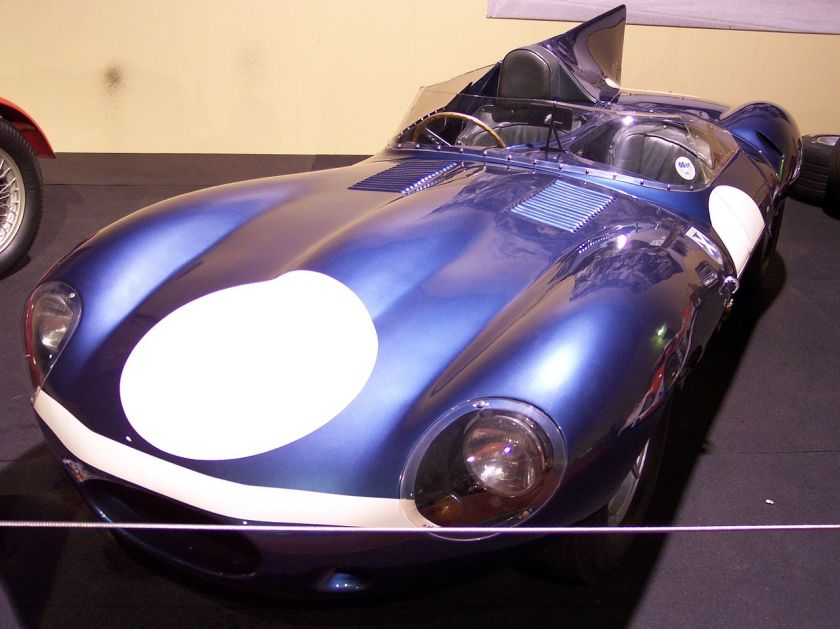
D-Type XKD606, winner of the 1957 Le Mans 24 Hours race, in Ecurie Ecosse metallic Flag Blue livery
Mercedes withdrew from motorsport at the end of the 1955 season, and Jaguar again entered Le Mans in 1956. Although only one of the three factory-entered cars finished, in 6th place, the race was won by a D-Type entered by the small Edinburgh-based team Ecurie Ecosse and driven by Ron Flockhart and Ninian Sanderson, beating works teams from Aston Martin and Scuderia Ferrari.
In America, the Cunningham team raced several D-Types. In 1955, for example, a 1954 works car on loan to Cunningham won the Sebring 12 Hours in the hands of Mike Hawthorn and Phil Walters, and in May 1956 the team’s entries for Maryland’s Cumberland national championship sports car race included four D-Types in Cunningham’s white and blue racing colors. Driven by John Fitch, John Gordon Benett, Sherwood Johnston and team owner Briggs Cunningham, they finished 4th, 5th, 7th and 8th respectively.
 |
|
| Problems playing this file? See media help. | |
Although Jaguar withdrew from motorsport at the end of the 1956 season, 1957 proved to be the D-Type’s most successful year. D-Types took five of the top six places at Le Mans;
Ecurie Ecosse, with considerable support from Jaguar, and a 3.8-litre engine, again took the win, and also second place. This was the best result in the D-Type’s racing history.
Rules for the 1958 Le Mans race limited engine size to 3 litres for sports racing cars, which ended the domination of the D-Type with its 3.8-litre XK engine. Jaguar developed a 3-litre version to power D-Types in the 1958, 1959 and 1960 Le Mans races but it was unreliable, and by 1960 it no longer produced sufficient power to be competitive.
The D-Type’s star waned as support from Jaguar decreased and the cars from rival manufacturers became more competitive. Although it continued to be one of the cars to beat in club racing and national events, the D-Type never again achieved a podium finish at Le Mans. By the early 1960s it was obsolete.
XKSS
After Jaguar temporarily retired from racing as a factory team in 1956, the company offered the remaining unfinished D-Types as XKSS versions whose additional road-going equipment—including a second seat, passenger-side door, side windows, full-width framed windscreen and windscreen wipers, trimmed interior, folding hood, and bumpers—made them eligible for production sports car races in America.
On the evening of 12 February 1957, a fire broke out at Jaguar’s Browns Lane plant and destroyed nine of the 25 cars that were in various stages of completion. With the requisite jigs and tooling also destroyed, this effectively ended production of the XKSS version, although Jaguar later converted two additional D-Types.
Value
The first factory production D-Type (XKD-509) was sold at Bonhams auction for £2,201,500 in July 2008. The previous highest confirmed price was £1,706,000, set in 1999.
- 1960s E-Type Lightweight
Jaguar E-Type
| Jaguar E-Type | |
|---|---|
 |
|
| Overview | |
| Manufacturer | Jaguar Cars |
| Also called | Jaguar XK-E |
| Production | 1961–752014 |
| Assembly | Coventry, England |
| Designer | Malcolm Sayer |
| Body and chassis | |
| Class | Sports car |
| Layout | FR layout |
| Related | Jaguar D-Type Jaguar XJ13 |
| Chronology | |
| Predecessor | Jaguar XK150 |
| Successor | Jaguar XJ-S Jaguar F-Type |
The Jaguar E-Type (a.k.a. Jaguar XK-E) is a British sports car, which was manufactured by Jaguar Cars Ltd between 1961 and 1975. Its combination of good looks, high performance and competitive pricing established the marque as an icon of 1960s motoring. More than 70,000 E-Types were sold.
In March 2008, the Jaguar E-Type ranked first in a The Daily Telegraph online list of the world’s “100 most beautiful cars” of all time.
In 2004, Sports Car International magazine placed the E-Type at number one on their list of Top Sports Cars of the 1960s.
Overview
The E-Type was initially designed and shown to the public as a rear-wheel drive grand tourer in two-seater coupé form (FHC or Fixed Head Coupé) and as a two-seater convertible (OTS or Open Two Seater). A “2+2” four-seater version of the coupé, with a lengthened wheelbase, was released several years later.
On its release Enzo Ferrari called it “The most beautiful car ever made”.
Later model updates of the E-Type were officially designated “Series 2” and “Series 3”, and over time the earlier cars have come to be referred to as “Series 1” and “Series 1½”.
Of the “Series 1” cars, Jaguar manufactured some limited-edition variants, inspired by motor racing :
- The “‘Lightweight’ E-Type” which was apparently intended as a sort of follow-up to the D-Type. Jaguar planned to produce 18 units but ultimately only a dozen were reportedly built. Of those, two have been converted to Low-Drag form and two others are known to have been wrecked and deemed to be beyond repair, although one has now been rebuilt. These are exceedingly rare and sought after by collectors.
- The “Low Drag Coupé” was a one-off technical exercise which was ultimately sold to a Jaguar racing driver. It is presently believed to be part of the private collection of the current Viscount Cowdray.
The New York City Museum of Modern Art recognised the significance of the E-Type’s design in 1996 by adding a blue roadster to its permanent design collection, one of only six automobiles to receive the distinction.
Concept versions
E1A (1957)
After the company’s success at the Le Mans 24 hr through the 1950s, Jaguar’s defunct racing department was given the brief to use D-Type style construction to build a road-going sports car, replacing the XK150.
The first prototype (E1A) featured a monocoque design, Jaguar’s fully independent rear suspension and the well proved “XK” engine. The car was used solely for factory testing and was never formally released to the public. The car was eventually scrapped by the factory.
E2A (1960)
Jaguar’s second E-Type concept was E2A which, unlike the E1A, was constructed from a steel chassis with an aluminium body. This car was completed as a racing car as it was thought by Jaguar at the time it would provide a better testing ground. E2A used a 3-litre version of the XK engine with a Lucas fuel injection system.
After retiring from the Le Mans 24 hr the car was shipped to America to be used for racing by Jaguar privateer Briggs Cunningham. In 1961, the car returned to Jaguar in England to be used as a test vehicle. Ownership of E2A passed to Roger Woodley (Jaguar’s customer competition car manager) who took possession on the basis the car not be used for racing. E2A had been scheduled to be scrapped. Roger’s wife Penny Griffiths owned E2A until 2008 when it was offered for sale at Bonham’s Quail Auction. It eventually sold for US$4,957,000.
Production versions
Series 1 (1961–68)
| Series I | |
|---|---|
 |
|
| Overview | |
| Production | March 1961–68 |
| Body and chassis | |
| Body style | 2-door coupe 2-door 2+2 coupe 2-door roadster |
| Powertrain | |
| Engine | 3.8 L XK I6 4.2 L XK I6 |
| Transmission | 4-speed manual; 3-speed automatic (automatic available 1966-onward, 2+2 model only) |
| Dimensions | |
| Wheelbase | 96.0 in (2,438 mm) (FHC / OTS) 105.0 in (2,667 mm) (2+2) |
| Length | 175.3125 in (4,453 mm) (FHC / OTS) 184.4375 in (4,685 mm) (2+2) |
| Width | 65.25 in (1,657 mm) (all) |
| Height | 48.125 in (1,222 mm) (FHC) 50.125 in (1,273 mm) (2+2) 46.5 in (1,181 mm) (OTS) |
| Kerb weight | 2,900 lb (1,315 kg) (FHC) 2,770 lb (1,256 kg) (OTS) 3,090 lb (1,402 kg) (2+2) |
The Series 1 was introduced, initially for export only, in March 1961. The domestic market launch came four months later in July 1961. The cars at this time used the triple SU carburetted 3.8 litre six-cylinder Jaguar XK6 engine from the XK150S. Earlier built cars utilised external bonnet latches which required a tool to open and had a flat floor design. These cars are rare and more valuable. After that, the floors were dished to provide more leg room and the twin bonnet latches moved to inside the car. The 3.8-litre engine was increased to 4.2 litres in October 1964.
The 4.2-litre engine produced the same power as the 3.8-litre (265 bhp;198 kW) and same top speed (150 mph;241 km/h), but increased torque from 240 to 283 lb·ft (325 to 384 N·m). Acceleration remained pretty much the same and 0 to 60 mph (0 to 97 km/h) times were around 7.0 seconds for both engines, but maximum power was now reached at 5,400rpm instead of 5,500rpm on the 3.8-litre. That all meant better throttle response for drivers that did not want to shift down gears.
Autocar road tested a UK spec E-Type 4.2 fixed head coupe in May 1965. The maximum speed was 153 mph (246 km/h), the 0–60 mph (0–97 km/h) time was 7.6 seconds and the 1⁄4 mile (402 m) from a standing start took 15.1 seconds. They summarised it as “In its 4.2 guise the E-type is a fast car ( the fastest we have ever tested) and offers just about the easiest way to travel quickly by road.”.
Motor magazine road tested a UK spec E-Type 4.2 fixed head coupe in Oct 1964. The maximum speed was 150 mph (241 km/h), the 0-60 mph time was 7 seconds and the 1⁄4 mile time was 14.9 seconds.They summarised it as “The new 4.2 supersedes the early 3.8 as the fastest car Motor has tested. The absurd ease which 100mph can be exceeded in a 1⁄4 mile never failed to astonish. 3,000 miles of testing confirms that this is still one of the worlds outstanding cars”.
All E-Types featured independent coil spring rear suspension with torsion bar front ends, and four wheel disc brakes, in-board at the rear, all were power-assisted. Jaguar was one of the first vehicle manufacturers to equip cars with disc brakes as standard from the XK150 in 1958. The Series 1 can be recognised by glass-covered headlights (up to 1967), small “mouth” opening at the front, signal lights and tail-lights above bumpers and exhaust tips under the number plate in the rear.
3.8-litre cars have leather-upholstered bucket seats, an aluminium-trimmed centre instrument panel and console (changed to vinyl and leather in 1963), and a Moss four-speed gearbox that lacks synchromesh for first gear (“Moss box”). 4.2-litre cars have more comfortable seats, improved brakes and electrical systems, and an all-synchromesh four-speed gearbox. 4.2-litre cars also have a badge on the boot proclaiming “Jaguar 4.2 Litre E-Type” (3.8 cars have a simple “Jaguar” badge). Optional extras included chrome spoked wheels and a detachable hard top for the OTS. When leaving the factory the car was originally fitted with Dunlop 6.40 × 15 inch RS5 tyres on 15 × 5K wire wheels (with the rear fitting 15 × 5K½ wheels supplied with 6.50 X15 Dunlop Racing R5 tyres in mind of competition). Later Series One cars were fitted with Dunlop 185 – 15 SP41 or 185 VR 15 Pirelli Cinturato as radial ply tyres.
A 2+2 version of the coupé was added in 1966. The 2+2 offered the option of an automatic transmission. The body is 9 in (229 mm) longer and the roof angles are different. The roadster and the non 2+2 FHC (Fixed Head Coupe) remained as two-seaters.
Less widely known, right at the end of Series 1 production and prior to the transitional “Series 1½” referred to below, a very small number 10 to 20 Series 1 cars were produced, with open headlights in the uk, these series one cars that had their head lights modified by removing the covers and altering the scoops they sit in, the headlights differ in several respects from the “production” Series 1½, the main being they are shorter at 143mm from the production Series 1½ at 160mm . Production dates on these machines vary but in right hand drive form production has been verified as late as March 1968. The low number of these cars produced make them amongst the rarest of all production E Types.
Following the Series 1 there was a transitional series of cars built in 1967–68, unofficially called “Series 1½”, which are externally similar to Series 1 cars. Due to American pressure the new features were open headlights, different switches, and some de-tuning (using two Zenith-Stromberg carburetters instead of the original three SUs) for US models. Some Series 1½ cars also have twin cooling fans and adjustable seat backs. Series 2 features were gradually introduced into the Series 1, creating the unofficial Series 1½ cars, but always with the Series 1 body style. A United States federal safety law affecting 1968 model year cars sold in the US was the reason for the lack of headlight covers and change in switch design in the “Series 1.5” of 1968. An often overlooked change, one that is often “modified back” to the older style, is the wheel knock-off “nut.” US safety law for 1968 models also forbid the winged-spinner knockoff, and any 1968 model year sold in the US should have a hexagonal knockoff nut, to be hammered on and off with the assistance of a special “socket” included with the car from the factory. This hexagonal nut carried on into the later Series 2 and 3.
An open 3.8-litre car, actually the first such production car to be completed, was tested by the British magazine The Motor in 1961 and had a top speed of 149.1 mph (240.0 km/h) and could accelerate from 0 to 60 mph (0 to 97 km/h) in 7.1 seconds. A fuel consumption of 21.3 miles per imperial gallon (13.3 L/100 km; 17.7 mpg-US) was recorded. The test car cost £2,097 including taxes.
The cars submitted for road test by the popular motoring journals of the time (1961)such as The Motor, The Autocar and Autosport magazines were specially prepared by the Jaguar works to give better-than-standard performance figures. This work entailed engine balancing and subtle work such as gas-flowing the cylinder heads and may even have involved fitting larger diameter inlet valves.
Both of the well-known 1961 road test cars: the E-type Coupe Reg. No. 9600 HP and E-type Convertible Reg.No. 77 RW, were fitted with Dunlop Racing Tyres on test, which had a larger rolling diameter and lower drag co-efficient. This goes some way to explaining the 150 mph (240 km/h) maximum speeds that were obtained under ideal test conditions. The maximum safe rev limit for standard 6-cylinder 3.8-litre E-type engines is 5,500 rpm. The later 4.2-Litre units had a red marking on the rev counter from just 5,000 rpm. The maximum safe engine speed is therefore 127 mph (3.31:1 axle) and 137 mph (3.07:1 axle) at the 5,500 rpm limit. Both test cars must have reached or exceeded 6,000 rpm in top gear when on road test in 1961.
Production numbers from Robson:
- 15,490 3.8s
- 17,320 4.2s
- 10,930 2+2s
Production numbers:
| FHC | OTS | 2+2 | Total | |
|---|---|---|---|---|
| S1 3.8 | 7,670 | 7,828 | 0 | 15,498 |
| S1 4.2 | 5,830 | 6,749 | 3,616 | 16,195 |
| S1.5 | 1,942 | 2,801 | 1,983 | 6,726 |
| TOTAL | 38,419 |
Series 2 (1968–71)
| Series II | |
|---|---|
 |
|
| Overview | |
| Production | 1968–71 |
| Body and chassis | |
| Body style | 2-door coupe 2-door 2+2 coupe 2-door roadster |
| Powertrain | |
| Engine | 4.2 L XK I6 |
| Dimensions | |
| Kerb weight | 3,018 lb (1,369 kg) (FHC) 2,750 lb (1,247 kg) (OTS) 3,090 lb (1,402 kg) (2+2) |
The Series 2 introduced a number of design changes, largely due to U.S. design legislation. The most distinctive feature is the absence of the aerodynamic glass headlight covers, which impacted several other imported cars, like the Citroën DS, as well. Unlike other cars, this retrograde step was applied worldwide for the E-Type, not just to Americans living under the authority of the National Highway Traffic and Safety Administration.
Other hallmarks of Series 2 cars are a wrap-around rear bumper, re-positioned and larger front indicators and tail lights below the bumpers, better cooling aided by an enlarged “mouth” and twin electric fans, and uprated brakes.
A combination steering lock and ignition key was fitted to the steering column, which replaced the dash board mounted ignition switch and charismatic push button starter. A new steering column was fitted with a collapsible section in the event of an accident.
New seats were fitted which allowed the fitment of head restraints, as required by U.S. law beginning in 1969. The interior and dashboard were also redesigned; rocker switches that met US health and safety regulations were substituted for toggle switches. The dashboard switches also lost their symmetrical layout.
The engine is easily identified visually by the change from smooth polished cam covers to a more industrial “ribbed” appearance. It was de-tuned in the US with twin Strombergs and larger valve clearances, but in the UK retained triple SUs and the much tighter valve clearances. (Late Series 1½ cars also had ribbed cam covers). This detuned engine produced 245 hp (183 kW), a drop of 20hp.
Air conditioning and power steering were available as factory options.
Production according to Robson is 13,490 of all types.
Series 2 production numbers:
| FHC | OTS | 2+2 | TOTAL | |
|---|---|---|---|---|
| S2 | 4,855 | 8,628 | 5,326 | 18,809 |
Official delivery numbers by market and year are listed in Porter but no summary totals are given.
Series 3 (1971–75)
| Series III | |
|---|---|
 |
|
| Overview | |
| Production | 1971–75 |
| Body and chassis | |
| Body style | 2-door 2+2 coupe 2-door roadster |
| Powertrain | |
| Engine | 5.3 L Jaguar V12 engine |
| Dimensions | |
| Wheelbase | 105 in (2,667 mm) (both) |
| Length | 184.4 in (4,684 mm) (2+2) 184.5 in (4,686 mm) (OTS) |
| Width | 66.0 in (1,676 mm) (2+2) 66.1 in (1,679 mm) (OTS) |
| Height | 48.9 in (1,242 mm) (2+2) 48.1 in (1,222 mm) (OTS) |
| Kerb weight | 3,361 lb (1,525 kg) (2+2) 3,380 lb (1,533 kg) (OTS) |
A new 5.3 L twelve-cylinder Jaguar V12 engine was introduced, with uprated brakes and standard power steering. The short wheelbase FHC body style was discontinued and the V12 was available only as a convertible and 2+2 coupé. The convertible used the longer-wheelbase 2+2 floorplan. The Series 3 is easily identifiable by the large cross-slatted front grille and flared wheel arches, and a badge on the rear that proclaims it to be a V12. Cars for the US market were fitted with large projecting rubber bumper over-riders (in 1973 these were on front, in 1974 both front and rear) to meet local 5 mph (8 km/h) impact regulations, but those on European models were considerably smaller. US models also have side indicator repeats on the front wings. There were also a very limited number of six-cylinder Series 3 E-Types built. These were featured in the initial sales literature. When leaving the factory the V12 Open Two Seater and V12 2 ± 2 originally fitted Dunlop E70VR − 15 inch tyres on 15 × 6K wire or solid wheels.
Robson lists production at 15,290.
Series 3 production numbers:
| FHC | OTS | 2+2 | TOTAL | |
|---|---|---|---|---|
| S3 | 0 | 7,990 | 7,297 | 15,287 |
Limited editions
Two limited production E-Type variants were made as test beds, the Low Drag Coupe and Lightweight E-Type, both of which were raced:
Low Drag Coupé (1962)
Shortly after the introduction of the E-Type, Jaguar management wanted to investigate the possibility of building a car more in the spirit of the D-Type racer from which elements of the E-Type’s styling and design were derived. One car was built to test the concept designed as a coupé as its monocoque design could only be made rigid enough for racing by using the “stressed skin” principle. Previous Jaguar racers were built as open-top cars, because they were based on ladder frame designs with independent chassis and bodies. Unlike the steel production E-Types, the LDC used lightweight aluminium. Malcolm Sayer retained the original tub with lighter outer panels riveted and glued to it. The front steel sub frame remained intact, the windshield was given a more pronounced slope, and the rear hatch was welded shut. Rear brake cooling ducts appeared next to the rear windows, and the interior trim was discarded, with only insulation around the transmission tunnel. With the exception of the windscreen, all cockpit glass was perspex. A tuned version of Jaguar’s 3.8-litre engine with a wide-angle cylinder head design tested on the D-Type racers was used. Air management became a problem and, though a higher performing vehicle than its production counterpart, the car was never competitive.
The only test bed car was completed in summer of 1962 but was sold a year later to Jaguar racing driver Sledge hammer Protheroe. Since then it has passed through the hands of several collectors on both sides of the Atlantic and is now believed to reside in the private collection of the current Viscount Cowdray.
Lightweight E-Type (1963–64, 2014)
Twelve cars plus two spare bodies were made by Jaguar.
In some ways, this was an evolution of the Low Drag Coupé. It made extensive use of aluminium alloy in the body panels and other components. However, with at least one exception, it remained an open-top car in the spirit of the D-Type to which this car is a more direct successor than the production E-Type which is more of a GT than a sports car. The cars used an aluminium block tuned version of the production 3.8-litre Jaguar engine with 300 bhp (224 kW) output rather than the 265 bhp (198 kW) produced by the “ordinary” version. Factory-built lightweights were homologated by Jaguar with three 45DCO3 Weber carburettors in addition to a Lucas mechanical fuel injection system. Early cars were fitted with a close-ratio version of the four-speed E-type gearbox, with some later cars being fitted with a ZF 5-speed gearbox.
The cars were entered in various races but, unlike the C-Type and D-Type racing cars, they did not win at Le Mans or Sebring but were reasonably successful in private hands and in smaller races.
One Lightweight was modified into a Low-Drag Coupé (the Lindner/Nocker car), by Malcolm Sayer.
Another Lightweight was modified into a unique Low-Drag design (the Lumsden/Sargent car), by Dr Samir Klat of Imperial College. Along with the factory LDC, this lightweight is now believed to reside in the private collection of the current Viscount Cowdray.
Many were fitted with more powerful engines as developments occurred.
On 14 May 2014, Jaguar’s Heritage Business announced it will be building the six ‘remaining’ Lightweights. The original run of Lightweights was meant to be 18 vehicles; however only 12 were built. The new cars, using the un-used chassis codes, will be hand-built to exactly the same specification as the originals. Availability will be prioritised for established collectors of Jaguars, with a focus on those who have an interest in historic race cars.
Motorsport
Bob Jane won the 1963 Australian GT Championship at the wheel of a “lightweight” E-Type.
The Jaguar E-Type was very successful in SCCA Production sports car racing with Group44 and Bob Tullius taking the B-Production championship with a Series-3 V12 racer in 1975. A few years later, Gran-Turismo Jaguar from Cleveland Ohio campaigned a 4.2-litre six-cylinder FHC racer in SCCA production series, and in 1980 won the National Championship in the SCCA C-Production Class, defeating a fully funded factory Nissan Z-car team with Paul Newman.
- 1985–1992 XJR-5 through XJR-17
Jaguar XJR Sportscars
Several XJRs seen in their traditional European Silk Cut paint scheme.
The Jaguar XJR Sportscars were a series of race cars used by Jaguar-backed teams in both the World Sportscar Championship (WSC) Group C and the IMSA Camel GTP series between 1984 and 1993.
History

A Jaguar XJR-5 at Sears Point in 1983.
Starting in 1983, the project was started by an American team Group 44 Racing, headed up by owner/driver Bob Tullius, who had the backing of Jaguar to build the Fabcar designed racer known as XJR-5 in their Herndon, Virginia, USA shop and to campaign it in the IMSA Camel GTP championship. After becoming established in IMSA, Jaguar turned to Tom Walkinshaw Racing (TWR) to develop another car known as XJR-6 for the World Sportscar Championship, using the same Jaguar V12, and debuting halfway into the 1985 season.
Jaguar would continue to use two different types of chassis for IMSA and WSC until 1988 when Jaguar chose to have TWR take over their team for both championships, and building an identical car for both series, known as the XJR-9.
After having used the V12 in varying sizes, TWR decided to try a new turbocharged 3.5L V6 for the XJR-10 (for IMSA) and XJR-11 (for WSC) in the 1989 season. However, the FIA announced rule changes to come into effect for the World Sportscar Championship that would require all teams to change to 3.5L naturally aspirated engines. TWR decided that continuing to develop their V6 in WSC was useless, so the new XJR-12 for WSC in 1990 was better suited to carry the old but reliable V12. The XJR-12 was short lived as in 1991, Jaguar decided to debut their new 3.5L naturally aspirated V8 engine by Cosworth for the XJR-14.
After having won multiple championships in WSC, and instability due to multiple rule changes, Jaguar decided to drop out following the 1991 season and concentrate on IMSA. However, after attempting the first few races of the 1993 season, Jaguar decided to end the project altogether, marking the end of the XJR sportscars. Jaguar and TWR attempted to continue racing on with a cheaper and smaller scale project, a racing version of the XJ220 for the GT classes, but it was short lived.
One unique XJR model was the 1990 XJR-15, which was a limited edition road legal supercar built by TWR from the design of the XJR-9 and featuring Jaguar’s V12. Several XJR-15s were also built into racing cars for a special one-make series meant as a support race for Formula One.
Jaguar XJRs
- 2009 XFR Bonneville Salt Flats speed record
- 2010 Jaguar RSR XKR GT2
Concept models
- E1A — The 1950s E-Type concept vehicle
- E2 A — The second E-Type concept vehicle, which raced at LeMans and in the USA
- Pirana (1967) — Designed by Bertone
- XJ13 (1966) — Built to race at LeMans, never run
- XK 180 (1998) — Roadster concept based on the XK8
- F-Type (2000) — Roadster, similar to the XK8 but smaller
- R-Coupé (2001) — Large four-seater coupé
- Fuore XF 10 (2003)
- R-D6 (2003) — Compact four-seat coupé
- XK-RR — A high-performance version of last generation XK coupé
- XK-RS — Another performance-spec version of last generation XK convertible
- Concept Eight (2004) — Super-luxury version of the long-wheelbase model of the XJ
- C-XF (2007) — Precursor to the production model XF saloon
- C-X75 (2010) — Hybrid-electric sports car, originally intended for production but cancelled in 2012
- C-X16 (2011) — Precursor to the production model F-Type
- C-X17 (2013) — First ever Jaguar SUV concept
- Project 7 — a 542 bhp V8-powered speedster based on the F-Type and inspired by the D-Type (2013)
Engines
Jaguar has designed in-house four generations of engines.
- Historical engines:
- Current engines:
- Jaguar AJ-V8 engine—V8 (fourth generation Jaguar engine)
- Jaguar AJ-V6 engine—V6 (a variation of a Ford engine)
- Jaguar AJD-V6 engine—V6 (diesel engine designed by Ford)
Motorsport
- See also: Jaguar Racing and Jaguar XJR Sportscars
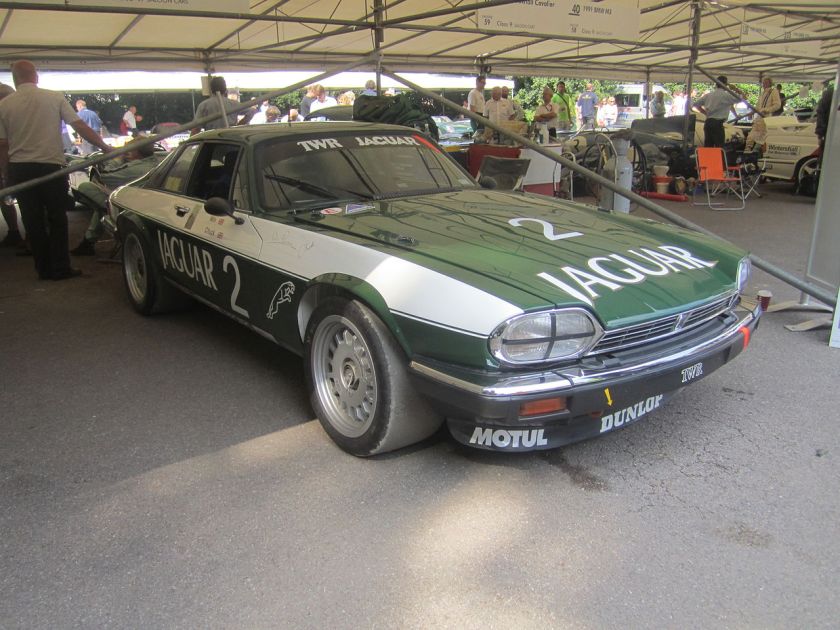
Jaguar XJ-S won the 1984 European Touring Car Championship
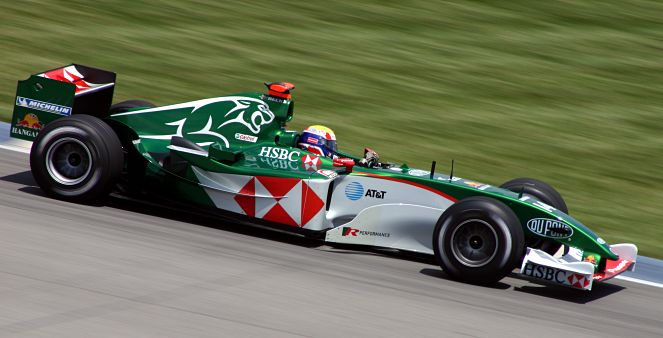
The Jaguar R5 being driven by Mark Webber in 2004—the team’s last season in F1
The company has had major success in sports car racing, particularly in the Le Mans 24 Hours. Victories came in 1951 and 1953 with the C-Type, then in 1955, 1956 and 1957 with the D-Type. The manager of the racing team during this period, Lofty England, later became CEO of Jaguar in the early 1970s. Although the prototype XJ13 was built in the mid-1960s it was never raced, and the famous race was then left for many years.
In 1982, a successful relationship with Tom Walkinshaw‘s TWR team commenced with the XJ-S competing in the European Touring Car Championship, which it won in 1984. In 1985, the TWR XJ-S won the Bathurst 1000race. In the mid-1980s TWR started designing and preparing Jaguar V12-engined Group C cars for World Sports Prototype Championship races. The team started winning regularly from 1987, and won Le Mans in 1988 and 1990 with the XJR series sports cars. The Jaguar XJR-14 was the last of the XJRs to win, taking the 1991 World Sportscar Championship.
In the 1999, Ford decided that Jaguar would be the corporation’s Formula One entry. Ford bought out the Milton Keynes-based Stewart Grand Prix team and rebranded it as Jaguar Racing for the 2000 season. The Jaguar F1 program was not a success however, achieving only two podium finishes in five seasons of competition between 2000 and 2004. At the end of 2004, with costs mounting and Ford’s profits dwindling, the F1 team was seen as an unneeded expense and was sold to Red Bull energy drinks owner Dietrich Mateschitz, and it became Red Bull Racing. Since 2004 Jaguar has not had an official presence in motorsport.
Notable Jaguar sports racers:
- Jaguar C-Type (1951–1953)
- Jaguar D-Type (1954–1957)
- Jaguar Lightweight E-Type
- Jaguar XJ13
- Jaguar XJR Sportscars
- Jaguar XJR-9 (1988)
- XJ220 (1988)
- XJR-15 (1990)
Electric vehicles
Lotus Cars joined Jaguar, MIRA Ltd and Caparo on a luxury hybrid executive sedan project called “Limo-Green”—funded by the UK Government Technology Strategy Board. The vehicle will be a series plug-in hybrid.
Facilities
Jaguar Land Rover operations are split between several sites, most of which are used for work on both the Jaguar and Land Rover brands.
Current plants
- Whitley Engineering Centre – Jaguar Land Rover’s headquarters and a research and development centre. The older part of this plant was acquired from Peugeot in the 1980s, and was formerly a First World War airfield, an aircraft factory and then a missile factory before being sold to the Rootes Group (later Chrysler Europe).
- Gaydon Engineering Centre – Jaguar Land Rover’s other research and development centre. Formerly an RAF bomber base before being acquired by British Leyland and redeveloped as a vehicle design, development and testing centre. Part of this site is also the Aston Martin headquarters, development centre and factory.
- Castle Bromwich – Jaguar Land Rover’s main Jaguar assembly plant, producing the XF, XJ, XK and F-Type ranges. Originally an aircraft factory during World War Two – Spitfires were built there, it was later acquired by Pressed Steel Fisher and became a vehicle body assembly works, it came under the auspices of Jaguar through the merger with BMC in the 1960s.
- Solihull – Jaguar Land Rover’s principal Land Rover assembly plant. This was originally an aircraft engine plant during World War Two, being used for as a Rover plant after the war. The Jaguar XE will become the first Jaguar car to be assembled at the facility in late 2014, followed by the Jaguar F-Pace crossover from 2016.
- Halewood, Merseyside – Now used by Jaguar Land Rover for Land Rover production. Originally a Ford assembly plant (the Ford Escort being its most prolific model) it was given to Jaguar in 2000 for production of the X-Type. Ford still owns the transmission manufacturing operation at Halewood.
- Wolverhampton Engine Plant – a new £500 million facility located at the i54 site in Staffordshire close to Wolverhampton to build the new Ingenium family of modular diesel and petrol engines. The plant was officially opened by Her Majesty Queen Elizabeth II on Thursday, October 30, 2014.
Future plants
- Ryton-on-Dunsmore – Jaguar Land Rover announced that it will build a new Special Vehicle Operations development centre there in 2016. The site was previously used by Rootes for aircraft production plant for World War Two, and later became the Rootes/Chrysler/Peugeot car plant which was closed in 2006 and has since been completely demolished and the site cleared.
Past Jaguar plants
- Holbrooks Lane, Coventry – by the time Swallow Sidecar Company started using the Jaguar name, they had relocated from Blackpool to Holbrooks Lane in Coventry.
- Browns Lane – The most well-known site for Jaguar production from 1951, it was progressively run down and replaced by Castle Bromwich. Most of the plant has now been demolished and is now the home of Jaguar Land Rover’s heritage centre.
- Radford – originally a Daimler bus plant but was later a Jaguar engine and axle plant. Closed by Ford in 1997 when it moved all Jaguar engine production to its Bridgend facility.
Jaguar and the arts
For some time now Jaguar has been active in the international arts scene. In particular, the company has collaborated with the artist Stefan Szczesny, implementing major art projects. In 2011, Jaguar presented the exhibition series “Shadows”, which involved the installation of Szczesny’s shadow sculptures in Sankt-Moritz, on Sylt and in Saint-Tropez. In 2012, a large number of sculptures, ceramics and paintings were shown in Frankfurt (and mainly in Frankfurt’s Palmengarten).
As part of the collaboration with Szczesny, Jaguar has released the “Jaguar Art Collection”.
